Alvarion Technologies EAP-10AMP Low Power Transceiver and Amplifier Unit User Manual bnpro 17nov
Alvarion Ltd. Low Power Transceiver and Amplifier Unit bnpro 17nov
Contents
- 1. manual 1
- 2. manual 2
- 3. revised users manual
- 4. manual
manual 1
BreezeNET PRO.11 Series
User’s Guide
November, 1998
Cat. No. 213033
Revision 0
© 1998 by BreezeCOM Ltd. All rights reserved.
No part of this publication may be reproduced in any material form without the
written permission of the copyright owner.
Trade Names
BreezeNET and BreezeLINK are trade names of
BreezeCOM Ltd. Other brand and product names are registered trademarks or
trademarks of their respective companies.
Statement of Conditions
The information contained in this manual is subject to change without notice. BreezeCOM Ltd. shall not be
liable for errors contained herein or for incidental or consequential damages in connection with the
furnishing, performance, or use of this manual or equipment supplied with it.
Warranty
In the following warranty text, “the Company” shall mean:
- BreezeCOM Inc., for products located in the USA.
- BreezeCOM Ltd., for products located outside the USA.
This BreezeNET product is warranted against defects in material and workmanship for a period of one year.
During this warranty period the Company will, at its option, either repair or replace products that prove to be
defective.
For warranty service or repair, the product must be returned to a service facility designated by the Company.
Authorization to return products must be obtained prior to shipment. The buyer shall pay all shipping charges
to the Company and the Company shall pay shipping charges to return the product to the buyer.
The Company warrants that the firmware designed by it for use with the unit will execute its programming
instructions when properly installed on the unit. The Company does not warrant that the operation of the unit
or firmware will be uninterrupted or error-free.
Limitation of Warranty
The foregoing warranty shall not apply to defects resulting from improper or inadequate maintenance by the
buyer, buyer supplied interfacing, unauthorized modification or misuse, operation outside of the
environmental specifications for the product, or improper site preparation or maintenance. No other warranty
is expressed or implied. The Company specifically disclaims the implied warranties of merchantability and
fitness for any particular purpose.
Electronic Emission Notices
This device complies with Part 15 of the FCC rules, ETSI 300-328, UL, UL/C, TUV/GS, and CE.
Operation is subject to the following two conditions:
1. This device may not cause harmful interference.
2. This device must accept any interference received, including interference that may cause undesired
operation.
FCC Radio Frequency Interference Statement
This equipment has been tested and found to comply with the limits for a class A digital device, pursuant to
Part 15 of the FCC rules. These limits are designed to provide reasonable protection against harmful
interference when the equipment is operated in a commercial environment. This equipment generates, uses,
and can radiate radio frequency energy and, if not installed and used in accordance with the instruction
manual, may cause harmful interference to radio communications. Operation of this equipment in a
residential area is likely to cause harmful interference in which case the user will be required to correct the
interference at his own expense.
Information to User
Any changes or modifications of equipment not expressly approved by the manufacturer could void the user’s
authority to operate the equipment and the company’s warranty.
CONTACTING BREEZECOM TECHNICAL
SUPPORT
Should you need assistance beyond the scope of this guide, please contact
your local BreezeCOM reseller or distributor. If they cannot solve your
problem, feel free to contact the BreezeCOM Technical Support
Depatrment. The support representatives can assist you in solving any
problems that cannot be solved by your reseller.
When requesting support, please have the following items available:
• Configuration of the system, including models of the BreezeCOM
equipment used.
• Antenna type and cable lengths.
• Site information such as possible radio path problems (like trees,
machines, and buildings).
• Distance between devices.
• Configuration, statistic counters, and error messages as seen on the
monitor.
• Description of problems encountered.
To contact BreezeCOM Technical Support, refer to the Technical Support
page of the BreezeCOM website: www.breezecom.com

Table of Contents
BreezeNET PRO.11 Series iUser’s Guide
TABLE OF CONTENTS
1. Introduction To The BreezeNET PRO.11 Series.......................................1-1
1.1. How to Use This Guide..........................................................................1-1
1.2. BreezeNET PRO.11 Series Features ......................................................1-2
1.3. BreezeNET PRO.11 Series Product Line ...............................................1-3
1.3.1. Access Point...............................................................................1-4
1.3.2. Single Station Adapter................................................................1-5
1.3.3. Four Port Station Adapter...........................................................1-6
1.3.4. Workgroup Bridge......................................................................1-8
1.3.5. PC Card......................................................................................1-9
1.3.6. Extended Range Access Point and Bridge.................................1-10
1.4. BreezeNET PRO.11 Functional Description ........................................1-11
2. Basic Installation ........................................................................................2-1
2.1. Basic Installation Checklist....................................................................2-1
2.2. Check the Package List..........................................................................2-1
2.3. Position the Unit....................................................................................2-2
2.3.1. Additional Considerations When Positioning the Access Point...2-3
2.4. Connect the Unit to the Power Supply....................................................2-3
2.5. Connect the Unit to the Ethernet Port.....................................................2-4
2.6. Check Unit Functionality using LED indicators.....................................2-5
2.6.1. Station (SA-10, SA-40) and Bridge (WB-10) LEDs....................2-5
2.6.2. Access Point LEDs.....................................................................2-6
2.6.3. Verifying the Ethernet Connection .............................................2-6
3. Device Setup and Management..................................................................3-1
3.1. Accessing and Using Local Terminal Management................................3-1
3.2. Configuration Screens............................................................................3-2
3.3. Main Menu............................................................................................3-3
3.4. System Configuration Menu ..................................................................3-4
3.4.1. Station Status .............................................................................3-4
3.4.2. IP and SNMP Parameters ...........................................................3-5
3.4.3. Wireless LAN (WLAN) Parameters ...........................................3-6
3.4.4. Bridging...................................................................................3-10
3.4.5. Station Control .........................................................................3-11
3.5. Advanced Settings Menu .....................................................................3-12
3.5.1. Performance .............................................................................3-13
3.5.2. Radio........................................................................................3-13
3.5.3. Rate..........................................................................................3-13
3.5.4. Maintenance.............................................................................3-14

Table of Contents
BreezeNET PRO.11 Series ii User’s Guide
3.6. Site Survey Menu ................................................................................3-14
3.6.1. System Counters.......................................................................3-15
3.6.2. Survey Software.......................................................................3-18
3.6.3. Using the Site Survey Software ................................................3-19
3.6.4. Using the Rx Packets per Frequency Histogram........................3-22
3.7. Access Control Menu...........................................................................3-23
4. SA-PCR PRO.11 PC Card Installation, Setup, and Management ...........4-1
4.1. Installing the SA-PCR Driver, and Applications ....................................4-1
4.1.1. Check Package Contents ............................................................4-1
4.1.2. Before You Begin.......................................................................4-2
4.1.3. Installing SA-PCR Drivers .........................................................4-2
4.1.4. Checking the LED Indicators .....................................................4-9
4.1.5. Installing the Applications..........................................................4-9
4.1.6. Initial Configuration...................................................................4-9
4.1.7. Troubleshooting Tips................................................................4-10
4.1.8. Uninstalling SA-PCR Drivers and Applications........................4-11
4.2. Using the SA-PCR Configuration Application .....................................4-12
4.2.1. Accessing the Application ........................................................4-12
4.2.2. Main Window ..........................................................................4-12
4.2.3. Resetting the PC Card ..............................................................4-12
4.2.4. Station Status Tab.....................................................................4-13
4.2.5. WLAN Parameters Tab ............................................................4-14
4.2.6. Station Control Tab ..................................................................4-16
4.2.7. Access Rights Tab....................................................................4-17
4.2.8. Power Management Tab...........................................................4-19
4.2.9. Maintenance Tab......................................................................4-20
4.2.10. Radio Tab.................................................................................4-21
4.2.11. Performance Tab ......................................................................4-22
4.3. Using the SA-PCR Site Survey Application.........................................4-23
4.3.1. Accessing the SA-PCR Site Survey Application.......................4-24
4.3.2. SA-PCR Site Survey Main Window .........................................4-24
4.3.3. Performing a Site Survey with the SA-PCR..............................4-27
5. Planning and Installing Wireless LANs....................................................5-1
5.1. System Configurations...........................................................................5-1
5.1.1. Single Cell Configuration...........................................................5-2
5.1.2. Overlapping Cell Configuration..................................................5-6
5.1.3. Multicell Configuration ..............................................................5-8
5.1.4. Multi-hop Configuration (Relay) ..............................................5-10
5.2. Indoor Installation considerations ........................................................5-12

Table of Contents
BreezeNET PRO.11 Series iii User’s Guide
5.2.1. Site Selection Factors...............................................................5-12
5.2.2. Antennas for Indoor applications..............................................5-14
5.2.3. Construction Materials .............................................................5-15
5.2.4. Cell Size...................................................................................5-15
5.3. Outdoor Installation Considerations.....................................................5-16
5.3.1. Site Selection Factors...............................................................5-16
5.3.2. Rooftop Installation..................................................................5-18
5.3.3. Antennas for Outdoor Applications ..........................................5-18
5.3.4. Antenna Seal ............................................................................5-20
5.3.5. Cell Size...................................................................................5-20
5.3.6. Link Distance...........................................................................5-21
5.3.7. Using Outdoor Range Tables....................................................5-21
5.3.8. FCC Outdoor Range Tables (USA) ..........................................5-22
5.3.9. ETSI Outdoor Range Tables (Europe and Rest-of-World) –
D Models .................................................................................5-23
5.3.10. ETSI Outdoor Range Tables (Europe and Rest-of-World) –
DE Models...............................................................................5-24
5.3.11. Non-Regulated Outdoor Range Tables – D Models ..................5-26
5.3.12. Extending the range using the TPA-24 and LNA-10.................5-27
5.4. Available Antennas and Antenna Kits..................................................5-31
5.5. Precautions ..........................................................................................5-32
5.5.1. Professional Installers Only ......................................................5-32
5.5.2. Transmit Antenna Gain.............................................................5-32
5.5.3. Spurious Radio Frequency Emissions.......................................5-33
5.5.4. Lightning Protection.................................................................5-33
5.5.5. Rain Proofing...........................................................................5-34
6. Accessory Installation.................................................................................6-1
6.1. TPA 24 Transmit Power Amplifier (Booster).........................................6-1
6.1.1. Installing the TPA 24 .................................................................6-2
6.2. LNA 10 Low Noise Receive Amplifier..................................................6-3
6.2.1. Installing the LNA 10.................................................................6-3
6.3. RFS 122 Radio Frequency Splitter.........................................................6-5
6.3.1. Installing the RFS 122................................................................6-5
6.4. AL 1 Lightning Arrestor........................................................................6-5
7. Upgrade Procedure.....................................................................................7-1
8. System Troubleshooting.............................................................................8-1
8.1. Troubleshooting Guide ..........................................................................8-1
8.2. Checking Counters ................................................................................8-3
8.2.1. WLAN Counters ........................................................................8-3

Table of Contents
BreezeNET PRO.11 Series iv User’s Guide
8.2.2. Ethernet Counters.......................................................................8-3
9. Appendix 9-1
9.1. Supported MIBs and Traps ....................................................................9-1
9.1.1. Supported MIBs .........................................................................9-1
9.1.2. Supported Traps .........................................................................9-2
9.2. Technical Specifications ........................................................................9-3
9.2.1. Specifications for BreezeNET PRO.11 Units..............................9-3
9.2.2. Specifications for TPA 24 Transmit Power Amplifier.................9-6
9.2.3. Specifications for LNA 10 Low Noise Receive Amplifier ..........9-7
9.2.4. Specifications for RFS 122 Radio Frequency Splitter .................9-8
9.2.5. Specifications for AL 1 Lightning Arrestor.................................9-8
9.3. Wireless LAN Concepts ........................................................................9-9
9.4. Radio Signal Propagation.....................................................................9-15
9.4.1. Introduction..............................................................................9-15
9.4.2. RF Terms and Definitions.........................................................9-15
9.5. IEEE 802.11 Technical Tutorial...........................................................9-22
9.5.1. Architecture Components.........................................................9-22
9.5.2. IEEE 802.11 Layers Description...............................................9-23
9.5.3. The MAC Layer .......................................................................9-24
9.5.4. How Does a Station Join an Existing Cell (BSS)?.....................9-30
9.5.5. Roaming...................................................................................9-30
9.5.6. Keeping Synchronization..........................................................9-31
9.5.7. Security....................................................................................9-31
9.5.8. Power Saving ...........................................................................9-32
9.5.9. Frame Types.............................................................................9-33
9.5.10. Frame Formats .........................................................................9-33
9.5.11. Most Common Frame Formats .................................................9-38
9.5.12. Point Coordination Function (PCF) ..........................................9-40
9.5.13. Ad-hoc Networks .....................................................................9-40

Introduction To The BreezeNET PRO.11 Series
BreezeNET PRO.11 Series 1-1User’s Guide
1. INTRODUCTION TO THE BREEZENET
PRO.11 SERIES
This chapter explains how to use this guide, presents the members of the
BreezeNET PRO.11 Series, describes the benefits of BreezeNET PRO.11
Wireless LANs, and lists the product specifications.
1.1. How to Use This Guide
This User’s Guide contains instructions for overall planning and setting up
your wireless LAN, and provides details of how to install each unit, and
how to install antennas and accessories.
This guide contains the following chapters:
• Chapter 1 Introduction – Explains how to use this guide and presents
the members of the BreezeNET PRO.11 Series.
• Chapter 2 Basic Installation – Details how to install most BreezeNET
PRO.11 Series units.
• Chapter 3 Device Setup and Management – Describes how to use the
local terminal to setup, configure, and manage BreezeNET PRO.11 Series
units.
• Chapter 4 SA-PCR PRO.11 PC Card Installation, Setup, and
Management – Describes how to install the SA-PCR Card, and how to
setup and manage the Card using the SA-PCR Configuration and
SA-PCR Site Survey Windows applications.
• Chapter 5 Planning and Installing Wireless LANs – Provides
guidelines and restrictions regarding antenna selection and installation,
and includes outdoor antenna range tables.
• Chapter 6 Accessory Installation – Introduces some of the accessories
available for specific installations, and describes how to install them.
• Chapter 7 Upgrade Procedure – Explains how to perform future
upgrades for BreezeNET PRO.11 Series units using a TFTP application.

Introduction To The BreezeNET PRO.11 Series
BreezeNET PRO.11 Series 1-2User’s Guide
• Chapter 8 System Troubleshooting – Contains a troubleshooting guide
that provides answers to some of the more common problems which may
occur when installing and using BreezeNET PRO.11 Series products.
• Chapter 9 Appendix – This appendix lists MIBs and traps supported by
BreezeNET PRO.11 Series products, lists product and attachment
specifications, provides an overview of the concepts related to wireless
LANs, discusses the concepts and applications of radio signal
propagation relevant to wireless LANs, and introduces the new 802.11
standard.
1.2. BreezeNET PRO.11 Series Features
Following is a partial list of the features in the BreezeNET PRO.11 Series:
• IEEE 802.11 Compliant – All BreezeNET PRO.11 Series units are fully
compliant with the final IEEE 802.11 specification for wireless LANs,
and thus support interoperability with other 802.11 compliant vendors.
• Fully integrated product family – One high-performance Access Point
for all products in the series.
• Increased Throughput – Up to 2 Mbps data throughput; the best figure
in the market!
• Translation Bridging – Support for both translation and transparent
bridging as defined in the IEEE 802.1.h and RFC 1042 standards.
• Seamless Roaming – Network connection is maintained while roaming
between overlapping coverage areas. Transmission and reception can be
continued while moving at high speeds with no data packet loss or
duplication.
• Load Sharing – Traffic is equally distributed among all Access Points
in the area.
• Redundancy – In co-located cell environments, upon failure of an
Access Point, stations will switch to other available Access Points.
• LED Display – Power, Network Activity, and WLAN Load or Signal
Quality LEDs indicate the current status of the unit.
• Upgrading – Simple, quick, and free software upgrades via TFTP.

Introduction To The BreezeNET PRO.11 Series
BreezeNET PRO.11 Series 1-3User’s Guide
• Future-proof Investment – All “infrastructure” items in the PRO.11
Series line offer Flash updates.
• SA-PCR Card – The SA-PCR PRO.11 PC Card is extremely compact
and does not extend beyond your PC. It comes with two retractable
antennas, or two connectors to which antennas may be connected. Multi-
rate support for 1, 2, and 3 Mbps guarantees efficient use of the medium.
Throughput is up to 2 Mbps – the highest rate on the market!
• Configuration Application – This user-friendly application helps
you quickly setup stations containing SA-PCR Card. You can save
the configuration to a file and import the file to other stations for fast
installation.
• Site Survey Application – This user-friendly application records the
signal strength received by the SA-PCR Card at different locations,
giving a clear image of existing coverage. The gathered data
indicates whether to add, remove, or move Access Points.
1.3. BreezeNET PRO.11 Series Product Line
The BreezeNET PRO.11 Series product line consists of:
Product Name Available Types Antenna Type
Access Point AP-10 PRO.11
AP-10D PRO.11 Internal
External
Single Station Adapter SA-10 PRO.11
SA-10D PRO.11 Internal
External
Four Port Station Adapter SA-40 PRO.11
SA-40D PRO.11 Internal
External
Workgroup Bridge WB-10 PRO.11
WB-10D PRO.11 Internal
External
PCMCIA PC Card
Station Adapter Card SA-PCR PRO.11
SA-PCD PRO.11 Internal
External
Extended Range Access Point AP-10DE PRO.Plus External
Extended Range Bridge WB-10DE PRO.Plus External
Note: 1. The WB-10DE and AP-10DE are not compatible with the BreezeNET
PRO.11 series.
2. Units in the BreezeNET PRO.11 series are not compatible with units in
the BreezeNET PRO series.
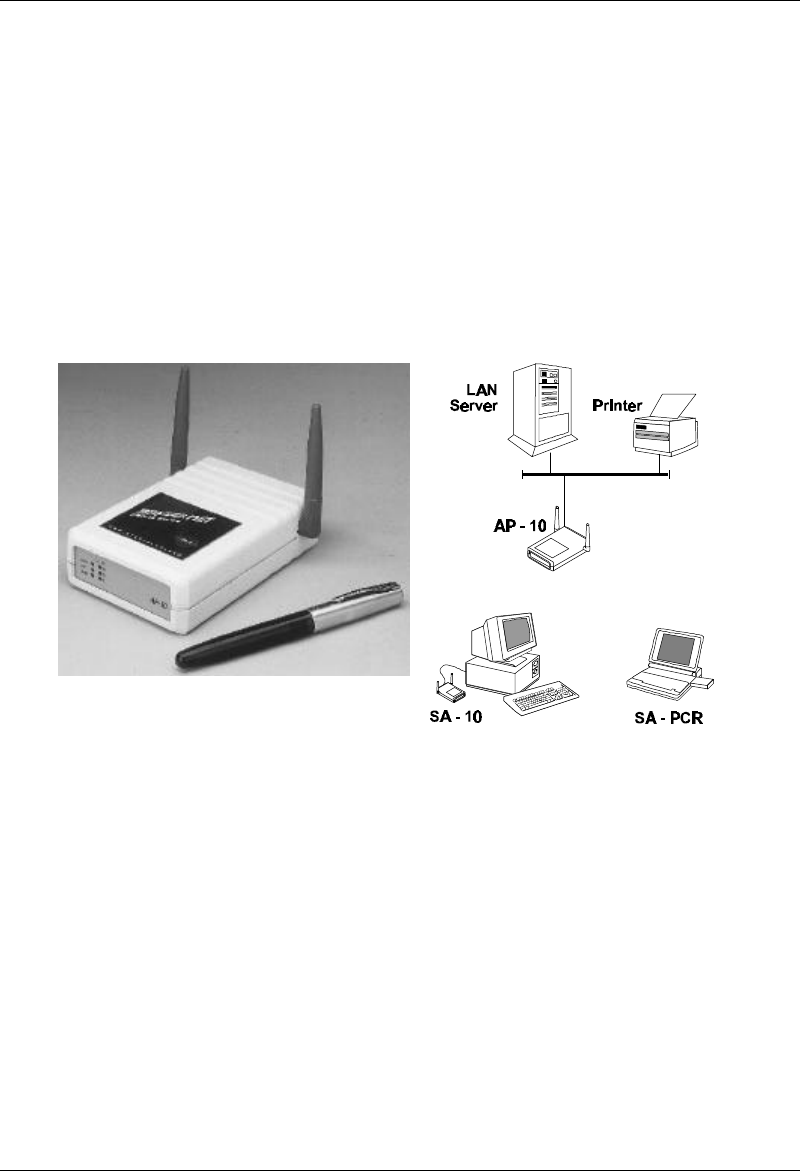
Introduction To The BreezeNET PRO.11 Series
BreezeNET PRO.11 Series 1-4User’s Guide
1.3.1. Access Point
The Access Point is fully compliant with the IEEE 802.11 wireless LAN
standard.
The BreezeNET Access Point is a wireless hub that provides access for
wireless workstations into wired Ethernet LANs. It also contains the
wireless coordinating function that enables workstations equipped with a
Station Adapter (Station Adapter, Bridge, and SA-PCR) to communicate
with one another inside the cell coverage area (even if they are not in direct
line of sight) via the Access Point. Any two wireless stations in two
different cells can communicate through their Access Points.
Figure 1.1: AP-10 PRO.11 with Two
Built-In Omni-Directional Antennas
Mobile workstations, such as laptops and hand-held devices, can roam
between Access Points that belong to the same Extended Service Set (ESS).
In an Extended Service Set, all Access Points have the same ESSID. When
the access points are set up so that their coverage areas overlap, users can
roam seamlessly from cell to cell. This means that there is no interruption of
network connection when moving from one coverage area to the other
through the overlap and is completely transparent to the user and the
applications. The Station Adapters decide when a mobile user becomes
disassociated from one access point and associated with another. This
process is fully transparent, requires no user intervention and involves no
loss of data packets.
Position multiple access points in locations where heavy network traffic is
expected to create a multicell and increase the aggregate throughput
capacity in areas where it is needed most. The system implements a Load
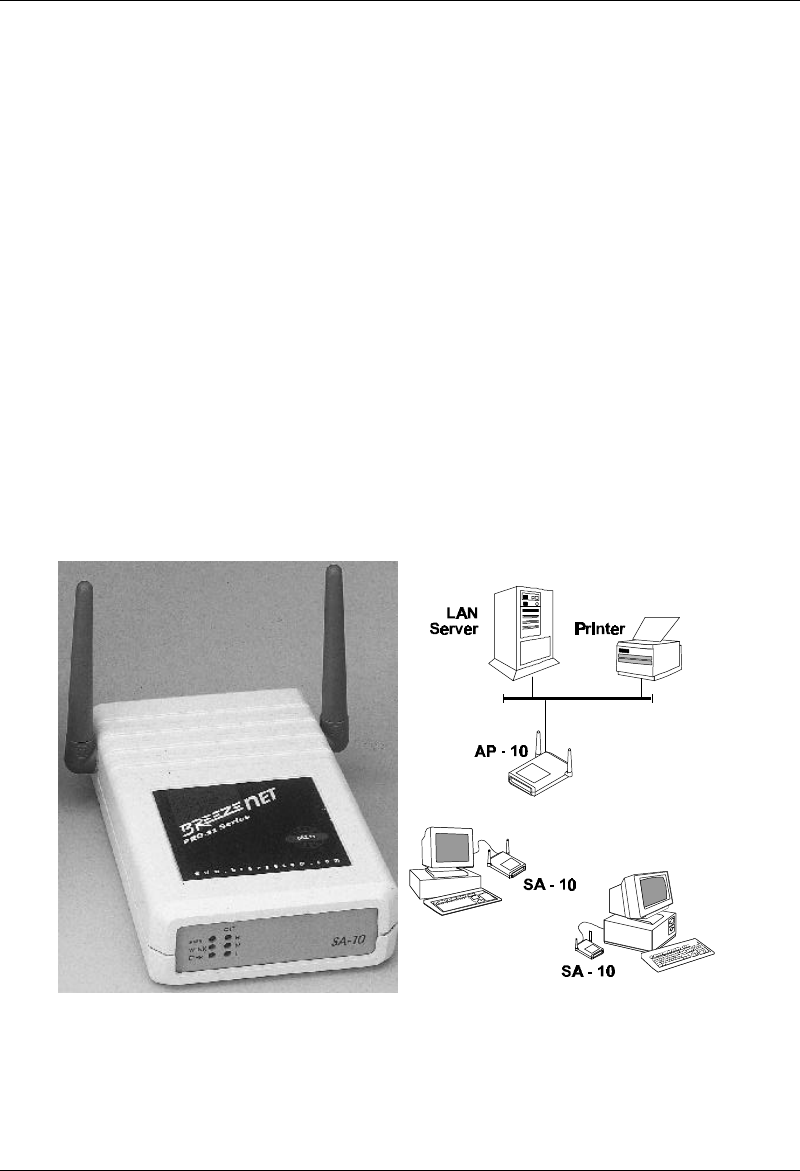
Introduction To The BreezeNET PRO.11 Series
BreezeNET PRO.11 Series 1-5User’s Guide
Balancing algorithm to divide the stations equally between the available co-
located Access Points.
The BreezeNET Access Point contains an embedded SNMP agent enabling
effective management by BreezeVIEW or any standard SNMP management
station. Software upgrades can be downloaded by TFTP protocol via the
wired LAN or wireless LAN.
The Access Point is available in two models:
• AP-10 PRO.11 with two integrated omni-directional antennas.
• AP-10D PRO.11 for use with external high-gain antenna(s).
1.3.2. Single Station Adapter
The BreezeNET Single Station Adapter is a wireless LAN station adapter
that converts any device equipped with an Ethernet interface into a wireless
LAN station. The Single Station Adapter is transparent to the device’s
hardware, software, and network operating system. This enables plug-and-
play installation.
Figure 1.2: SA-10 PRO.11 with Two
Integrated Omni-Directional Antennas
The Single Station Adapter enables its workstation to communicate with
any other wireless stations in the same cell coverage area, and to access all
network resources such as file servers, wired stations, printers and shared
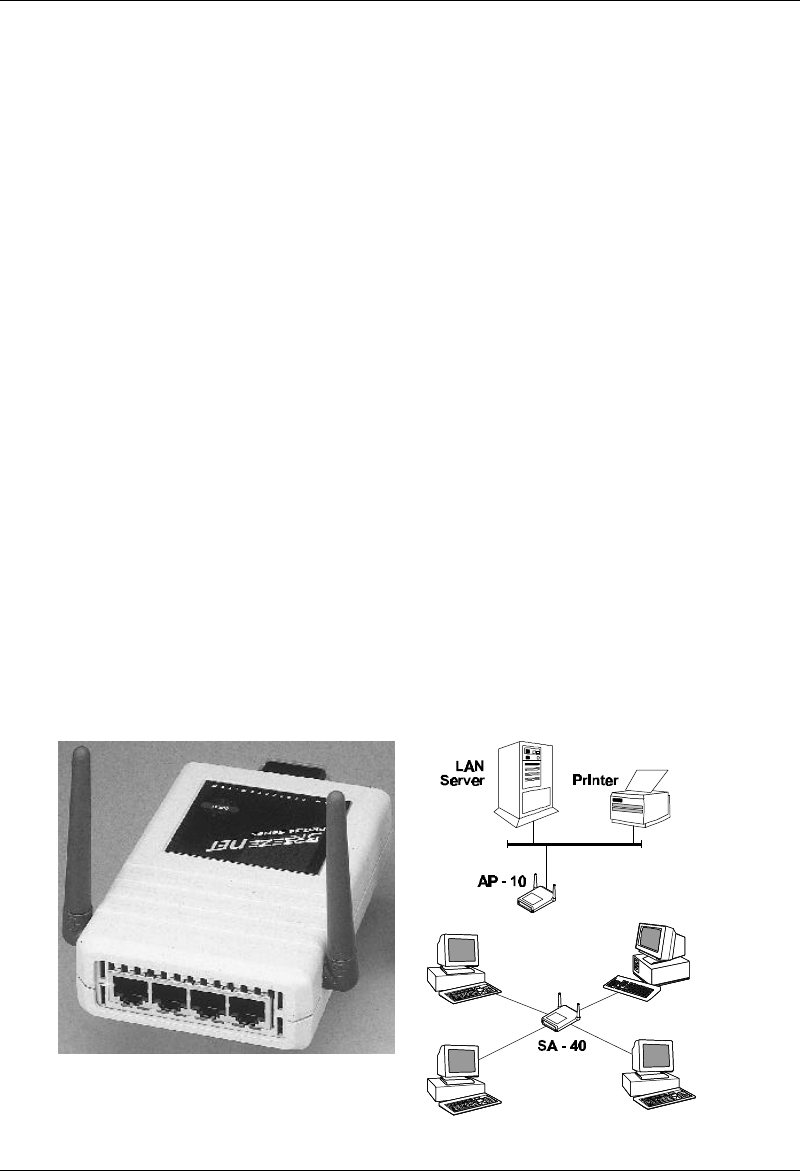
Introduction To The BreezeNET PRO.11 Series
BreezeNET PRO.11 Series 1-6User’s Guide
databases via the BreezeNET Access Point. Any two wireless stations in two
different cells can communicate through their Access Points.
Workstations that can be connected to the wireless LAN include PCs, X-
Terminals, Digital, SUN, HP, IBM, and Apple computers, and any other
device that supports Ethernet. The unit is transparent to the workgroup
devices’ hardware, software, and network operating system.
The Single Station Adapter contains an embedded SNMP agent enabling
effective management. Software upgrades are downloaded by TFTP via the
Ethernet port or via the Wireless LAN and Access Point.
Network connection is maintained while roaming between overlapping
coverage areas. Transmission and reception can be continued while moving
at high speed with no data packet loss or duplication.
The Single Station Adapter is available in two models:
• SA-10 PRO.11 with two integrated 2dbi omni-directional antennas.
• SA-10D PRO.11 for use with external antenna(s).
1.3.3. Four Port Station Adapter
The BreezeNET Four-Port Workgroup Adapter is a wireless LAN adapter
that connects a workgroup of up to four Ethernet-equipped workstations to
the wireless LAN. The Four Port Station Adapter is transparent to the
workgroup devices’ hardware and software, allowing plug-and-play
installation.
Figure 1.3: SA-40 PRO.11 with Two
Integrated Omni-Directional Antennas

Introduction To The BreezeNET PRO.11 Series
BreezeNET PRO.11 Series 1-7User’s Guide
The Four Port Station Adapter enables connected workstations to
communicate with other wireless stations in the same cell coverage area,
and to access all network resources such as file servers, wired stations,
printers and shared databases via the BreezeNET Access Point. The Four
Port Station Adapter also allows highly efficient and fast wired
communication among the four connected workstations.
Workstations that can be connected to the wireless LAN include PCs, X-
Terminals, Digital, SUN, HP, IBM, and Apple computers, and any other
device that supports Ethernet. The unit is transparent to the workgroup
devices’ hardware, software, and network operating system.
The BreezeNET Four Port Station Adapter contains an embedded SNMP
agent and software downloading capabilities which allow it to be effectively
managed. Software upgrades are downloaded by TFTP protocol via the
Ethernet ports or via the Wireless LAN and Access Point.
Network connection is maintained while roaming between overlapping
coverage areas. Transmission and reception can be continued while moving
at high speed with no data packet loss or duplication.
The Four Port Station Adapter is available in two models:
• SA-40 PRO.11 with two integrated omni-directional antennas.
• SA-40D PRO.11 for use with external antenna(s).
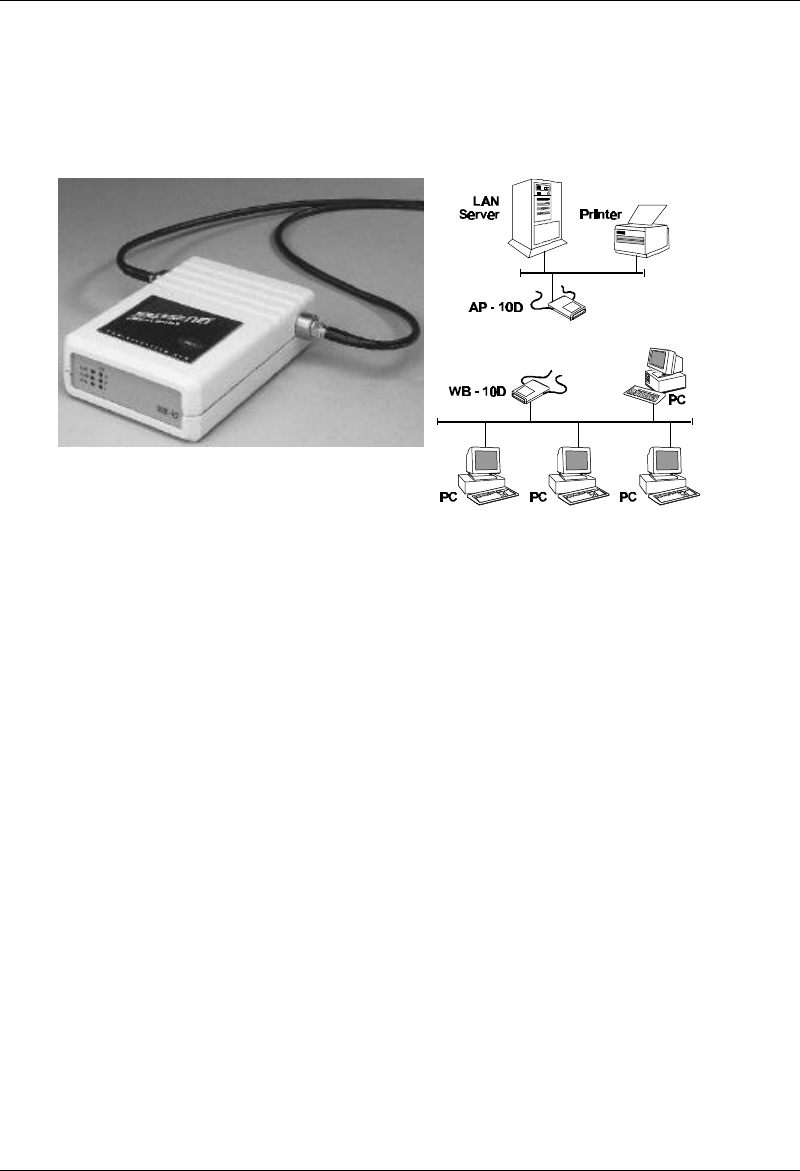
Introduction To The BreezeNET PRO.11 Series
BreezeNET PRO.11 Series 1-8User’s Guide
1.3.4. Workgroup Bridge
The BreezeNET Workgroup Bridge is a high-speed, wide-range wireless
LAN bridge that provides connectivity to remote Ethernet networks.
Figure 1.4: WB-10D PRO.11 with Two
External Antenna Connector Ports
The Workgroup Bridge communicates with the BreezeNET Access Points of
the remote LANs effectively creating an extended wireless network
spanning sites situated up to 6 miles apart (in Europe this range is limited by
ETSI regulations to 2.5 Km.). In this way a central Ethernet LAN may be
connected with one or more branch office LANs.
In addition, an island consisting of a Workgroup Bridge together with an
Access Point can work as a relay. Transmissions from the central LAN and
from the remote LAN are relayed via the island located between them. This
configuration effectively doubles bridge range.
Workstations that can be connected to the wireless LAN include PCs, X-
Terminals, Digital, SUN, HP, IBM, and Apple computers, and any other
device that supports Ethernet. The unit is transparent to the workgroup
devices’ hardware, software, and network operating system.
The BreezeNET Workgroup Bridge contains an embedded SNMP agent and
software downloading capabilities enabling effective management. Software
upgrades are downloaded using TFTP protocol via the Ethernet ports or via
the wireless LAN and Access Point.
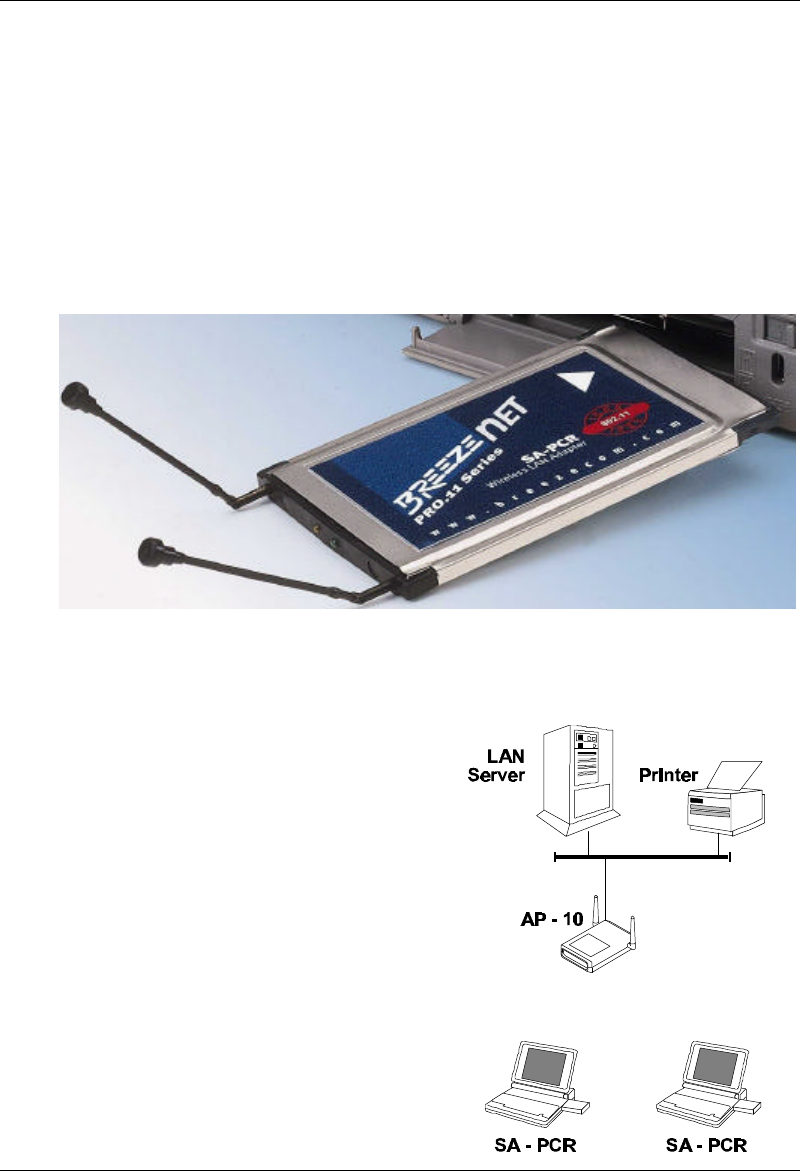
Introduction To The BreezeNET PRO.11 Series
BreezeNET PRO.11 Series 1-9User’s Guide
The Workgroup Bridge is available in two models:
• WB-10 PRO.11 with two integrated 2dbi omni-directional antennas.
• WB-10D PRO.11 with two external antenna connector ports.
1.3.5. PC Card
The PC Card gives the portable computer user continuous connectivity and
complete mobility, allowing seamless roaming throughout the wireless LAN
campus.
Figure 1.5: The SA-PCR PRO.11 PC Card
The BreezeNET PC Card converts any portable computer (notebook, lap-top,
pen-based, hand-held etc.)
containing a PCMCIA Release 2.1
Type II slot into a wireless LAN
workstation.
The PC Card can communicate
with any other wireless station in
its cell coverage area, and can
access all network resources such
as file servers, other wired
stations, printers and shared
databases via the BreezeNET
Access Point.
Network connection is maintained
while roaming between
overlapping cell coverage areas.

Introduction To The BreezeNET PRO.11 Series
BreezeNET PRO.11 Series 1-10 User’s Guide
Transmission and reception can be continued while moving at high speed
with no data packet loss or duplication.
The PC Card is available in two models:
• SA-PCR PRO.11 with two integrated omni-directional retractable
antennas.
• SA-PCD PRO.11 with two external antenna connector ports.
1.3.6. Extended Range Access Point and Bridge
Note: This product complies with European ETSI 300-328 and should only be used
in countries which implement this standard.
The BreezeNET WB-10DE is a high-speed, wide-range wireless LAN
bridge that provides connectivity to remote Ethernet networks.
The WB-10DE communicates with the BreezeNET AP-10DE Access Points
of the remote LANs effectively creating an extended wireless network
spanning sites situated up to 5 Km apart. In this way a central Ethernet LAN
may be connected with one or more branch office LANs.
The WB-10DE and AP-10DE products comply with European ETSI
standard 300-328. They should not be used in countries where FCC
standards are applicable.
The WB-10DE and AP-10DE can be used as a point-to-point as well as a
point-to-multipoint solution.
Note: The WB-10DE and AP-10DE are not compatible with the BreezeNET
PRO.11 Series. The SA-10 PRO.11, SA-PCR PRO.11, SA-40 PRO.11, AP-10
PRO.11 and WB-10 PRO.11 units cannot communicate with the AP-10DE
or the WB-10DE.
The BreezeNET AP-10DE and WB-10 DE contain an embedded SNMP
agent and software downloading capabilities enabling effective
management. Software upgrades are downloaded using TFTP protocol via
the Ethernet ports or via the wireless LAN and Access Point.
The BreezeNET DE Access Point and Bridge are available for use with
external antenna connector ports as seen in Figure 1.4.

Introduction To The BreezeNET PRO.11 Series
BreezeNET PRO.11 Series 1-11 User’s Guide
1.4. BreezeNET PRO.11 Functional Description
BreezeNET PRO.11 units add wireless functionality to existing Ethernet
LANs.
1.4.1. Quick Review of Ethernet
Standard Ethernet LAN stations are wired to a common bus. When one of
the stations sends a message, it assigns a destination address to the message
and sends the message on the bus. All stations on the bus “hear” the
message, but only the station with the proper address processes the message.
1.4.2. Startup Procedure
When wireless units (other than AP-10) start up, they scan the frequencies
for an AP-10. If an active AP-10 is in range, the units synchronize with it.
The addresses associated with the units are registered in the AP-10 (the
registration process is different for each unit type). From then on, the units
can send and receive messages to and from the wired LAN.
1.4.3. AP-10 Access Point
The AP-10 Access Point is connected to a wired Ethernet LAN, and it keeps
a list of known stations on its wireless side. When an AP-10 “hears” a
message that is destined for a wireless station, the AP-10 forwards the
message wirelessly to the station. If the message has a destination address
that the AP-10 does not recognize, the AP-10 ignores the message.
The AP-10 is constantly “listening” for wireless messages as well. When the
AP-10 “hears” a wireless message destined for another wireless unit, it
relays the message directly to the wireless unit without forwarding the
message to the wired LAN. When the AP-10 “hears” a wireless message
whose destination it does not recognize (since it does not keep a list of
known stations on its wired side), it forwards the message to the wired
LAN. Messages cannot be sent directly between wireless stations without an
AP-10 to relay the message.
1.4.4. SA-10 Station Adapter
The SA-10 station adapter is connected to a station’s network card. When
the station sends a message, the SA-10 wirelessly forwards it to the AP-10.

Introduction To The BreezeNET PRO.11 Series
BreezeNET PRO.11 Series 1-12 User’s Guide
And when the AP-10 receives a message destined for the station, it
wirelessly forwards the message to the SA-10.
The first time the station sends a message, the station’s address is registered
in the AP-10. The AP-10 keeps only the first address for each SA-10, so the
SA-10 will not work properly if connected to more than one station.
1.4.5. SA-40 Station Adapter
The SA-40 station adapter has four connectors for up to four stations and
works just like the SA-10. As each station connected to the SA-40 sends its
first message, each address is registered in the AP-10. The AP-10 keeps
only up to four addresses for each SA-40, so the SA-40 will not work
properly if connected to more than four stations.
1.4.6. WB-10 Wireless Bridge
As opposed to the SA-10 and SA-40 that connect directly to stations, the
WB-10 wireless bridge connects to a wired Ethernet LAN (Hub). When a
station on the WB-10’s LAN sends a message that is not destined for a local
station, the WB-10 wirelessly forwards the message to the AP-10. And
when the AP-10 receives a message destined for a station on the WB-10s
LAN, the AP-10 wirelessly forwards it to the WB-10. In this way, the
WB-10 and AP-10 work together like a standard network bridge.
The first time each station on the WB-10’s LAN sends a message, the
station’s address is registered in the WB-10 and the AP-10. The WB-10 and
AP-10 can hold all the addresses necessary to support an entire LAN
connected to a WB-10.
1.4.7. SA-PCR Station Adapter
The SA-PCR station adapter is inserted into the station’s PCMCIA slot and
works just like the SA-10. As opposed to the SA-10 and SA-40 station
adapters that connect to the station’s network card, the SA-PCR is the
station’s network card. The SA-10 and SA-40 can be used with stations of
any operating system as long as the station sends legal Ethernet messages,
but the SA-PCR requires a driver that is compatible with the station’s
operating system.

Basic Installation
BreezeNET PRO.11 Series 2-1User’s Guide
2. BASIC INSTALLATION
This chapter describes how to physically install most BreezeNET PRO.11
Series units. Installation for the SA-PCR PRO.11 PC Card Adapter is
described in Chapter 4.
The BreezeNET PRO.11 Series is a plug-and-play solution, and the units
begin to function when the following basic installation is complete.
However, you can adapt the system to your particular needs using the local
terminal (see Chapter 3).
For a description of various overall system configurations, refer to
Chapter 5.
2.1. Basic Installation Checklist
Standard installation involves the following steps:
• Check the Package List.
• Position the unit and the antenna in the best location.
• Connect the power supply to the unit.
• Connect the Ethernet port to the unit.
• Check unit functionality using the LED indicators.
2.2. Check the Package List
When you first open the package, verify that the unit is complete with the
following components:
• The unit, complete with two omni-directional antennas or RF connectors
for use with external antennas (“D” models).
• Quick Installation Guide/Card.
• 5V DC power supply transformer.
• Mounting bracket for wall or ceiling installations and torque key for
antenna connectors (supplied with "D" models).

Basic Installation
BreezeNET PRO.11 Series 2-2User’s Guide
The AP-10 PRO.11 and AP-10DE Access Points come with the following
additional components:
• The BreezeNET PRO.11 Series User’s Guide.
• A monitor connector cable for connecting the units to a monitor in order
to perform Local Terminal Management functions (see section 3.1).
• Proprietary MIB disk for performing remote unit configuration and
monitoring via SNMP (see section 9.1.1).
Open the packaging carefully and make sure that none of the items listed
above are missing. Do not discard packaging materials. If, for any reason,
the unit is returned, it must be shipped in its original package.
2.3. Position the Unit
BreezeNET PRO.11 wireless LAN products are robust, trouble-free units,
designed to operate efficiently under a wide range of conditions. The
following guidelines are provided to help you position the units to ensure
optimum coverage and operation of the wireless LAN.
Metal Furniture
Position the units clear of metal furniture and away from moving objects
such as metal fans or doors.
Microwave Ovens
For best performance, position the units clear of radiation sources that emit
in the 2.4 GHz frequency band, such as microwave ovens.
Antennas
For models with integrated antennas, make sure the antennas are extended
upward vertically in relation to the floor. For models with external antennas,
connect the external antennas and RF cable. For information about external
antenna installation, refer to section 5.3 Outdoor Installation
Considerations.
Heat Sources
Keep the units well away from sources of heat, such as radiators, air-
conditioners, etc.

Basic Installation
BreezeNET PRO.11 Series 2-3User’s Guide
2.3.1. Additional Considerations When Positioning the
Access Point
When positioning the AP-10 PRO.11 and AP-10DE Access Points, take into
account the following additional considerations.
Height
Install the Access Point at least 1.5m above the floor, clear of any high
office partitions or tall pieces of furniture in the coverage area. The Access
Point can be placed on a high shelf, or can be attached to the ceiling or a
wall using a mounting bracket.
Central Location
Install the Access Point in a central location in the intended coverage area.
Good positions are:
• In the center of a large room.
• In the center of a corridor.
• At the intersection of two corridors.
Many modern buildings have partitions constructed of metal or containing
metal components. We recommend that you install the Access Points on the
corridor ceilings. The radio waves propagated by the BreezeNET PRO.11
LAN are reflected along the metal partitions and enter the offices through
the doors or glass sections.
2.4. Connect the Unit to the Power Supply
The unit operates on a power input of 5V DC, (1200mA , 1500mA peak)
supplied by the power transformer included with the unit.
• Plug the output jack of the power transformer into the DC input socket
on the unit. This socket may be located on the rear or side panel of the
unit.
• Connect the supplied power transformer to a power outlet -
110/ 220VAC.

Basic Installation
BreezeNET PRO.11 Series 2-4User’s Guide
2.5. Connect the Unit to the Ethernet Port
• Connect one end of a an Ethernet 10BaseT cable (not supplied) to the
RJ-45 port on the rear panel of the unit (marked UTP).
• Connect the other end of the connector cable to the Ethernet outlet:
• When connecting an SA-10 or SA-40 to a PC, use a straight cable.
• When connecting an AP-10 or WB-10 to a LAN, use a straight
cable.
• When connecting an AP-10 or WB-10 to a PC, use a crossed cable.
• When connecting an AP-10 to a WB-10, use a crossed cable.
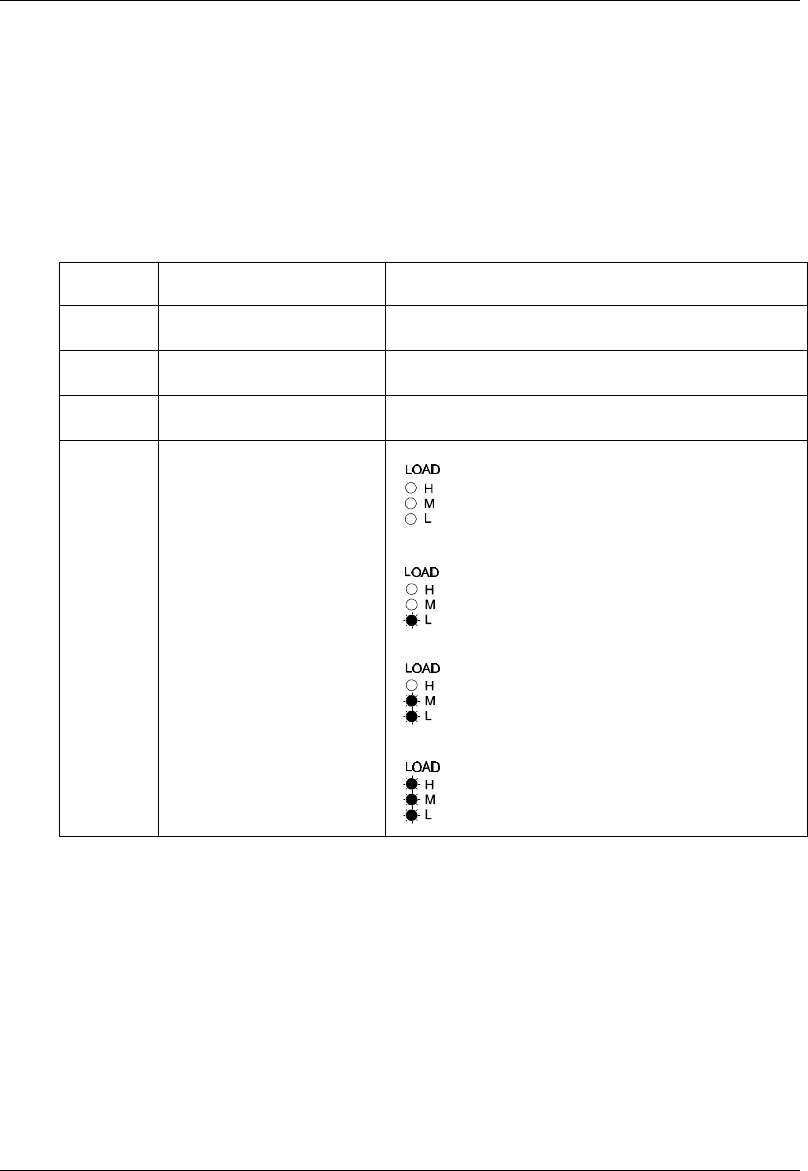
Basic Installation
BreezeNET PRO.11 Series 2-5User’s Guide
2.6. Check Unit Functionality using LED indicators
Check the unit functionality by using the LEDs on the front panel. The
following tables describe the front panel LEDs for Stations (SA-10, SA-40)
and Bridges (WB-10), and for Access Points.
2.6.1. Station (SA-10, SA-40) and Bridge (WB-10) LEDs
Name Description Functionality
PWR power supply On – After successful power up
Off – Power off
WLNK WLAN Link On – Unit is synchronized or associated with an AP
Off – Unit is not synchronized or associated with an AP
ETHR Ethernet activity On – Reception on Ethernet port
Off – No reception on Ethernet port
QLT Quality of reception
very low quality reception or
not synchronized with Access Point
less than -81 dBm
low quality reception
(usually enabling 1 Mbps traffic)
from -81 to -77 dBm
medium quality reception
(usually enabling 2 Mbps traffic)
from -77 to -65 dBm
high quality reception
(usually enabling 3 Mbps traffic)
greater than -65 dBm
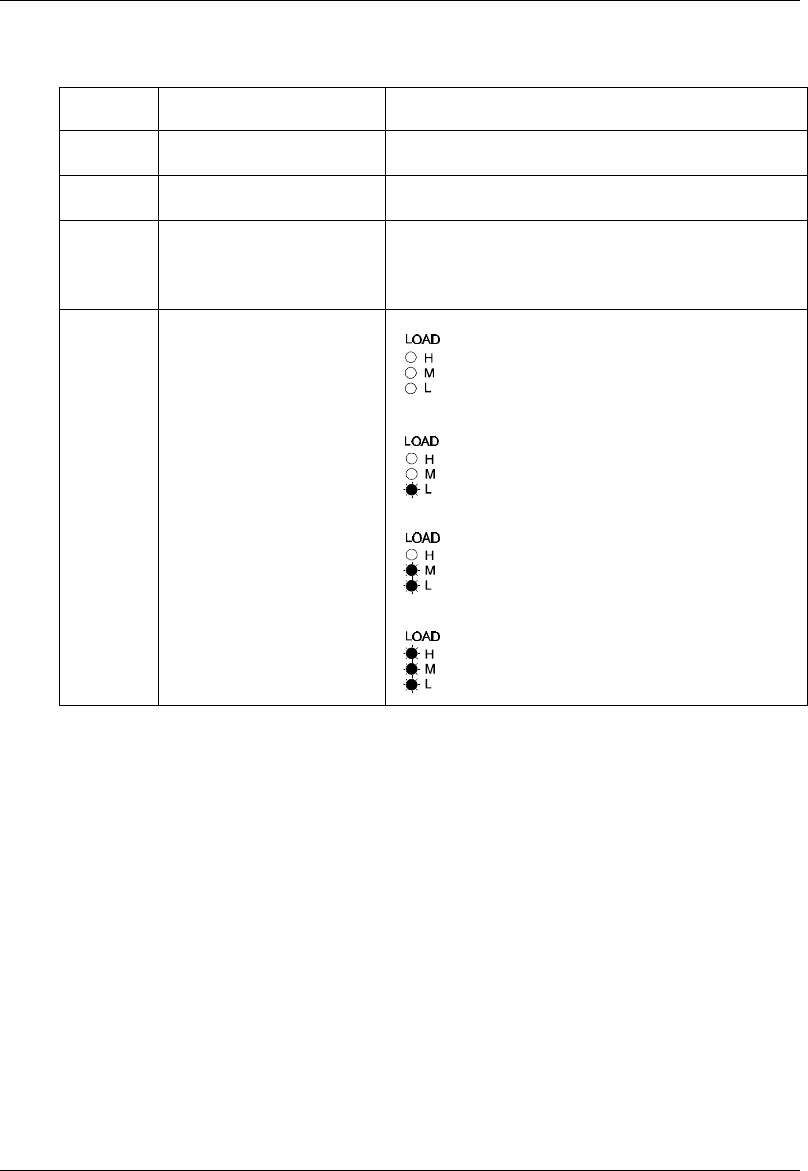
Basic Installation
BreezeNET PRO.11 Series 2-6User’s Guide
2.6.2. Access Point LEDs
Name Description Functionality
PWR power supply On – After successful power up
Off – Power off
INFR radio interference Off – No interference
Blinking – Interference Present
ETHR Ethernet activity On – Reception of data from Ethernet LAN that is forwarded to
WLAN (in reject unknown mode)
Off – No reception of data from Ethernet LAN that is forwarded
to WLAN
LOAD WLAN load
Number of associated stations
no stations
1-8 stations
9-16 stations
17 or more stations
2.6.3. Verifying the Ethernet Connection
Once you have connected the unit to an Ethernet outlet, verify that the
ETHR LED on the front panel is blinking. The ETHR LED should blink
whenever the unit receives LAN traffic.
At the other end of the Ethernet link, verify that the LINK indicator is ON.
For APs the LINK indicator is located on the attached hub port, and for
Station Adapters the LINK indicator is located on the NIC.

Device Setup and Management
BreezeNET PRO.11 Series 3-1User’s Guide
3. DEVICE SETUP AND MANAGEMENT
This chapter explains how to access the local terminal program, and how to
use the terminal program to setup, configure, and manage most BreezeNET
PRO.11 Series units. Setup, configuration and management for the SA-PCR
PRO.11 PC Card Adapter is described in Chapter 4.
The BreezeNET PRO.11 Series is a plug-and-play solution and operates
immediately after physical installation without any user intervention.
However, you can adapt the system to your particular needs using the local
terminal. In addition, all products in the series contain an SNMP agent and
are configurable remotely via the network.
Note: Reset the unit after making configuration changes so that the changes will
take effect.
3.1. Accessing and Using Local Terminal
Management
⇒⇒ To access Local Terminal Management:
1. Use the Monitor cable (supplied with the Access Point) to connect
the MON jack on the rear panel of the unit to the COM port of your
ASCII ANSI terminal or PC.
2. Run a terminal emulation program (such as HyperTerminal™).
3. Set up communication parameters to the following:
• Baud Rate: 9600
• Data Bits: 8
• Stop Bits: 1
• Parity: None
• Flow Control: XON/XOFF
• Connector: Connected COM port.
4. Press Enter. The main menu appears.

Device Setup and Management
BreezeNET PRO.11 Series 3-2User’s Guide
⇒⇒ To use Local Terminal Management:
1. Press an option number to open/activate the option. You may need
to press Enter in some cases.
2. Press Esc to exit a menu or option.
3. Reset the unit after making configuration changes.
3.2. Configuration Screens
Listed below are the menus, sub-menus, and parameters/options in the
terminal program that the Installer can edit. Default values are listed where
applicable.
Numbers in the table below indicate how to reach each option. For example,
to reach the 1.2.1 IP Address option, start at the main menu and press 1,
then 2, and then 1.
Menu Sub-Menu Parameter/Option Default Values
1. System
Config-
uration
1.1 Station
Status • Unit Mode
• Unit H/W Address
• Unit WLAN Addr (SA-10/40, WB-10 Only)
• Station Status (SA-10 Only)
• AP Address (SA-10/40 Only)
• Current Number of Associations (AP Only)
• Number of Associations Since Last Reset
• Cur. Number of Authentications (AP Only)
• Max Number Authentications (AP Only)
1.2 IP and
SNMP
Parameters
1.2.1 IP Address
1.2.2 Subnet Mask
1.2.3 Default Gateway Address
1.2.4 SNMP Traps
1.2.5 Display Current Values Enabled
1.3 Wireless
LAN
(WLAN)
Parameters
1.3.1 Hopping Sequence (AP Only)
1.3.2 Hopping Set (AP Only)
1.3.3 ESSID
1.3.4 Maximum Data Rate
1.3.5 Transmit Diversity
1.3.6 Mobility
1.3.7 Load Sharing
1.3.8 Long Range
1.3.9 Preferred AP (SA-10/40, WB-10 Only)
1.3.A Display Current Values
1 (FCC standard)
2 (FCC standard)
ESSID1
3Mbps
Use 2 Antennas*
Stationary
Disabled**
Disabled
Not Set
1.4 Bridging 1.4.1 LAN-WLAN Bridge Mode (AP Only)
1.4.2 Intelligent Bridging Period (AP Only)
1.4.3 IP Filtering
1.4.4 Tunneling
1.4.5 Broadcast Relaying
1.4.6 Unicast Relaying
Reject Unknown
15 sec
Disabled
Both
Enabled
Enabled

Device Setup and Management
BreezeNET PRO.11 Series 3-3User’s Guide
1.5 Station
Control 1.5.1 Reset Unit
1.5.2 Set Factory Defaults
2. Advanced
Settings 2.3 Performance 2.3.1 Dwell Time (AP Only) 128 msec
2.4 Radio 2.4.4 Auto Calibration Enabled
3. Site
Survey 3.1 System
Counters 3.1.1 Display Counters
3.1.2 Reset Counters
3.2 Survey
Software 3.2.1 Operation Mode
3.2.2 Data Type
3.3.3 Data Rate
3.3.4 Antenna
3.3.5 Power Level
3.3.6 Number of Packets to Tx
3.3.7 Time Between Packets
3.3.8 Packet Length
3.3.9 Display Rx Packets per Frequency
3.3.D Display Actual Configuration
3.3.L Load Default Configuration
3.3.S Start Statistics
3.3.Q Stop Statistics
3.3.N Neighboring AP’s
4. Access
Control 4.1 Change Access Rights
4.2 Change Installer Password
4.3 Show Current Access Right
* Option 1.3.5 Transmit Diversity has the default value Use #2 for the SA-
40 unit only.
** Option 1.3.7 Load Sharing has the default value Enabled for the AP-10
unit only.
3.3. Main Menu
BreezeNET PRO.11 Series (SA-10)
Version: 4.211
Date: 25 Jun 1998 15:46:24
BreezeNET Monitor
=================
1 – System Configuration
2 – Advanced Settings
3 - Site Survey
4 - Access Control
Select option >
Figure 3.1: Main Menu
PRO.11 Series Unit Model (SA-10, SA-40, WB-10, AP-10)
Software
Version

Device Setup and Management
BreezeNET PRO.11 Series 3-4User’s Guide
3.4. System Configuration Menu
BreezeNET PRO.11 Series (SA-10)
Version: 4.211
Date: 25 Jun 1998 15:46:24
System Configuration menu
=========================
1 - Station Status
2 - IP and SNMP Parameters
3 - Wireless LAN Parameters
4 – Security
5 - Bridging
6 - Station Control
Select option >
Figure 3.2: System Configuration Menu
3.4.1. Station Status
Station Status is a read-only sub-menu that displays the current values of the
following parameters:
• Unit Mode – Identifies the unit’s function. For example, if the unit is an
Access Point, “AP” appears in this field. If the unit is a Station Adapter
(SA-10, SA-40) or a QB-10, "SA" appears in this field.
• Unit H/W Address – Displays the unit’s unique IEEE MAC address.
• Unit WLAN Address (SA or WB) – The address by which the unit
associates. For the SA-10, this is the address of the PC. For the SA-40
and WB-10, this is the address of the hardware. This field does not
appear when the unit is an AP.
• Station Status (SA or WB) – Current status of the station. There are
three options:
• Scanning - The station is searching for an AP with which to
associate.
• Sync Waiting for Address - The station is synchronized with an AP
but has not yet learned its WLAN MAC address (this option is

Device Setup and Management
BreezeNET PRO.11 Series 3-5User’s Guide
relevant only to the SA-10). The AP does not forward packets to the
station when it is in this mode.
• Associated - The station is associated with an AP and has adopted
the attached PC MAC address (for SA-10) or uses the unit’s H/W
address (SA-40 and WB-10), and is receiving packets from the LAN.
• AP Address (Station Only) – Address of the AP with which the unit is
currently associated.
• Current Number of Associations (AP Only) – Total number of stations
currently associated with this AP.
• Number of Associations Since Last Reset – For stations, this indicates
the total number of associations and disassociations with various APs.
This is usually an indication of roaming. When the unit is an AP, this
field indicates how many station are currently associated with this
particular AP.
• Current Number of Authentications (AP Only) – Total number of
stations currently authenticated with this AP. A station may be
concurrently authenticated with several APs, but is associated with only
one AP at a time.
• Maximum Number of Authentications (AP Only) – Maximum number
of stations that were authenticated with this AP at one time.
3.4.2. IP and SNMP Parameters
All BreezeNET PRO.11 units contain IP Host software. This software is
used for testing the unit for SNMP management functions and for
downloading software upgrades using the TFTP protocol.
• IP Address – IP address of the unit.
• Subnet Mask – Subnet mask of the unit.
• Default Gateway Address – Gateway address of the unit.
• SNMP Traps – Whether this unit sends SNMP traps. If enabled, when
an event occurs, a trap is sent to the defined host address (see section
9.1.2 for a list of traps). You can configure the host address to which the
traps are sent through SNMP management.

Device Setup and Management
BreezeNET PRO.11 Series 3-6User’s Guide
• Display Current Values – Displays information concerning the current
status of all IP-related items.
3.4.3. Wireless LAN (WLAN) Parameters
The WLAN Parameters Menu contains the following options:
• Hopping Sequence (AP Only) – Hopping sequence of the unit.
A hopping sequence is a pre-defined series of channels (frequencies) that
are used in a specific, pseudo-random order as defined in the sequence.
The unit “hops” from frequency to frequency according to the selected
sequence. When more than one AP is co-located in the same area (even
if they are not part of the same network) it is recommended to assign a
different hopping sequence to each AP.
Hopping sequences are grouped in three hopping sets. The hopping set
selected in the Hopping Set screen (see next parameter) determines
which hopping sequences are available in this screen. When setting up
multiple APs in the same site, always choose hopping sequences from
the same hopping set. This reduces the possibility of collisions on the
WLAN.
This parameter is set only in AP-10 PRO.11 Access Point. It is not
accessible from any other BreezeNET PRO.11 unit. All other stations
learn it from the Access Point during the association process. Different
co-located WLAN segments should use different hopping sequences.
• Hopping Set (AP Only) – Hopping set (between 1 and 3) of the unit.
Hopping sequences are grouped in several hopping sets. The hopping set
selected in this screen determines which hopping sequences are available
in the Hopping Sequence screen (see previous parameter). Always use
the same hopping set per site.
Following is the list of hopping sequences and sets for each country.
The default value for all countries except Japan is: Hopping Sequence=1,
Hopping Set=2.
For Japan, the default value is Hopping Sequence=6, Hopping Set=1.

Device Setup and Management
BreezeNET PRO.11 Series 3-7User’s Guide
Australia
set 1 = 0, 3, 6, 9, 12, 15, 18, 21, 24, 27, 30, 33, 36, 39, 42, 45, 48, 51, 54,
57
set 2 = 1, 4, 7, 10, 13, 16, 19, 22, 25, 28, 31, 34, 37, 40, 43, 46, 49, 52,
55, 58
set 3 = 2, 5, 8, 11, 14, 17, 20, 23, 26, 29, 32, 35, 38, 41, 44, 47, 50, 53,
56, 59
Canada
set 1 = 0, 3, 6, 9, 12, 15, 18, 21, 24, 27
set 2 = 1, 4, 7, 10, 13, 16, 19, 22, 25, 28
set 3 = 2, 5, 8, 11, 14, 17, 20, 23, 26, 29
EthAirNet (1.144)
set 1 = 0, 3, 6, 9, 12, 15, 18, 21
set 2 = 1, 4, 7, 10, 13, 16, 19, 22
set 3 = 2, 5, 8, 11, 14, 17, 20
Europe DD
set 1 = 1, 2, 3, 4, 5, 6, 7, 8, 9, 10
set 2 = 1, 2, 3, 4, 5, 6, 7, 8, 9, 10
set 3 = 1, 2, 3, 4, 5, 6, 7, 8, 9, 10
Europe ETSI
set 1 = 0, 3, 6, 9, 12, 15, 18, 21
set 2 = 1, 4, 7, 10, 13, 16, 19, 22
set 3 = 2, 5, 8, 11, 14, 17, 20
France
set 1 = 0, 3, 6, 9, 12, 15, 18, 21, 24, 27, 30
set 2 = 1, 4, 7, 10, 13, 16, 19, 22, 25, 28, 31
set 3 = 2, 5, 8, 11, 14, 17, 20, 23, 26, 29, 32
Israel
set 1 = 0, 3, 6, 9, 12, 15, 18, 21, 24, 27, 30
set 2 = 1, 4, 7, 10, 13, 16, 19, 22, 25, 28, 31
set 3 = 2, 5, 8, 11, 14, 17, 20, 23, 26, 29, 32

Device Setup and Management
BreezeNET PRO.11 Series 3-8User’s Guide
Japan
set 1 = 6, 9,12,15
set 2 = 7,10,13,16
set 3 = 8,11,14,17
Korea
set 1 = 6, 9,12,15
set 2 = 7,10,13,16
set 3 = 8,11,14,17
Netherlands
set 1 = 0, 3, 6, 9, 12
set 2 = 1, 4, 7, 10, 13
set 3 = 2, 5, 8, 11, 14
Spain
set 1 = 0, 3, 6, 9, 12, 15, 18, 21, 24
set 2 = 1, 4, 7, 10, 13, 16, 19, 22, 25
set 3 = 2, 5, 8, 11, 14, 17, 20, 23, 26
US FCC and Europe ETSI
set 1 = 0, 3, 6, 9, 12, 15, 18, 21, 24, 27, 30, 33, 36, 39, 42, 45, 48, 51, 54,
57, 60, 63, 66, 69, 72, 75
set 2 = 1, 4, 7, 10, 13, 16, 19, 22, 25, 28, 31, 34, 37, 40, 43, 46, 49, 52,
55, 58, 61, 64, 67, 70, 73, 76
set 3 = 2, 5, 8, 11, 14, 17, 20, 23, 26, 29, 32, 35, 38, 41, 44, 47, 50, 53,
56, 59, 62, 65, 68, 71, 74, 77
Site Proprietary
set 1 = 0, 1, 2, 3, 4, 5, 6, 7, 8, 9, 10, 11,
12, 13, 14, 15, 16, 17, 18, 19, 20, 21, 22
set 2 = 0, 1, 2, 3, 4, 5, 6, 7, 8, 9, 10, 11,
12, 13, 14, 15, 16, 17, 18, 19, 20, 21, 22
set 3 = 0, 1, 2, 3, 4, 5, 6, 7, 8, 9, 10, 11,
12, 13, 14, 15, 16, 17, 18, 19, 20, 21, 22
• ESSID – ESSID of the unit (up to 32 printable ASCII characters). The
ESSID is a string used to identify a WLAN. This ID prevents the
unintentional merging of two co-located WLANs. A station can only

Device Setup and Management
BreezeNET PRO.11 Series 3-9User’s Guide
associate with an AP that has the same ESSID. Use different ESSIDs to
segment the WLAN network and add security.
Note: The ESSID is case-sensitive.
• Maximum Data Rate – Maximum data rate of the unit. BreezeNET
PRO.11 units operate at 1 Mbps, 2 Mbps or 3 Mbps. The unit adaptively
selects the highest possible rate for transmission. Under certain
conditions (compatibility reasons or for range/speed trade-off) you may
decide to limit the use of higher rates.
• Transmit Diversity – Which antennas are used for transmission. During
reception, a BreezeNET PRO.11 unit dynamically selects the antenna
where reception is optimal. In contrast, before transmission the unit
selects the antenna from which it will transmit. It usually uses the
antenna last used for successful transmission. In models with external
antennas, sometimes only a single antenna is used. In this case, Transmit
Diversity should be configured to transmit only from that single antenna.
Similarly, models using a booster or an LNA use only a single antenna
for transmission.
• Mobility – BreezeNET PRO.11 stations optimize their roaming
algorithms according to the mobility mode parameter. For example, a
stationary station is more tolerant of bad propagation conditions. It
assumes that this is a temporary situation and is not caused by the station
changing position. Initiating a roaming procedure in such a case would
be counter-productive. In general, Wireless stations can be used in one
of three mobility modes:
• Mobile – High Mobility. For stations that may move at speeds of
over 30 km per hour.
• Portable – Medium Mobility. For stations that may move at speeds
of over 10 km per hour, but not over 30 km per hour.
• Stationary – Low Mobility. For stations that will not move at speeds
of over 10 km per hour. Stationary is the default value, and in almost
all cases this is the best choice.
• Load Sharing – Whether load sharing is enabled for the unit. When
installing a Wireless LAN network in a high-traffic environment, you
can increase the aggregate throughput by installing multiple APs to
create co-located cells. When load sharing is enabled, the wireless

Device Setup and Management
BreezeNET PRO.11 Series 3-10 User’s Guide
stations distribute themselves evenly among the APs to best divide the
traffic between the APs.
• Long Range – Whether long range communication is enabled for the
unit. Enable long range only when units are more than 20 km apart.
When long range is enabled, a unit that has transmitted will allow more
time for an ACK to be received from the other unit. It is not
recommended to enable long range for links under 20 km. Achieving
long range communication depends on RF conditions and configuration.
Enabling the Long Range parameter has no effect on the achievable
range.
• Preferred AP – AP MAC (Ethernet) address of the preferred AP. You
can configure a station to prefer a specific AP unit. When the station
powers up, it will associate with the preferred AP even if the signal from
that AP is lower than the signal from other APs. The station will roam to
another AP only if it stops receiving beacons from the preferred AP.
• Display Current Values – This read-only status screen displays current
WLAN parameters. Press any key to return to the WLAN Parameters
Menu.
3.4.4. Bridging
The Bridging Menu contains the following options:
• LAN to WLAN Bridging Mode (AP Only) – The options are:
• Reject Unknown – Type 0 to allow transmission of packets only to
stations that the AP knows to exist in the Wireless LAN (behind the
Wireless Bridge).
• Forward Unknown – Type 1 to allow transmission of all packets
except those sent to stations that the AP recognizes as being on its
wired Ethernet side. When connecting very large networks, it is
recommended to set this parameter to forward unknown.
• Intelligent Bridging Period (AP Only) – Intelligent bridging enables
smooth roaming of WB-10 units. When intelligent bridging is enabled,
the AP goes into a special bridging mode for a fixed amount of time
whenever a wireless bridge (WB) roams into its area. This mode causes
the AP to forward packets destined for the stations behind the WB-10
even though they are known or were learned from the wired side (except
that no learning of the wired LAN will take place). Afterwards, the AP

Device Setup and Management
BreezeNET PRO.11 Series 3-11 User’s Guide
will switch back to Reject Unknown bridging mode. This procedure
prevents packets destined for stations behind the bridge from getting
lost. The value of this parameter is the length of time in seconds that the
AP will remain in special mode.
• IP Filtering – Whether IP filtering is enabled for the unit. Enable IP
Filtering to filter out any other protocol (such as IPX) if you want that
only IP traffic will pass through the WLAN.
• Tunneling – Whether the unit performs tunneling. Enable Appletalk
tunneling if the network contains a mix of Ethertalk1 (ET1) and
Ethertalk2 (ET2) stations to ensure smooth communications. Enable IPX
tunneling if IPX protocol is running over your network. Be sure to set all
units to the same tunneling setting.
• Broadcast Relaying (AP Only) – Whether the unit performs broadcast
relaying. When Broadcast Relaying is enabled, Broadcast packets
originating in WLAN devices are transmitted by the AP back to the
WLAN devices, as well as to the LAN. If it is disabled, these packets are
sent only to the local wired LAN and are not sent back to the WLAN.
Disable Broadcast Relaying only if you know that all Broadcast
messages from the WLAN will be destined to the wired LAN.
• Unicast Relaying – Whether the unit performs Unicast relaying. When
Unicast Relaying is enabled, Unicast packets originating in WLAN
devices can be transmitted back to the WLAN devices. If this parameter
is disabled, these packets are not sent to the WLAN even if they are
intended for devices on the WLAN. Disable Unicast Relaying only if
you know that all Unicast messages from the WLAN will be destined to
the local wired LAN.
3.4.5. Station Control
The Station Control Menu contains the following options:
• Reset Unit – Resets the BreezeNET PRO.11 unit and applies any
changes made to the system parameters.
• Set Factory Defaults –When this option is implemented, system
parameters revert back to the original factory default settings. There are
two options:
• Full – All parameters revert to defaults except for Japan Call Sign (if
applicable).

Device Setup and Management
BreezeNET PRO.11 Series 3-12 User’s Guide
• Partial – All parameters revert except for Japan Call Sign (if
applicable), IP Address, Subnet Mask, Default Gateway, Hopping
Sequence, Hopping Set, ESSID, Transmit Diversity, Long Range,
Preferred AP, IP Filtering, Hopping Standard, Power Level, Auto
Calibration.
3.5. Advanced Settings Menu
BreezeNET PRO.11 Series (SA-10)
Version: 4.211
Date: 25 Jun 1998 15:46:24
Advanced menu
================
1 - Compatibility
2 - Roaming
3 - Performance
4 - Radio
5 - Rate
6 - AP Redundancy Support
7 - Maintenance
Select option >
Figure 3.3: Advanced Settings Menu
Modification of most of the parameters that can be accessed from this menu
is limited to Certified BreezeCOM Engineers only. The Installer has access
to modify the following parameter of the Performance menu:
• Dwell Time (AP Only) – The time spent on a radio channel before
hopping to the next channel in the sequence.
The Installer also has access to modify the following parameter of the
Radio menu:
• Auto Calibration – When the unit is started, it performs an internal self-
test. Part of this test is automatic calibration of the DC Offset and
deviation pattern. Auto Calibration is not supported in the “DE” models,
and it therefore must be disabled for “DE” units.
The following sections describe the important parameters and relevant
information in the Advanced Settings menu that can be viewed, but not
modified, the the Installer.

Device Setup and Management
BreezeNET PRO.11 Series 3-13 User’s Guide
3.5.1. Performance
The Performance menu contains parameters regarding unit performance:
• RTS Threshold – Minimum packet size to require an RTS. For packets
smaller than this threshold, an RTS is not sent and the packet is
transmitted directly to the WLAN.
3.5.2. Radio
The Radio menu contains the following major parameters:
• Hopping Standard – The Hopping Standard is a set of rules regarding
the radio transmission standard allowed in each country. Units will work
together only if set to the same hopping standard. Use this parameter to
set the unit’s hopping standard to that of the relevant country.
• Power level – Output power level at which the unit is transmitting.
There are two possibilities, Low (4dBm) or High (17 dBm) at the
antenna connector.
3.5.3. Rate
The Rate menu contains the following relevant counters:
• Rate Counters – The number of frames transmitted in each data-rate
since the last time the unit was reset. The Reset Counters option will
reset these counters also. In APs, the counters for all associated stations
are displayed, indicated by their MAC address. In stations, only the
stations’ rate counters are displayed with no indication of address. The
rate counters show the rate the packet was transmitted for the first time,
not including retransmissions. The Ret counter shows the number of
frames that had to be retransmitted, and does not count the number of
retransmissions that actually accrued.
Checking rate counters is the best way to determine which data rate is
optimal for the unit. It is recommended to restrict the Maximum Data
Rate (refer to section 3.4.3) for each unit according to these counters.

Device Setup and Management
BreezeNET PRO.11 Series 3-14 User’s Guide
3.5.4. Maintenance
The Maintenance menu contains the following major parameters and
information:
• Display Alarm Log – The last four error messages that the unit
displayed since the last Factory Defaults reset. The Alarm log stores
events in four levels of error notifications: MSG (Message), WRN
(Warning), ERR (Error), and FTL (Fatal).
You can control message severity as follows: in the main menu, press Y-
Testing, press 2-System Info and System Parameters, and press 4-Events
Storage. Use the 1-Event Storage Policy runtime value option to set the
policy until the next reset. Use the 2-Event Storage Policy Nv ram value
option to set the constant policy for the Alarm Log.
• Japan Call Sign – The Japan Call Sign is part of the Japanese standard,
defined according to local regulations. The Japanese Ministry of
Communications supplies an activation code for the units; this code is
set in the factory for each unit.
3.6. Site Survey Menu
BreezeNET PRO.11 Series (SA-10)
Version: 4.211
Date: 25 Jun 1998 15:46:24
Site Survey menu
================
1 - System Counters
2 - Survey Software
Select option >
Figure 3.4: Site Survey Menu
The Site Survey Menu gives access to the sub-menus necessary to perform a
Site Survey that helps you position your units and align their antennas, as
well as perform troubleshooting.

Device Setup and Management
BreezeNET PRO.11 Series 3-15 User’s Guide
The following sections first describe the sub-menus in the Site Survey
menu, and then explain step-by-step how to perform a Site Survey. The Site
Survey menu contains two sub-menus:
• System Counters
• Survey Software
3.6.1. System Counters
The System counters are a simple yet very efficient tool to monitor, interpret
and analyze the Wireless LAN performance. The counters contain statistics
concerning Wireless and Ethernet frames. The submenu contains the
following options:
• Display Counters – Choose this option to display the current value of
the Ethernet and Wireless counters.
• Reset Counters - Choose this option to reset all the counters. After
choosing this option you will be requested to type 1 for confirmation or
0 to cancel the reset.
Ethernet Counters
Ethernet counters display statistics about the unit’s Ethernet port activity.
The unit receives Ethernet frames from its UTP port and forwards them to
its internal bridge, which decides whether or not to transmit them to the
Wireless LAN. The units have a smart hardware filter mechanism which
filters most of the frames on the LAN, and hardware filtered frames are not
counted.
On the other side, frames which where received from the wireless LAN and
some frames generated by the unit (answers to SNMP queries and pings
which reached to the unit via the UTP port), will be transmitted to the UTP
port.
Available Counters:
• Total Received frames – The total number of frames received from the
UTP port. This counter includes both bad and good frames.
• Received Bad Frames – The number of frames with errors received
from the UTP port. High values (more than just a few) indicate a
problem in the UTP connection such as a bad UTP cable or hub port.

Device Setup and Management
BreezeNET PRO.11 Series 3-16 User’s Guide
• Received good frames – The number of good frames (i.e. frames with
no errors) received from the UTP port.
• Forwarded to the bridge – The number of received frames that were
forwarded to the unit’s internal bridge. This counter should be equal to
the number of good frames unless the internal bridge is overloaded.
• Missed Frames – Frames that the unit recognized but failed to read due
to internal bridge overload. This counter should equal zero unless the
internal bridge is overloaded.
• Transmitted to Ethernet – The number of frames transmitted by the
unit to the UTP port. These mainly include frames that have been
received from the Wireless side, but also includes frames generated by
the unit itself.
Wireless LAN Counters
Wireless counters display statistics about the unit’s Wireless LAN activity.
Transmission to the wireless media includes data frames received from the
UTP ports, as well as self generated control and management frames. When
a data frame is transmitted, the unit will wait for an acknowledge from the
receiving side. If an acknowledge is not received, the unit will retransmit the
frame until it gets an acknowledge (there are no retransmissions for control
frames). If the unit has retransmitted a frame for the maximum number of
retransmissions (refer to section 3.5.1) it will stop re-transmitting the frame
and drop this frame.
Available Counters:
• Total Transmitted Frames – The number of frames transmitted to the
wireless media. The count includes the first transmission of data frames
(without retransmissions), and also the number of control and
management frames.
Notice that an AP continuously transmits a control frame called beacon
in every frequency to which it hops, in order to publish its existence and
keep its associated stations synchronized. Thus, the total transmitted
frames counter will get high values even if the AP-10 is not connected to
an active LAN.
• Total Transmitted Frames (Bridge) - The total number of data frames
transmitted to the wireless media (i.e. frames that were received form the

Device Setup and Management
BreezeNET PRO.11 Series 3-17 User’s Guide
UTP port and forwarded to the internal bridge which decided to transmit
them to the wireless media).
• Total Transmitted Data Frames – This counter is similar to the above
but counts only data frames. In most BreezeNET PRO.11 units, the
number of total transmitted frames and total transmitted frames (bridge)
are identical. In the case of the AP, due to the inclusion of beacon
frames, this number will be higher than that for Total transmitted frames.
• Frames Dropped (too many retries) – The number of frames which
were dropped since they were retransmitted for the maximum number of
allowed retransmissions and weren’t acknowledged.
• Total Transmitted Fragments – The total number of transmitted
frames. The count includes data, control and management frames and
also the number of retransmissions of data frames (for example, if the
same data frame is retransmitted ten times, the count will increase ten
times).
• Total Retransmitted Fragments – The total number of retransmissions
of data frames (for example, if the same data frame is retransmitted ten
times then the count will increase ten times). In a point-to-point
application, this counter should relatively correspond to the number of
bad fragments received on the other side.
• Total Tx Errors – The number of transmit errors that have occurred.
Currently this counter also includes normal situations where a fragment
has not been transmitted because the dwell time has elapsed.
• Internally Discarded – The number of frames that the AP discarded due
to a buffer overflow. Frame discard will occur mainly when the wireless
conditions are bad and the unit is busy re-transmitting frames and
doesn’t have time for handling new frames.
• Power Saving Aged – The AP buffers frames for stations in a power
saving sleep mode. This counter counts the number of frames dropped
by the AP because a station did not wake up for a long time.
• Power Saving Free Entries – Number of free buffers (one frame each)
available for power save management. These buffers hold messages for
stations that only periodically make contact with the AP due to power
considerations.

Device Setup and Management
BreezeNET PRO.11 Series 3-18 User’s Guide
• Total Received Frames - The number of frames received from the
wireless media. The count includes data and control frames (including
beacons received from AP’s).
• Total Received Data Frames – The number of data frames received
from the wireless media.
• Total Received Fragments – The total number of frames received,
including data, control and duplicate data frames (see duplicates and
dwell timeouts parameter below).
• Bad Fragments Received – The number of frames received from the
WLAN with errors. In a point-to-point application, this counter should
relatively correspond to the number of retransmitted fragments on the
other side.
• Duplicates and Dwell timeouts – When a unit receives a frame it sends
an acknowledge for it. If the acknowledge is lost, than it receives a
second copy of the same frame, since the other side thinks this frame
was not received. Although duplicate frames are counted, only the first
copy of the frame is forwarded to the UTP port.
3.6.2. Survey Software
The Survey Software sub-menu enables you to align antennas and to assess
the radio signal quality of a point-to-point link. The sub-menu includes the
following options:
• Operation Mode – When running a Site Survey, set the units on either
side of the link to either receive (option 1) or transmit (option 2) packets
(one unit should be set to transmit and the other to receive). Option 0
(Idle mode) is not active at present.
• Data Type – Data is transmitted in the form of pseudo-random data.
This is the default. Option 1 (Null Packets) is for use with SA-PCR
Cards and is a future option. Do not change this setting.
• Data Rate – Rate at which the unit is transmitting. Do not make any
changes to this setting.
• Antenna – State of the antennas as configured in Transmit Diversity
(see section 3.4.3). Do not make any changes to this setting.

Device Setup and Management
BreezeNET PRO.11 Series 3-19 User’s Guide
• Power Level – Level of power at which the unit is operating. There are
two possibilities, Low or High. In this case, the unit is operating at a
high power level. Do not make any changes to this setting.
• Number of Packets to Tx – Number of data packets transmitted. Do not
make any changes to this setting.
• Time Between Packets – Time between data packets measured in 100
millisecond units. Do not make any changes to this setting.
• Packet Length – Length of each data packet measured in bytes. Do not
make any changes to this setting.
• Display Rx Packets per Frequency – Histogram of the number of
frames received on each channel. This graph is explained fully in section
3.6.4 Using the Rx Packets per Frequency Histogram.
• Display Actual Configuration – Default parameters to be used in the
Site Survey procedure.
• Load Default Configuration – If any changes were made for any
reason to any of the previous parameters, select this option to cancel
these changes and return to the original default parameters.
• Start Statistics – Press S and then press any digit to start Site Survey.
• Stop Statistics – Press Q and then press any key to stop update of Site
Survey statistics.
3.6.3. Using the Site Survey Software
⇒⇒ To use the Site Survey Software:
1. Roughly align the antennas on either side of the link before starting
the Site Survey procedure.
2. Verify that the Ethernet cables are disconnected from both units.
3. Press 1 to go to the Operation mode screen. Set the units on either
side of the link to either receive (option 1) or transmit (option 2)
packets (one unit should be set to transmit and the other to receive).
Option 0 (Idle mode) is not active at present.
4. Make no changes in the following sub-menus:

Device Setup and Management
BreezeNET PRO.11 Series 3-20 User’s Guide
• Data Type
• Data Rate
• Antenna
• Power Level
• Number of Packets to Transmit
• Time Between Packets
• Packet Length
• Frequency Hopping menu
These sub-menus reflect the defaults already set in the unit and need
not be changed in order to carry out the survey.
5. Start the survey by selecting option (S) in the Survey Software
menu in both units. When performing a site survey from a station
to an AP (transmitting from the station to the AP), always begin
with the station (select option (S) on the station).
6. On the transmit side, a screen appears displaying a table with the
number of packets and the frequency at which each packet was
transmitted (refer to Figure 3.5). This list is updated continuously.
Select option (Q) to stop sending packets.
BreezeNET PRO.11 Series (SA-10)
Version: 4.211
Date: 25 Jun 1998 15:46:24
# Tx Packets Channel
0 37
1 10
2 7
3 30
4 28
5 44
6 35
7 12
8 48
9 76
10 42
Hit any key to return >
Figure 3.5:Transmit Statistics
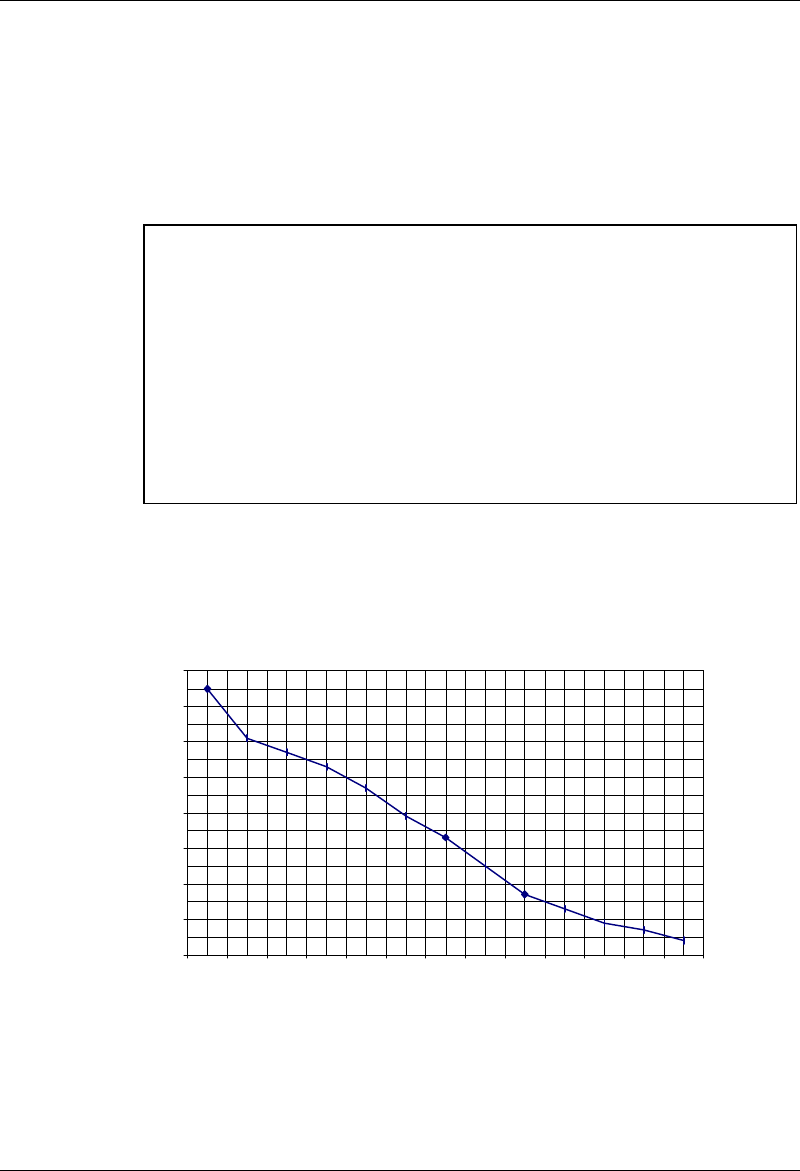
Device Setup and Management
BreezeNET PRO.11 Series 3-21 User’s Guide
7. On the receive side of the link, the screen displays a table showing
the packet number received, the frequency at which each packet
was transmitted, the Received Signal Strength Indicator (RSSI) for
each antenna and the antenna that was selected for reception (refer
to Figure 3.6). Use only the RSSI reading from the selected
antenna.
BreezeNET PRO.11 Series (SA-10)
Version: 4.211
Date: 25 Jun 1998 15:46:24
# Pack Len_Ant Idle_q Brker_q Data_q RSSI1 RSSI2 Bit_Err BER(M) Frq
60 400 1 5 16392 45 155 138 0 0 74
61 400 1 14 16392 39 155 139 0 0 64
62 400 2 14 16392 34 153 154 0 0 32
63 400 1 55 16392 48 154 153 0 0 25
64 400 2 95 16392 44 154 155 0 0 29
65 400 1 8 16392 52 155 151 0 0 34
66 400 1 7 16392 50 154 152 0 0 21
Hit any key to return >
Figure 3.6:Receive Statistics
8. The RSSI is given in arbitrary units. Use the following graph
(Figure 3.7) to correlate RSSI to dBm.
RSSI Vs. dBmRSSI Vs. dBm
50
60
70
80
90
100
110
120
130
-30 -40 -45 -50 -55 -60 -65 -70 -75 -78 -81 -83 -85
RF Level [dbm]RF Level [dbm]
RSSI Value
RSSI Value
Figure 3.7:RSSI to dBm Graph
9. Re-align the antennas until the maximum received signal strength
is attained. As you align the antennas, you will see that the RSSI
(received signal strength indicator) continually increases until it

Device Setup and Management
BreezeNET PRO.11 Series 3-22 User’s Guide
reaches a certain level after which the RSSI begins to decrease.
This is the maximum attainable RSSI level indicating optimum
receive antenna alignment.
10. Switch the functions of either side of the link (set the transmit unit
to receive and the receive unit to transmit) and repeat the procedure
to check the link from the opposite direction.
3.6.4. Using the Rx Packets per Frequency Histogram
Use the Display Rx Packets per Frequency option to see a histogram of the
number of frames received on each channel.
BreezeNET PRO.11 Series (SA-10)
Version: 4.211
Date: 25 Jun 1998 15:46:24
Max = 187
Min = 112
#
# # # # #
# # #### ### # # # # # ## # ## # # ## #
# ## ## # ## ######## ###### # ######## # ### ## # ## # # ## # ##
####### ## ######################################################### ########
#############################################################################
^ ^ ^ ^ ^ ^ ^ ^
2 +10 +20 +30 +40 +50 +60 +70
Hit any key to return >
Figure 3.8:Display Rx Packets per Frequency
Each point of the histogram line corresponds to a frequency. The base
frequency appears at the far left, and gradations are marked in steps of ten
along the line. A hash represents each packet received on a given frequency
(#). The Max and Min values indicate the highest and lowest number of
frames received across all frequencies. This graph is very useful for tracking
interference. Frequencies with low numbers of packets received probably
have more interference than other frequencies.

Device Setup and Management
BreezeNET PRO.11 Series 3-23 User’s Guide
3.7. Access Control Menu
Access Control functions enable the System Administrator or Installer to
limit access to Local Terminal Maintenance setup and configuration menus.
BreezeNET PRO.11 Series (SA-10)
Version: 4.211
Date: 25 Jun 1998 15:46:24
Access Control menu
===================
1 - Change Access Rights
2 - Change Installer Password
S - Show Current Access Right
Select option > 1
Figure 3.9: Access Control Menu
The Access Control menu includes the following options:
• Change Access Rights – This screen determines the level of access
rights to the BreezeNET PRO.11 unit’s setup and configuration menus.
When the unit is first installed, the default setting is option (1), Installer
and the default password is “user”:
• User – The Local Terminal Management menus are read-only for a
user who does not possess the correct password. The ESSID and
security parameters are hidden by asterisks (*) at this level.
• Installer – The installer has access to configure all required
parameters in the system configuration menu, as well as some of the
advanced settings. Access is password-protected. After
configuration, the installer should change access rights to option (0),
User. The installer can also change the installer password (see next
parameter).
• Technician – Only an Certified BreezeCOM Engineer possessing the
correct password can select this option to configure all the
parameters and settings.
• Change Installer Password – Type in the new password according to
the directions on screen. This screen changes the installer password to
prevent unauthorized persons from making any changes in system

Device Setup and Management
BreezeNET PRO.11 Series 3-24 User’s Guide
configuration and setup. The password is limited to eight printable
ASCII characters. This option is not available at User level.
• Show Current Access Right – This read-only screen presents the
current access right configuration.
Important: If you change the Installer password do not forget it, or you will be
unable to change the unit's access rights.

SA-PCR PRO.11 PC Card Installation, Setup, and Management
BreezeNET PRO.11 Series 4-1User’s Guide
4. SA-PCR PRO.11 PC CARD INSTALLATION,
SETUP, AND MANAGEMENT
The SA-PCR Card brings wireless connectivity to laptops and hand-held
devices. The latest version of the Card looks and functions very differently
from the previous version.
This chapter describes how to install the SA-PCR Card, and how to setup
and manage the Card using the SA-PCR Configuration and SA-PCR Site
Survey Windows applications.
4.1. Installing the SA-PCR Driver, and Applications
The following sections describe in detail:
• Checking the SA-PCR Package Contents.
• What to do before you install the SA-PCR.
• Installation Troubleshooting.
• Using the LED indicators to verify proper operation.
• Installing the SA-PCR applications.
• Uninstalling the SA-PCR drivers and applications.
4.1.1. Check Package Contents
The SA-PCR PRO.11 package should contain:
• SA-PCR PRO.11 PC Card.
• Drivers diskette and applications diskette.
• Quick Installation and Operation Guide.

SA-PCR PRO.11 PC Card Installation, Setup, and Management
BreezeNET PRO.11 Series 4-2User’s Guide
4.1.2. Before You Begin
Before installing, do the following:
• Verify that the AP unit with which the SA-PCR unit will work is an
AP-10 PRO.11. The SA-PCR PRO.11 will work only with an AP-10
PRO.11 unit.
• It is advisable to turn on the AP before installing the SA-PCR, thereby
enabling you to use the SA-PCR LEDs to check the status of the SA-
PCR when installation is complete. See section 4.1.4 for explanation of
the LEDs.
• Uninstall any previous versions of the drivers or applications (refer to
section 4.1.8). You can check the version of the current installation by
viewing the Maintenance tab of the Configuration application.
• When installing on Windows 95/98, verify that you have the Windows
CD with you, or that the Windows CAB files are installed on your local
hard disk in a directory whose name does not exceed 8 letters. When the
CAB files are on the disk, they are usually found in
C:\Windows\Options\Cabs.
• When installing on Windows NT, verify that you have the Windows NT
CD with you, or that the Windows NT distribution files are installed on
your local hard disk. During installation, enter the path of the
distribution files whenever a message appears asking for them.
4.1.3. Installing SA-PCR Drivers
The procedure for installing the SA-PCR drivers depends on your operating
system:
• For Windows 95, refer to section 4.1.3.1.
• For Windows 98, refer to section 4.1.3.2.
• For Windows NT, refer to section 4.1.3.3.
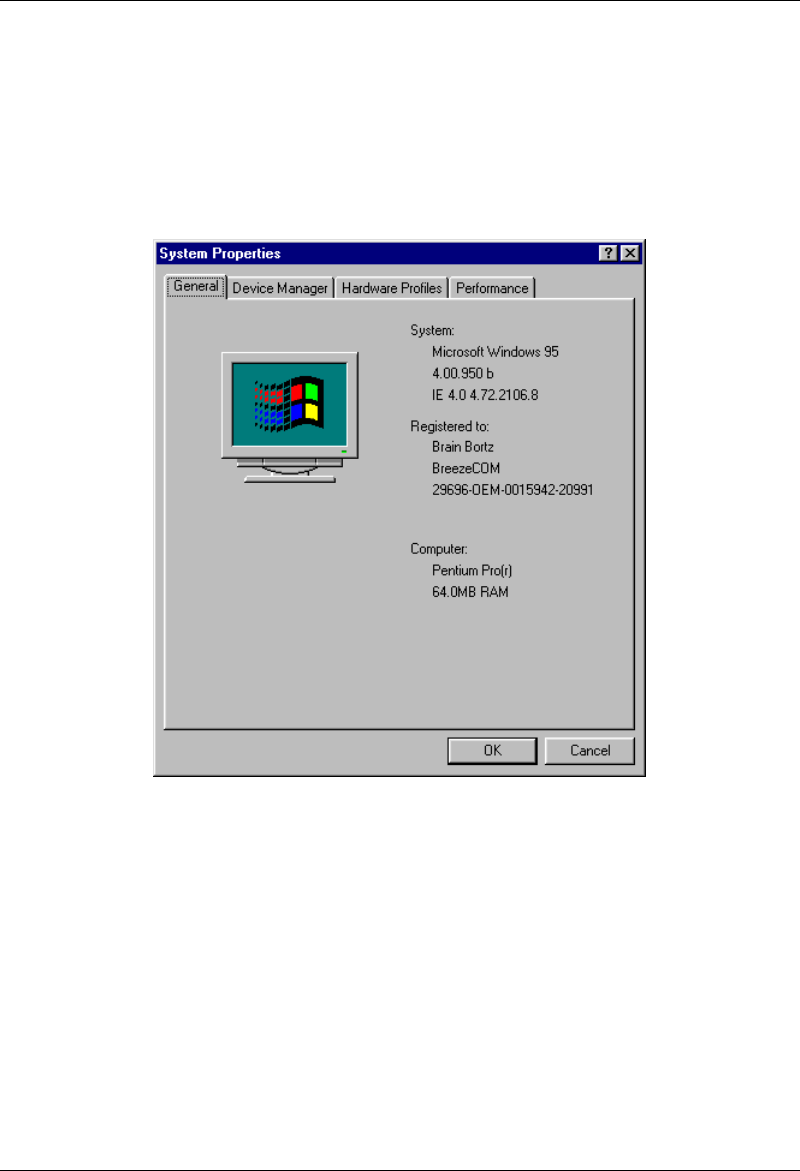
SA-PCR PRO.11 PC Card Installation, Setup, and Management
BreezeNET PRO.11 Series 4-3User’s Guide
4.1.3.1 Installation for Windows 95
• Check which version of Windows 95 is running on your machine as
follows:
1. Go to the Windows 95 desktop, right-click the My Computer icon,
and select Properties. The System Properties window opens.
Figure 4.1: System Properties Window – Windows 95B
2. Go to the General tab and look under the System heading. If the
phrase 4.00.950b appears, then you are using Windows 95B,
otherwise it is Windows 95A.
3. In case of Windows 95A, continue with section 4.1.3.1.1. In case of
Windows 95B, continue with section 4.1.3.1.2.
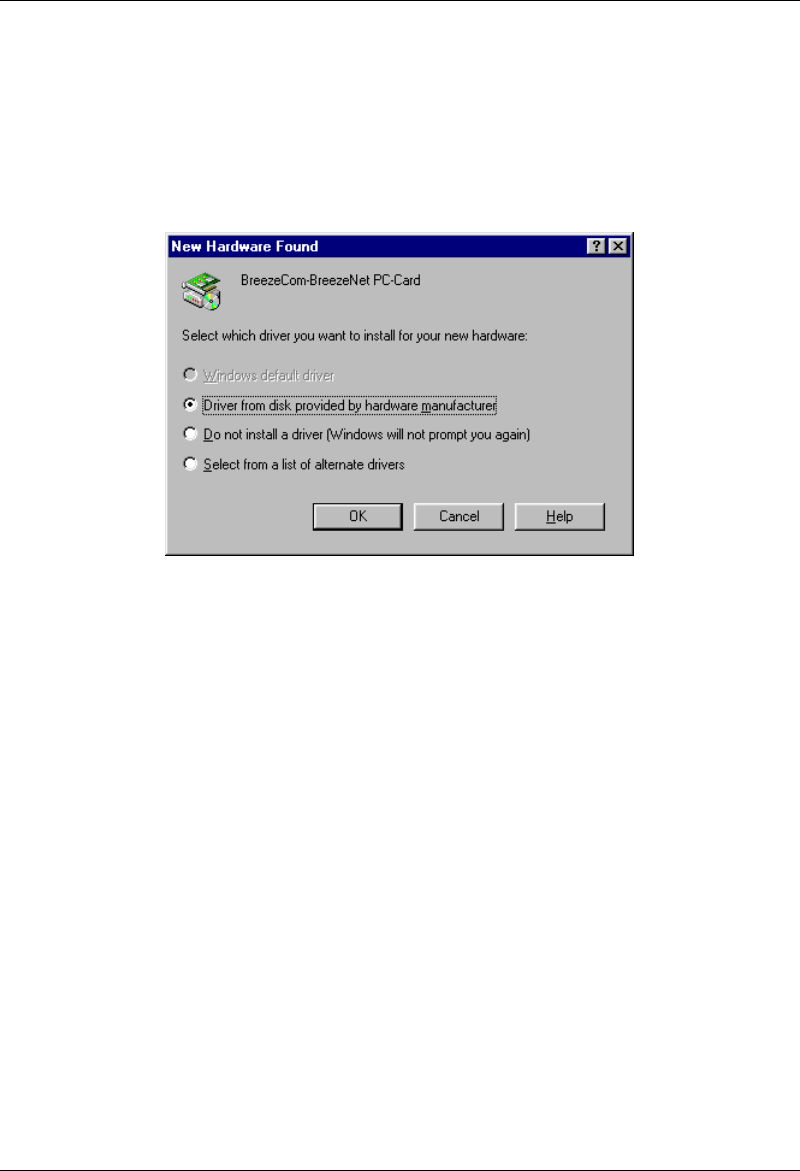
SA-PCR PRO.11 PC Card Installation, Setup, and Management
BreezeNET PRO.11 Series 4-4User’s Guide
4.1.3.1.1 Installation for Windows 95A
⇒⇒ To install on Windows 95A, do the following:
1. Insert the SA-PCR slot in the PCMCIA slot on your computer.
Windows 95 detects the unit and displays the New Hardware
Found window.
Figure 4.2: New Hardware Found Window
2. Select the Driver from disk provided by hardware manufacturer
option and press OK.
3. When prompted for the location of the driver, insert the
BreezeCOM drivers diskette and type A:\ and press OK. The
necessary files are copied from the diskette.
4. When the Please insert disk labeled Windows 95 CD-ROM
appears, insert the Windows 95 CD and press OK. If the
Windows 95 CAB files are located on your local hard disk, you can
point to that location (usually found at
\Windows\Options\Cabs).
5. If this is the first time a network card has been installed on this
machine, a network setup window may appear. It is not necessary
to fill out this window for the purposes of this installation.
6. Restart the computer.
7. Continue with section 4.1.4.

SA-PCR PRO.11 PC Card Installation, Setup, and Management
BreezeNET PRO.11 Series 4-5User’s Guide
4.1.3.1.2 Installation for Windows 95B
⇒⇒ To install on Windows 95B, do the following:
1. Insert the SA-PCR slot in the PCMCIA slot on your computer.
Windows 95 detects the unit, briefly displays the New Hardware
Found window, and then displays the Update Device Driver
Wizard window.
2. Insert the BreezeCOM drivers diskette and press Next. When
Windows 95 notifies it has found the driver, press Finish.
3. If the Windows 95 CAB files are not found automatically, the
message Please insert disk labeled Windows 95 CD-ROM appears.
Press OK.
4. If the file BRZCOM.VXD is not found, direct the window to A:\
and press OK.
5. If no other windows appear, the installation is complete. If the
Please insert disk labeled Windows 95 CD-ROM appears, press
OK, enter the path of the Windows 95 CAB files, and press OK.
Installation is now complete.
6. Restart the computer.
7. Continue with section 4.1.4.

SA-PCR PRO.11 PC Card Installation, Setup, and Management
BreezeNET PRO.11 Series 4-6User’s Guide
4.1.3.2 Installation for Windows 98
⇒ To install on Windows 98, do the following:
1. Insert the SA-PCR slot in the PCMCIA slot on your computer.
Windows detects the unit and displays the New Hardware Found
window.
2. When the Add New Hardware Wizard window appears, press Next.
3. Select the Search for best driver option and press Next.
4. Insert the BreezeCOM drivers diskette, select the Floppy disk
drives option, and press Next.
5. The installation wizard notifies you that the driver for the
BreezeCOM PCMCIA Wireless LAN Adapter has been located.
Press Next.
6. A window appears notifying you that the driver for the
BreezeCOM Wireless LAN Adapter has been installed. Press
Finish.
7. Restart the computer.
8. Continue with section 4.1.4.
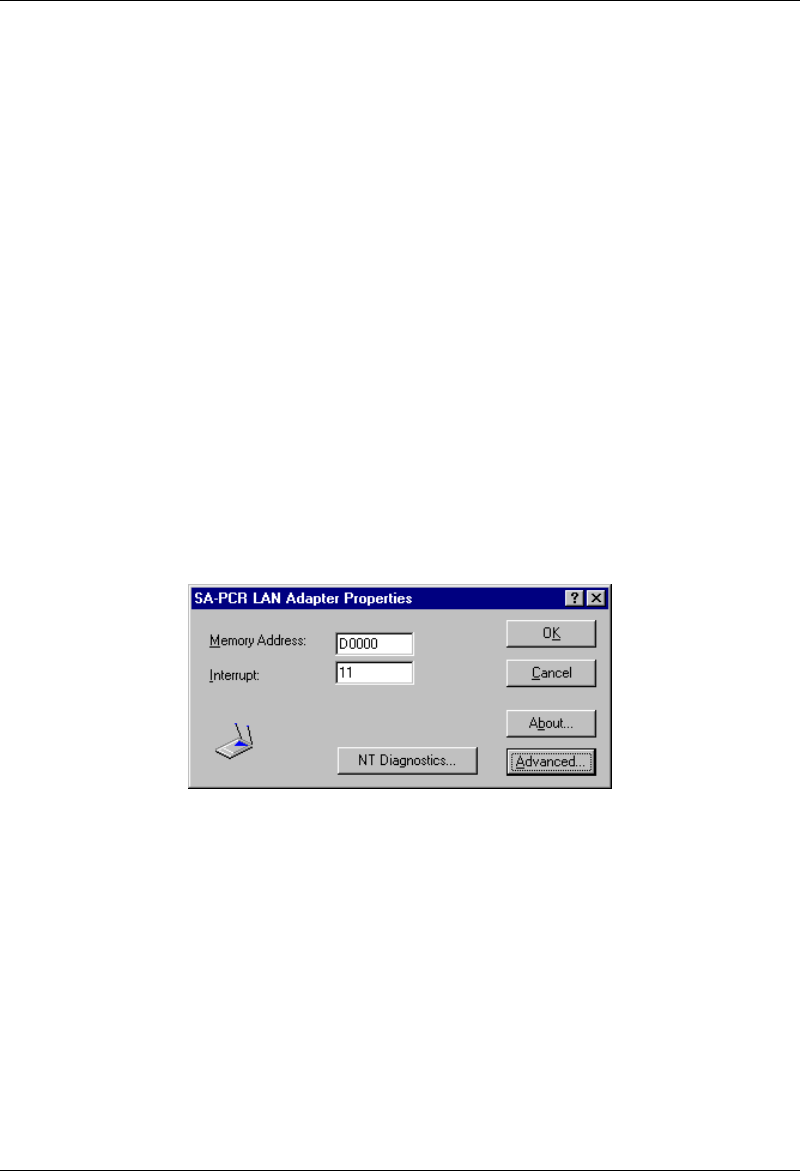
SA-PCR PRO.11 PC Card Installation, Setup, and Management
BreezeNET PRO.11 Series 4-7User’s Guide
4.1.3.3 Installation for Windows NT
⇒⇒ To install on Windows NT, do the following:
1. Press the Windows Start button, select Settings, and then select
Control Panel. Double-click on the Network icon.
2. If the message The Windows NT Networking is not installed. Do
you want to install it now?, continue with step 2a. If this message
does not appear, continue with step 2b.
a. Press Yes and choose Wired to the network. When a list of
supported network adapters appears, press Have Disk.
b. Go to the Adapters tab, press Add, and then press Have Disk.
3. Insert the BreezeCOM drivers diskette, enter the location of the
diskette (such as a:\) and press OK.
4. From the list choose BreezeNET Wireless LAN PC Card and press
OK. The SA-PCR LAN Adapter Properties window appears.
Figure 4.3: SA-PCR LAN Adapter Properties Window
5. The default settings are memory range D0000h to D3FFFh,
IRQ 11. In the following steps we will verify that these default
settings are acceptable for your machine.
Note: If the SA-PCR Configuration application is already installed, you can
access it directly by pressing Advanced.
6. Press the Windows Start button and select Run. Type WINMSD
and press OK. The Windows NT Diagnostics window appears.
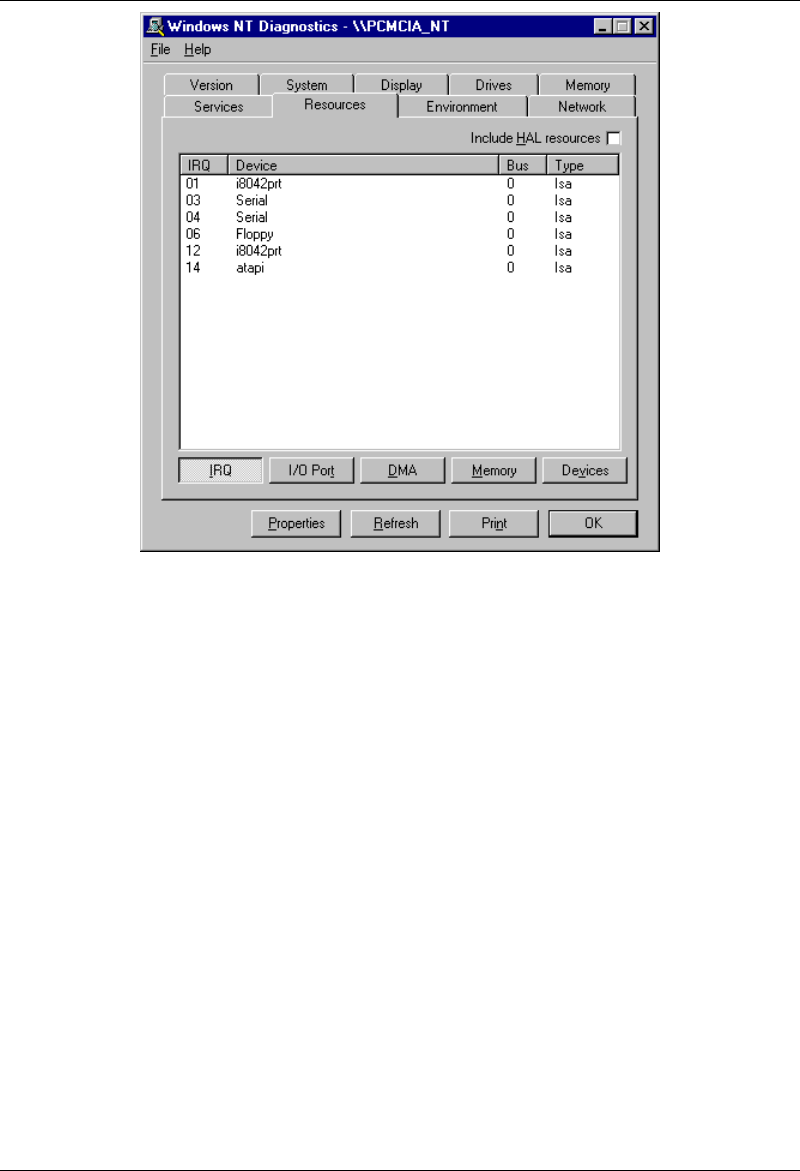
SA-PCR PRO.11 PC Card Installation, Setup, and Management
BreezeNET PRO.11 Series 4-8User’s Guide
Figure 4.4: Windows NT Diagnostics Window
7. Press IRQ and verify that IRQ 11 is not taken. If it is, find an IRQ
that is not taken. For example, in the illustration IRQ 2 is not taken.
8. Press Memory and verify that memory from D0000h to D3FFFh is
not taken. If it is, find another free memory location, such as
E0000h.
9. Return to the SA-PCR LAN Adapter Properties window (refer to
Figure 4.3). If the default values for Memory Address and Interrupt
are acceptable, press OK. Otherwise, enter new values and press
OK.
10. Press Close to close each installation window.
11. If configuration windows for other network components (such as
Protocol) appear, fill them in according to the instructions of your
network administrator.
12. Restart Windows NT.
13. Continue with section 4.1.4.

SA-PCR PRO.11 PC Card Installation, Setup, and Management
BreezeNET PRO.11 Series 4-9User’s Guide
4.1.4. Checking the LED Indicators
Verify proper operation of the SA-PCR using the LED indicators:
Color Description Meaning
Yellow Link Status Blink – Scanning
Solid –Associated
Green Data Traffic Blink – According to traffic
The LED indicators are useful only if there is an activated AP in the area.
4.1.5. Installing the Applications
If the SA-PCR applications have been previously installed, uninstall them
before reinstalling (refer to section 4.1.8).
⇒ To install the SA-PCR applications:
1. Insert the BreezeCOM application diskette.
2. Press the Windows Start button and select Run. Type A:\setup and
press OK.
3. In the Choose the Destination Location window, choose a location
for the installation, and press Next.
4. When the Setup Complete window appears, press Finish. Icons for
the applications are added to the Windows Programs menu, and a
SA-PCR Configuration icon is added in the Control Panel.
4.1.6. Initial Configuration
If your wireless network uses a non-default ESSID, enter the proper ESSID
as follows:
1. Start the SA-PCR Configuration application.
Press the Windows Start button, select Program, select
BreezeCOM, and then select Configuration.
2. Edit the ESSID parameter.
Go to the WLAN Paramters tab and enter the ESSID that matches
the AP unit.
3. Restart the computer.
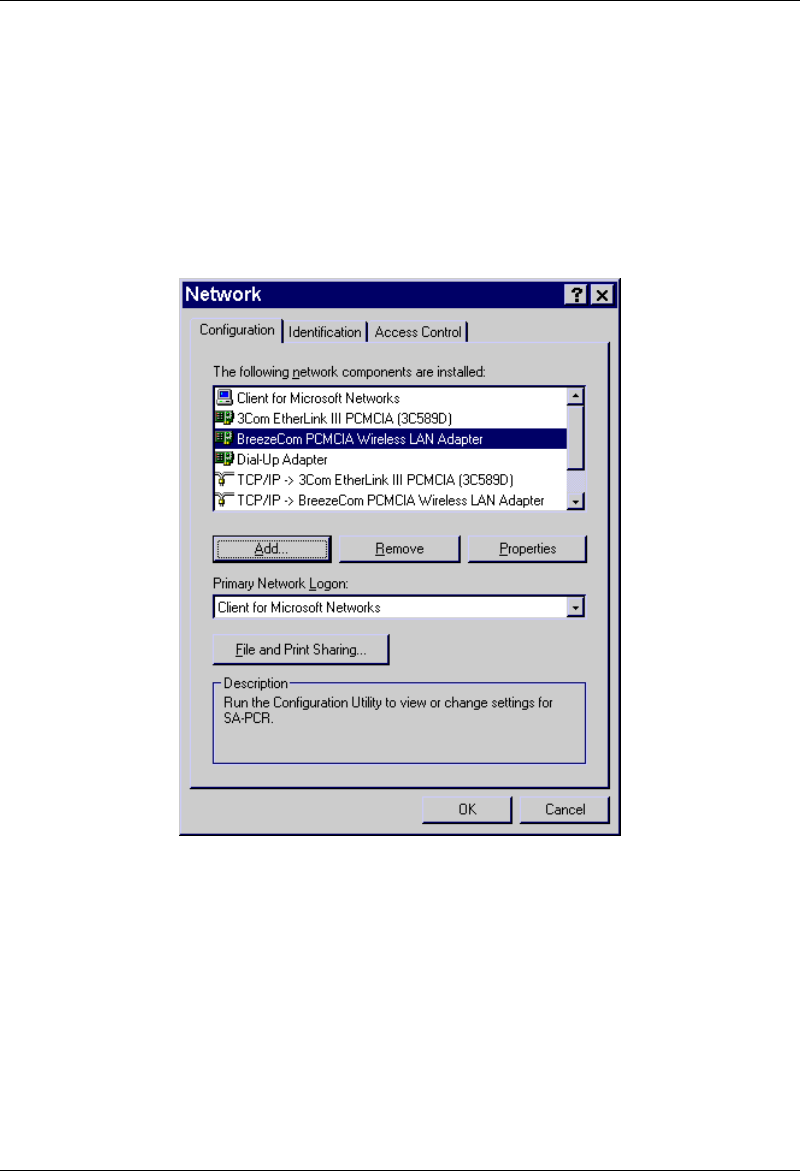
SA-PCR PRO.11 PC Card Installation, Setup, and Management
BreezeNET PRO.11 Series 4-10 User’s Guide
4.1.7. Troubleshooting Tips
This section provides hints regarding troubleshooting installation:
• Check for conflicting resources – Press the Windows Start button,
select Settings, and then select Control Panel. Double-click on the
Network icon and go to the Adapters tab. An exclamation point next to
the WLAN card indicates a conflict with another driver or device.
Figure 4.5: Network Window
• Check autoexec.bat and config.sys – Look for device drivers
or lines containing device or call commands in the autoexec.bat or
the config.sys files.
• Try to resolve resource conflicts by editing Windows parameters –
Go to the Windows desktop, right-click the My Computer icon, and
select Properties. Go to the Device Manager tab, select Network
Adapters, press Properties, and go to the Resources tab. Edit the
Memory Range and Interrupt parameters.

SA-PCR PRO.11 PC Card Installation, Setup, and Management
BreezeNET PRO.11 Series 4-11 User’s Guide
• Reinstall – After disabling conflicting resources, reinstall the SA-PCR.
4.1.8. Uninstalling SA-PCR Drivers and Applications
This section describes how to uninstall the SA-PCR drivers, and the
SA-PCR applications.
⇒⇒ To uninstall SA-PCR drivers:
If your operating system is Windows 95, you must first do the following:
1. Press the Windows Start button, select Settings, and then Select
Control Panel. Double click on the PC Card icon, select
BreezeCOM Wireless LAN PC Card and press Stop. Close all
active applications. Continue below.
If your operating system is Windows 98 or NT, start here.
1. Press the Windows Start button, select Settings, and then select
Control Panel. Double click on the Network icon, go to the
Configuration tab, select BreezeCOM Wireless LAN Adapter, and
press Remove.
2. When asked to restart the computer, press No.
3. Insert the BreezeCOM Drivers diskette. Press the Windows Start
button, select Run, and type a:\DrvClean.
4. When notified that the SA-PCR driver has been deleted, press
Setup.
5. Restart the computer.
⇒⇒ To uninstall SA-PCR applications:
1. Press the Windows Start button, select Settings, and then select
Control Panel. Double click on the Add/Remove Programs icon,
select BreezeCOM PCMCIA Applications and press Add/Remove.

SA-PCR PRO.11 PC Card Installation, Setup, and Management
BreezeNET PRO.11 Series 4-12 User’s Guide
4.2. Using the SA-PCR Configuration Application
This section describes how to use the SA-PCR Configuration application to
configure and manage your SA-PCR Card.
4.2.1. Accessing the Application
Open the SA-PCR Configuration application as follows:
• Press the Start button, select Programs, select the BreezeCOM
Application program group and choose Configuration.
The SA-PCR Configuration main window opens.
4.2.2. Main Window
The SA-PCR Configuration main window contains four tabs described in
the following sections. In addition, the main window contains the following
buttons:
• OK – Implements any changes you made and closes the window.
• Undo – Causes the window to display currently active values. This is
useful if you started changing values and you want to start again from
the current values.
• Cancel – Closes the window without implementing any changes you
made.
• Apply – Implements any changes you made but leaves the window
open.
4.2.3. Resetting the PC Card
⇒⇒ To reset the Card, close the Configuration and Site Survey applications
and then do one of the following:
• Restart the computer, or
• Stop the PC card then eject and reinsert the Card, or
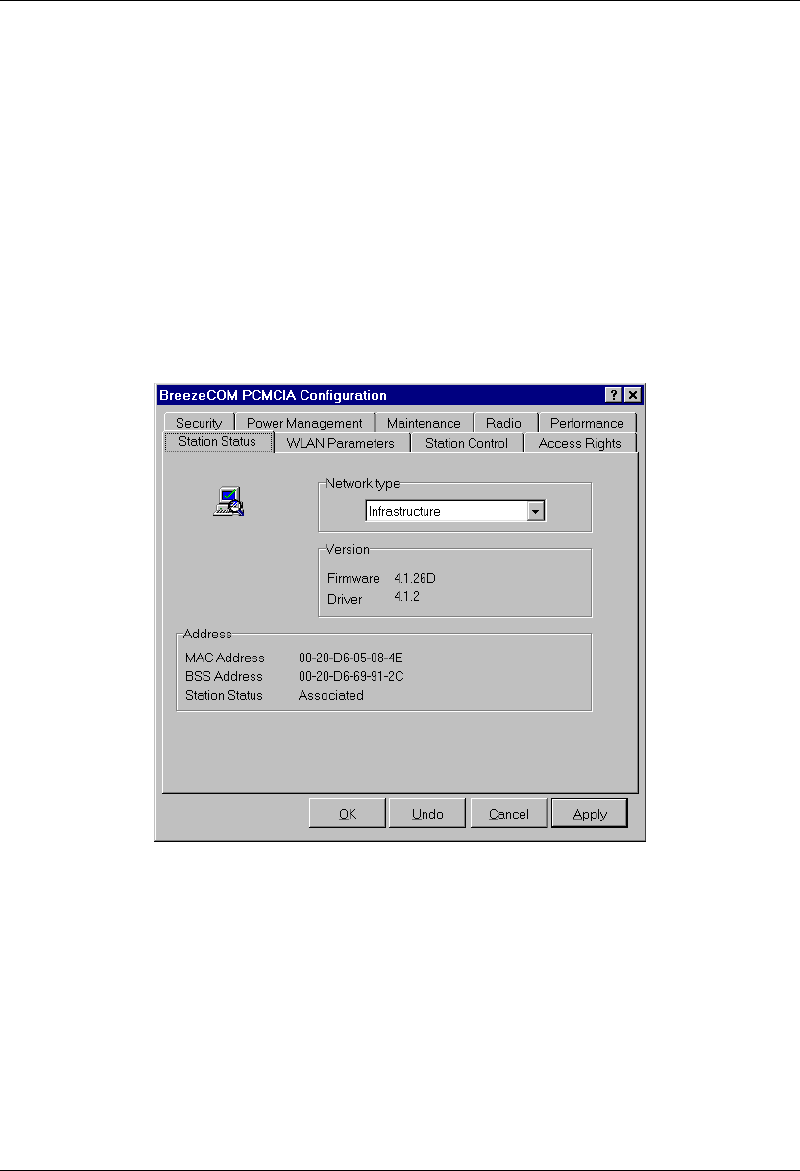
SA-PCR PRO.11 PC Card Installation, Setup, and Management
BreezeNET PRO.11 Series 4-13 User’s Guide
• Stop and refresh the driver as follows:
• Right-click the My Computer icon on the desktop, choose
Properties, and go to the Device Manager tab.
• Select Network Adapters, select BreezeCOM WLAN Adapter,
and press Refresh.
4.2.4. Station Status Tab
The Station Status tab of the SA-PCR Configuration application displays
basic information about the Card and its drivers and shows current Card
status.
Figure 4.6:Station Status Tab
The Station Status tab contains the following parameters:
• Firmware Version – Displays the version of unit’s current firmware
(internally installed software). The first two numbers of the firmware
and driver versions should be identical. The remaining numbers (if any)
indicate the minor version. The final letter indicates the hardware
version.
• Driver Version – Displays the version of unit’s current driver.
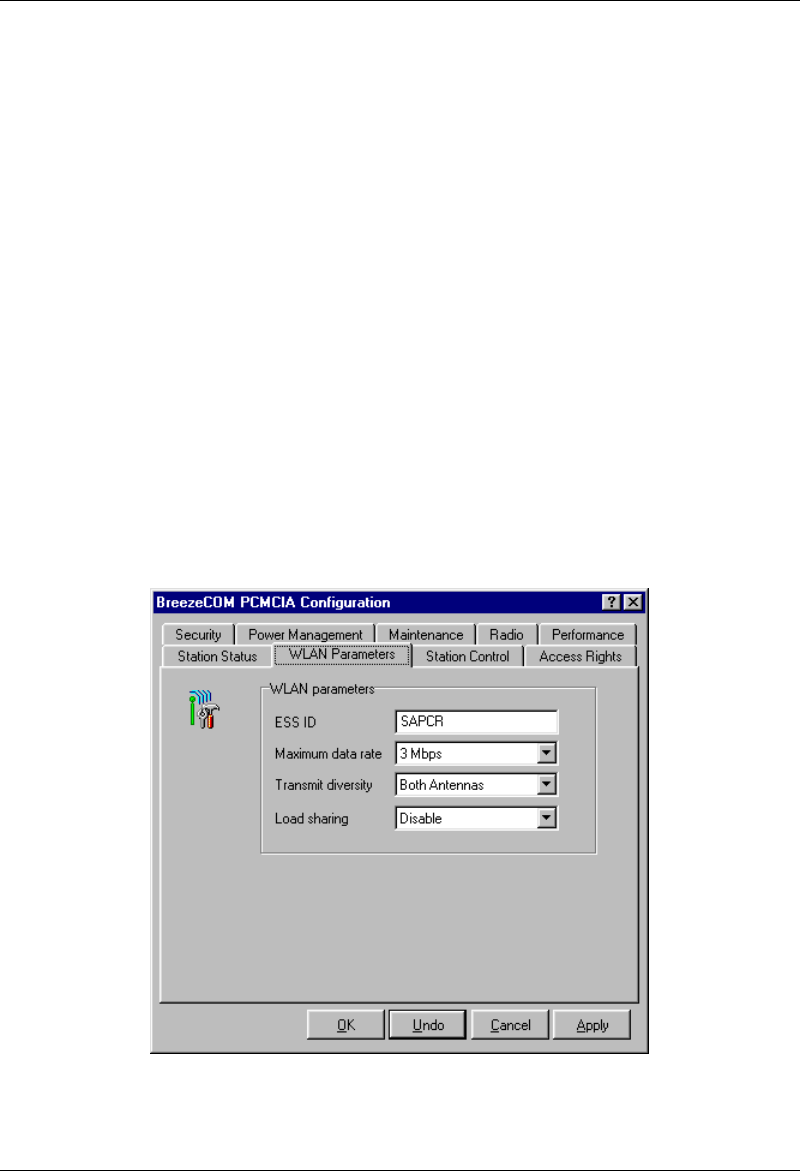
SA-PCR PRO.11 PC Card Installation, Setup, and Management
BreezeNET PRO.11 Series 4-14 User’s Guide
• MAC Address – Displays the unit’s unique IEEE MAC address.
• AP Address – The MAC address of the AP with which the unit is
currently associated.
• Station Status – Current status of the unit. There are three options:
• Scanning - The unit is searching for an AP with which to associate.
• Associated – The unit is associated with an AP and has adopted the
attached PC MAC address.
• Network Type – This value of this parameter should be infrastructure.
Note: Parameter changes take effect only after reset (refer to section 4.2.3,
Resetting the PC Card).
4.2.5. WLAN Parameters Tab
The WLAN Parameters tab of the SA-PCR Configuration application lets
you view and edit basic Wireless LAN parameters of the Card.
Figure 4.7:WLAN Parameters Tab

SA-PCR PRO.11 PC Card Installation, Setup, and Management
BreezeNET PRO.11 Series 4-15 User’s Guide
The WLAN Parameters tab contains the following parameters:
• ESSID – An ASCII string of up to 32 characters used to identify a
WLAN that prevents the unintentional merging of two co-located
WLANs. It is essential that the ESSID is set to the same value in all
stations and Access Points in the extended WLAN.
Note: The ESSID is case-sensitive.
• Maximum Data Rate – By default, the unit adaptively selects the
highest possible rate for transmission. Under certain conditions (for
range/speed trade-off) you may decide not to use the higher rates.
Possible values are 1, 2, or 3 Mbps.
• Transmit Diversity – By default, the unit dynamically selects the
antenna where reception and transmission is optimal. If your model has
an external antenna and uses only a single antenna, set Transmit
Diversity to transmit only from that single antenna. Antenna number one
is the antenna nearest the yellow LED.
• Load Sharing – When installing a Wireless LAN network in a high-
traffic environment, you can increase the aggregate throughput by
installing multiple APs to create co-located cells. Enable Load Sharing
to cause your stations to equally divide their traffic between the available
APs.
Note: Parameter changes take effect only after reset (refer to section 4.2.3,
Resetting the PC Card).
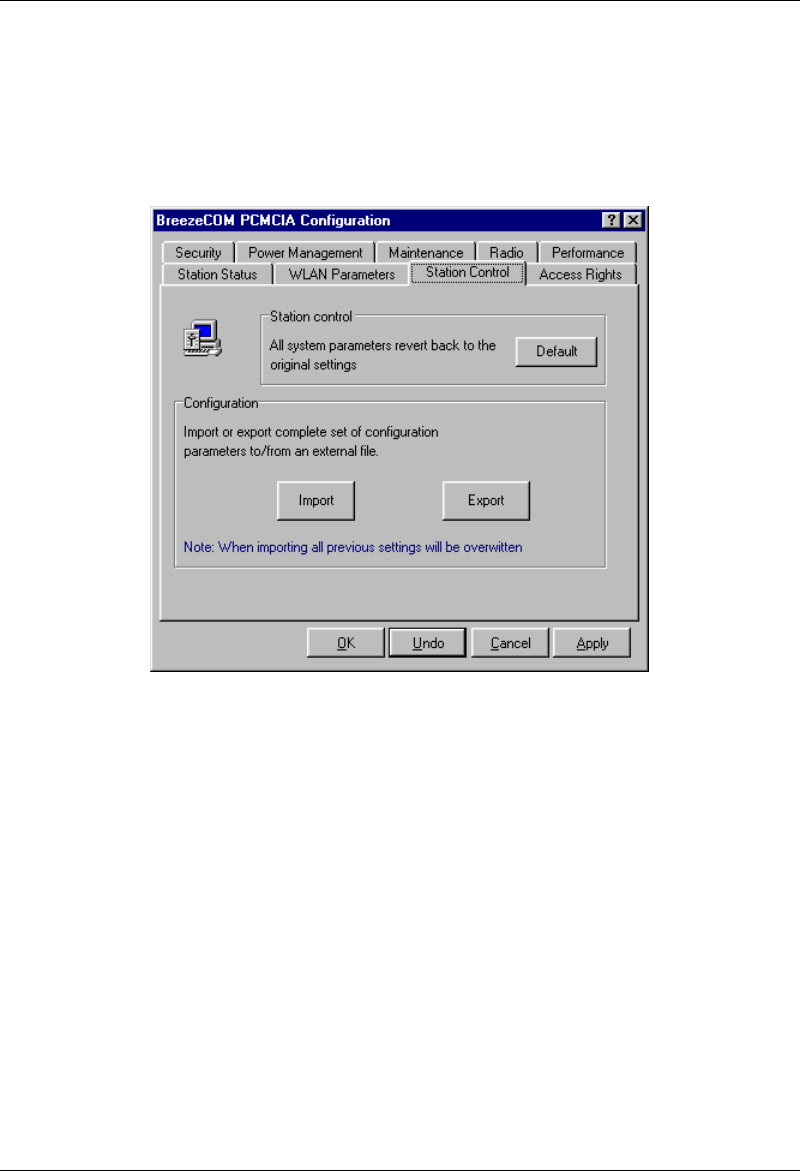
SA-PCR PRO.11 PC Card Installation, Setup, and Management
BreezeNET PRO.11 Series 4-16 User’s Guide
4.2.6. Station Control Tab
The Station Control tab of the SA-PCR Configuration application allows
you to return the Card to default configuration values, and export/import
configuration files.
Figure 4.8:Station Control Tab
The Station Control tab contains the Default button which returns all
parameters to factory default values.
To ease configuration of several units, you can configure one unit and then
save the configuration as a file (with a .BRZ extension). You can later
import the configuration file to other units.
• Import – Imports a configuration file to this unit, and overwrites all
previous settings.
• Export – Exports the current configuration of this unit to a file.
Note: Parameter changes take effect only after reset (refer to section 4.2.3,
Resetting the PC Card).
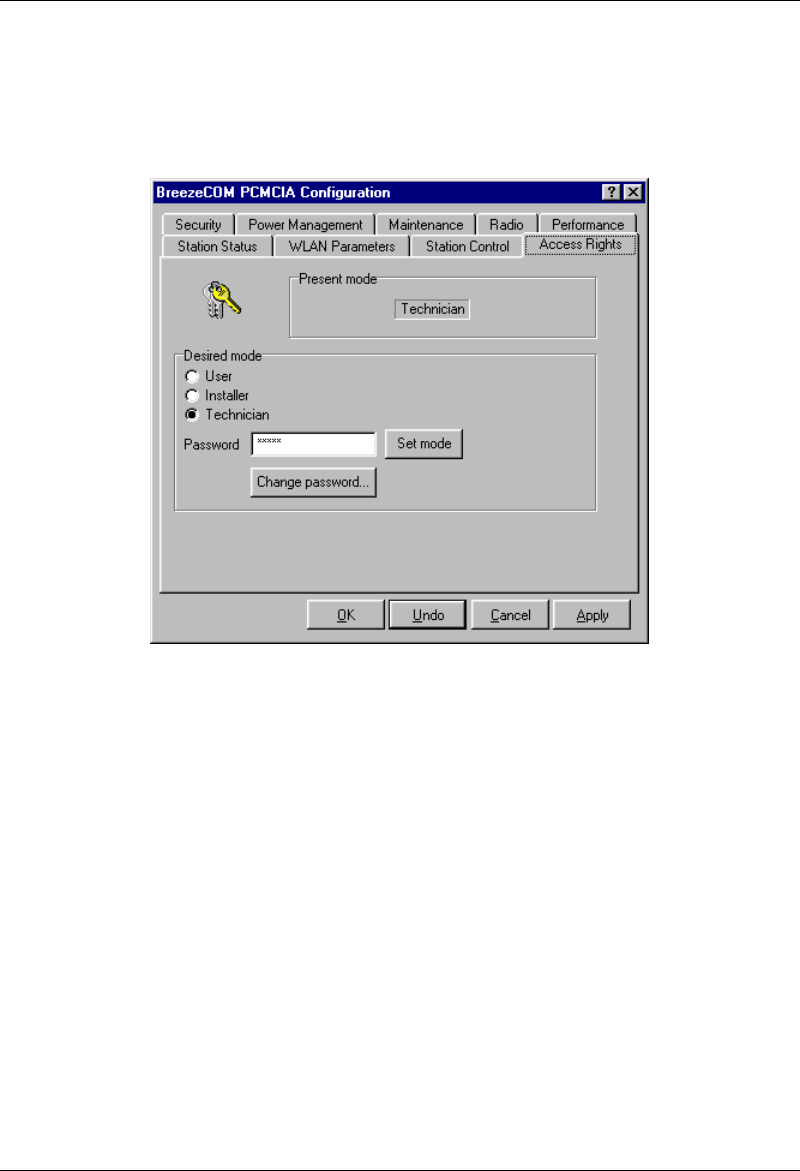
SA-PCR PRO.11 PC Card Installation, Setup, and Management
BreezeNET PRO.11 Series 4-17 User’s Guide
4.2.7. Access Rights Tab
The Access Rights tab of the SA-PCR Configuration application lets you
login to the Card as User, Installer, or Technician, and lets you change the
password.
Figure 4.9:Access Rights Tab
The Access Rights tab displays the current mode (User, Installer, or
Technician) in the Present Mode box. This mode determines the extent of
access to system parameters. Users can view some of the window tabs, but
cannot modify parameters. Installers can view all of the tabs and can modify
some of the values. Technician access rights are reserved for Certified
BreezeCOM Technicians.
When the Configuration application opens, it will begin at the same mode
that was active when it closed. If security is an issue, change the access
mode to User before you close the application. The first time the application
is opened, it is set to Installer access mode.
The default password for Installer mode is User. If security is an issue,
change the Installer password.

SA-PCR PRO.11 PC Card Installation, Setup, and Management
BreezeNET PRO.11 Series 4-18 User’s Guide
⇒⇒ To change the Access Rights mode:
1. Select the radio button next to the desired mode.
2. Type in the password. No password is necessary to lower the
access right level.
3. Press Set mode. The name of the new mode appears in the Present
Mode box.
⇒⇒ To change the password for Installer Access Rights mode:
1. Look at the Present Mode box to verify that you are in Installer
mode.
2. Press Change Password.
3. In the Change Password dialog box, type in the new password
twice and press OK.
The password has changed.
Important: If you change the Installer password do not forget it, or you will be
unable to change the unit's access rights.
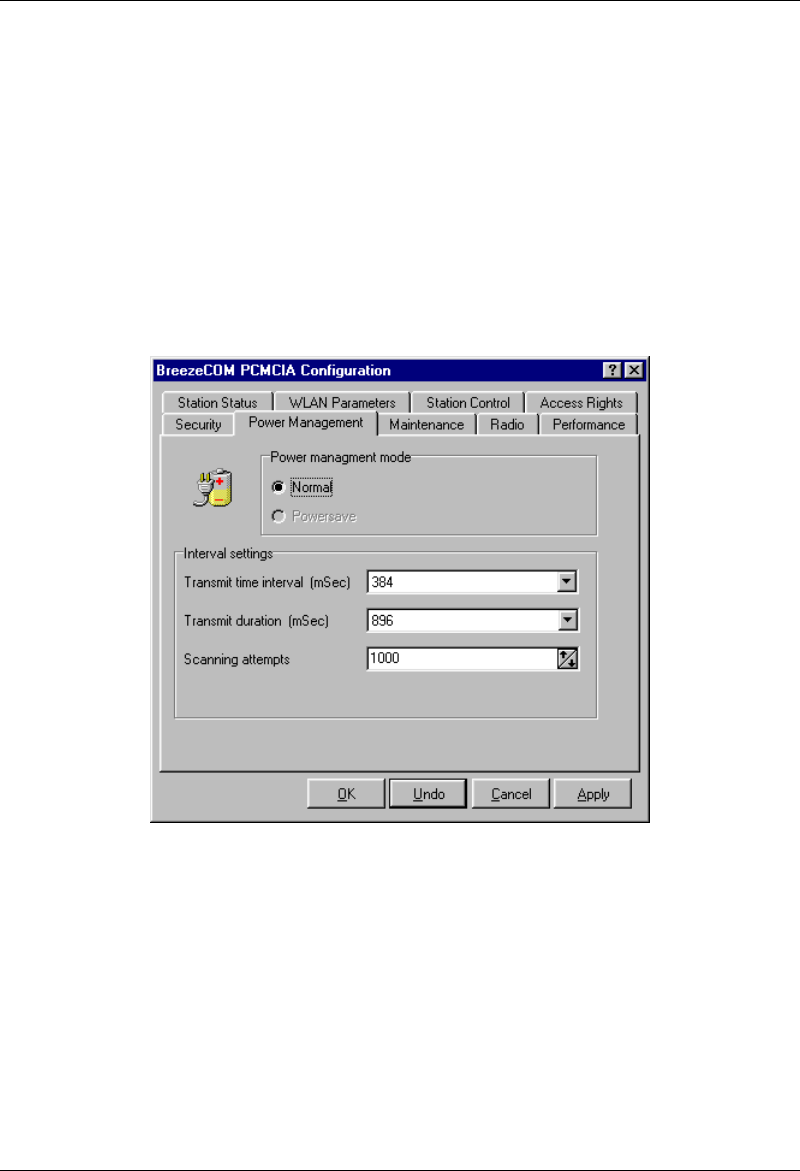
SA-PCR PRO.11 PC Card Installation, Setup, and Management
BreezeNET PRO.11 Series 4-19 User’s Guide
4.2.8. Power Management Tab
Note: The Power Management tab is not yet implemented.
The Power Management tab of the SA-PCR Configuration application
allows you to enable/disable power management mode, and to fine tune the
power management mode parameters.
This tab is not visible when in User login mode. When in Installer login
mode, you can see the parameters. When in Technician login mode, can edit
the parameters.
Figure 4.10:Power Management Tab
The Power Management tab contains the following parameters:
• Power Management Mode – Powersave mode enables WLAN units
(such as laptops or hand-held devices) to conserve battery power. To
enable this feature you must also enable power saving for the AP.
When power management mode is enabled, the unit “sleeps” most of the
time, and “wakes up” occasionally to transmit to the AP. The Interval
Settings parameters affect the power management algorithm:
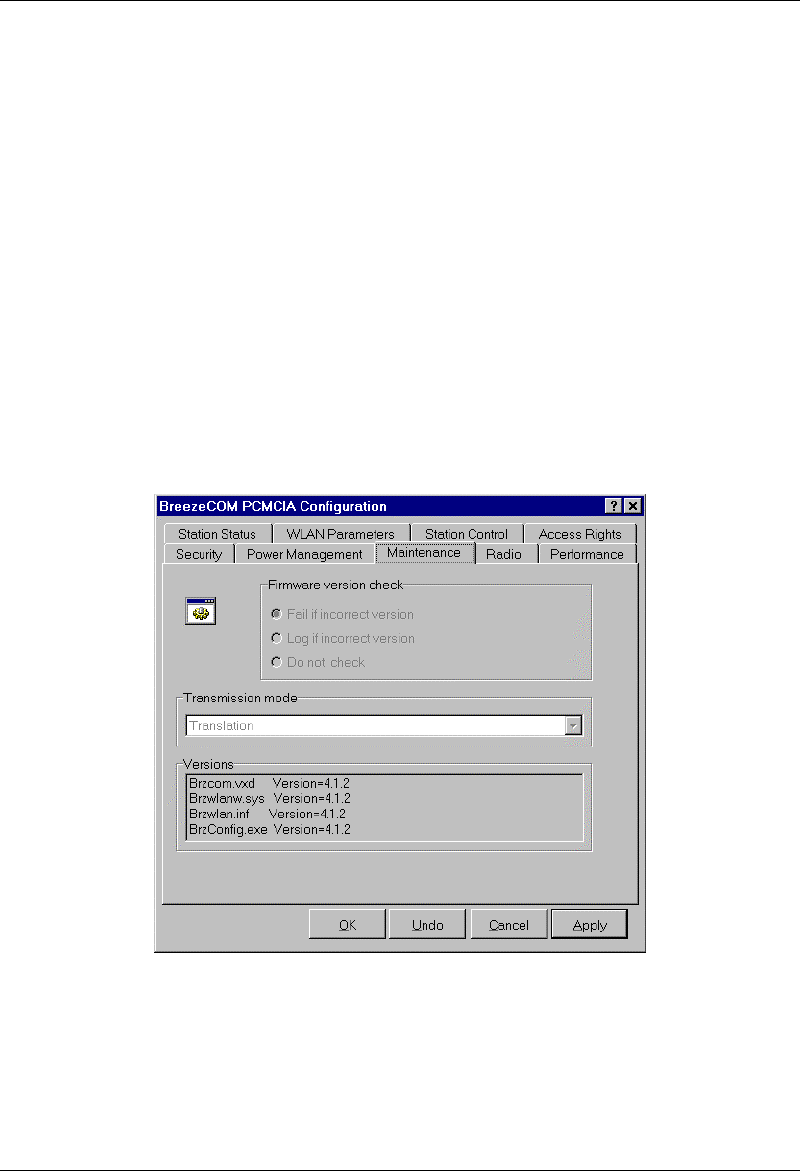
SA-PCR PRO.11 PC Card Installation, Setup, and Management
BreezeNET PRO.11 Series 4-20 User’s Guide
• Transmit Time Interval (msec) – At what intervals the unit “wakes
up”.
• Transmit Duration (msec) – How long the unit remains “awake”.
• Scanning Attempts – How many times the “awake” unit cycles through
the frequencies, before “going back to sleep”.
4.2.9. Maintenance Tab
The Maintenance tab of the SA-PCR Configuration application allows you
to cause the unit to verify firmware/driver compatibility, and set how the
unit handles 802.3 packets.
This tab is not visible when in User login mode. When in Installer login
mode, you can see the parameters. When in Technician login mode, can edit
the parameters.
Figure 4.11:Maintenance Tab
The Maintenance tab contains the following parameters:
• Firmware Version Check – Whether the unit checks compatibility of
current firmware version to current drivers, and what to do if they are
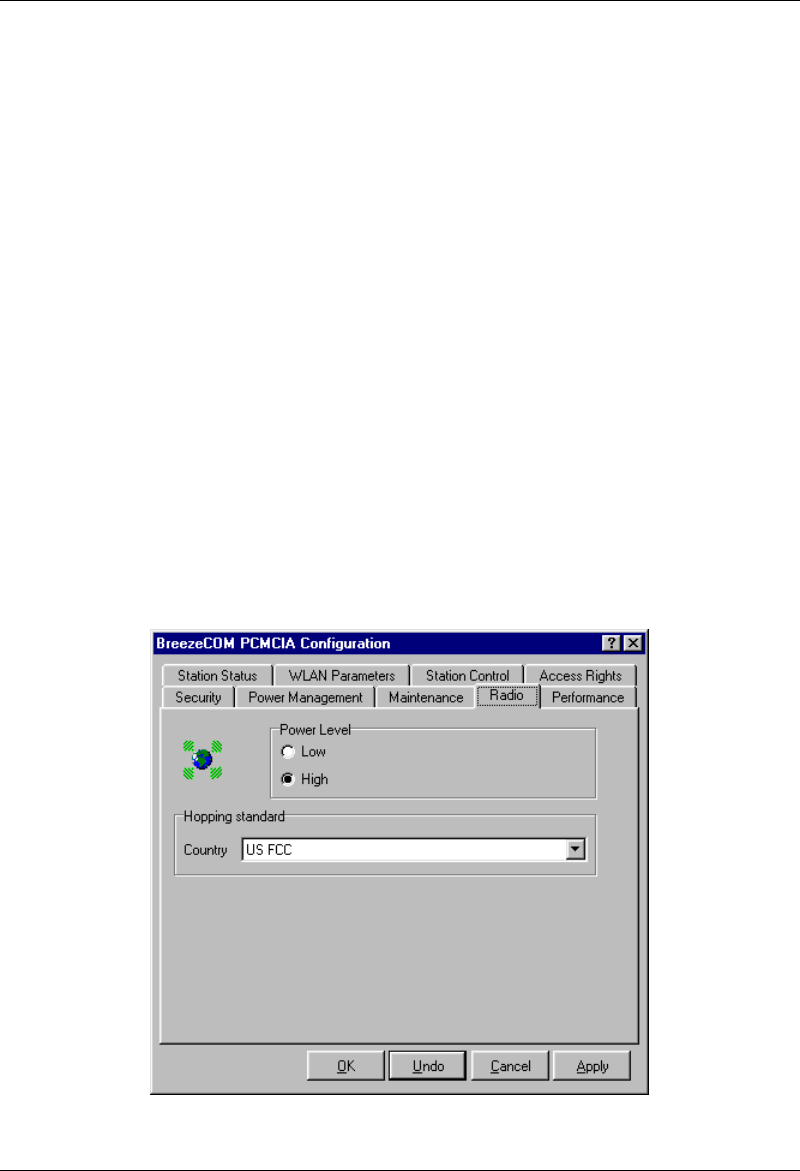
SA-PCR PRO.11 PC Card Installation, Setup, and Management
BreezeNET PRO.11 Series 4-21 User’s Guide
incompatible. Detailed information about the versions appears at the
bottom of the window.
• Transmission Mode – This parameter cannot be modified by the
Installer.
• Versions – Windows drivers are divided into three files: Brzcom.vxd,
Brzwlanw.sys, and Brzwlan.inf. The version number of all these files
must be identical. control information of these files is displayed.
The Configuration application file is called BrzConfig.exe. The first two
numbers of the application version must match the first two numbers of
the drivers.
4.2.10. Radio Tab
The Radio tab of the SA-PCR Configuration application allows you to set
the power level of the unit and choose a hopping standard.
This tab is not visible when in User login mode. When in Installer login
mode, you can see the parameters. When in Technician login mode, can edit
the parameters.
Figure 4.12:Radio Tab
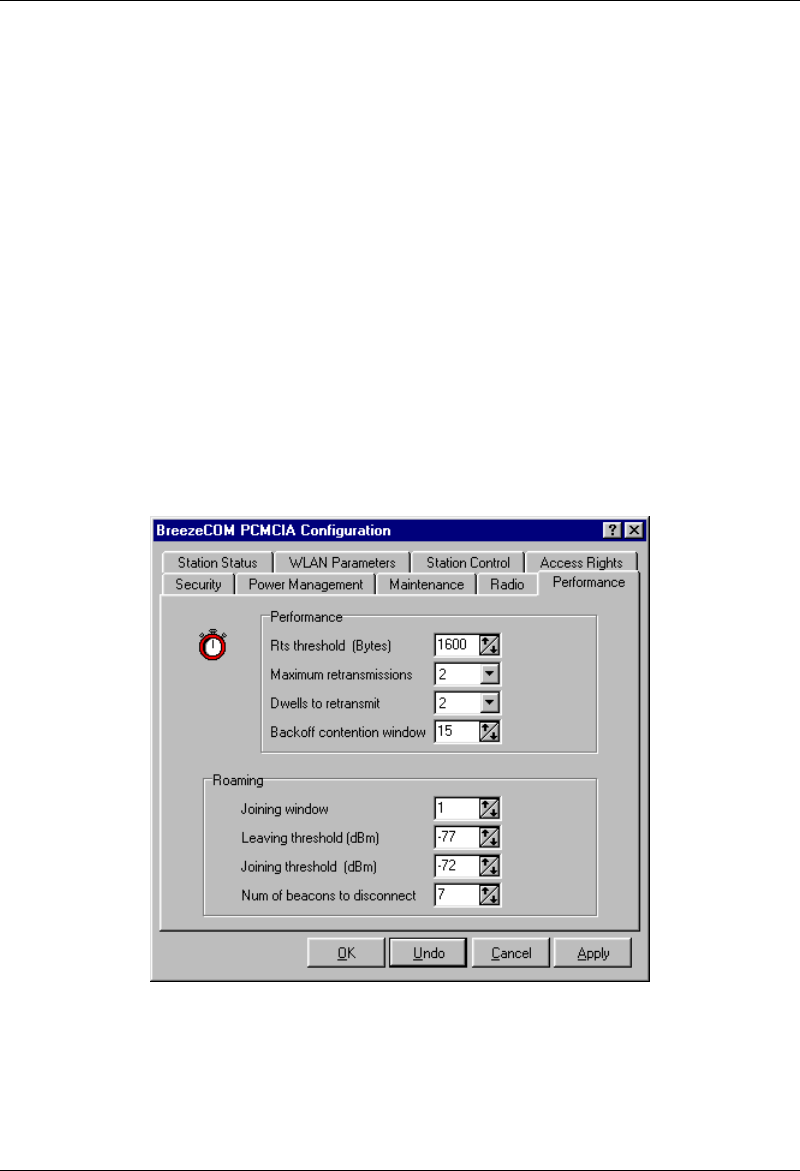
SA-PCR PRO.11 PC Card Installation, Setup, and Management
BreezeNET PRO.11 Series 4-22 User’s Guide
The Radio tab contains the following parameters:
• Power Level – Level of power at which the unit is operating. There are
two possibilities, Low or High.
• Hopping Standard – The Hopping Standard is a set of rules regarding
the radio transmission standard allowed in each country. Units will work
together only if set to the same hopping standard. Use this parameter to
set the unit’s hopping standard to that of the relevant country.
4.2.11. Performance Tab
The Performance tab of the SA-PCR Configuration application allows you
to fine-tune performance and roaming parameters.
This tab is not visible when in User login mode. When in Installer login
mode, you can see the parameters. When in Technician login mode, can edit
the parameters. Only major parameters are described below.
Figure 4.13:Performance Tab
The Performance tab contains the following important parameter:
• Rts threshold (bytes) – Minimum packet size to require an RTS
(Request To Send). For packets smaller than this threshold, an RTS is

SA-PCR PRO.11 PC Card Installation, Setup, and Management
BreezeNET PRO.11 Series 4-23 User’s Guide
not sent and the packet is transmitted directly to the WLAN. If your
wireless network has more than 7 stations (all SA-PCRs, or a mix of SA-
PCRs and SA-10/40s), set the RTS Threshold to 1600.
4.3. Using the SA-PCR Site Survey Application
This section describes how to use the SA-PCR Site Survey application to
manage your SA-PCR Card. The Site Survey application keeps you
informed of the signal strength your unit is receiving.
You can run a Site Survey to compare reception at various locations. This is
extremely useful when first setting up the wireless LAN, since you can
easily determine where reception is good or bad, and where many Access
Points overlap.
The following sections describe how to access the Site Survey application,
how to read the main Site Survey window, and how to perform a site
survey.
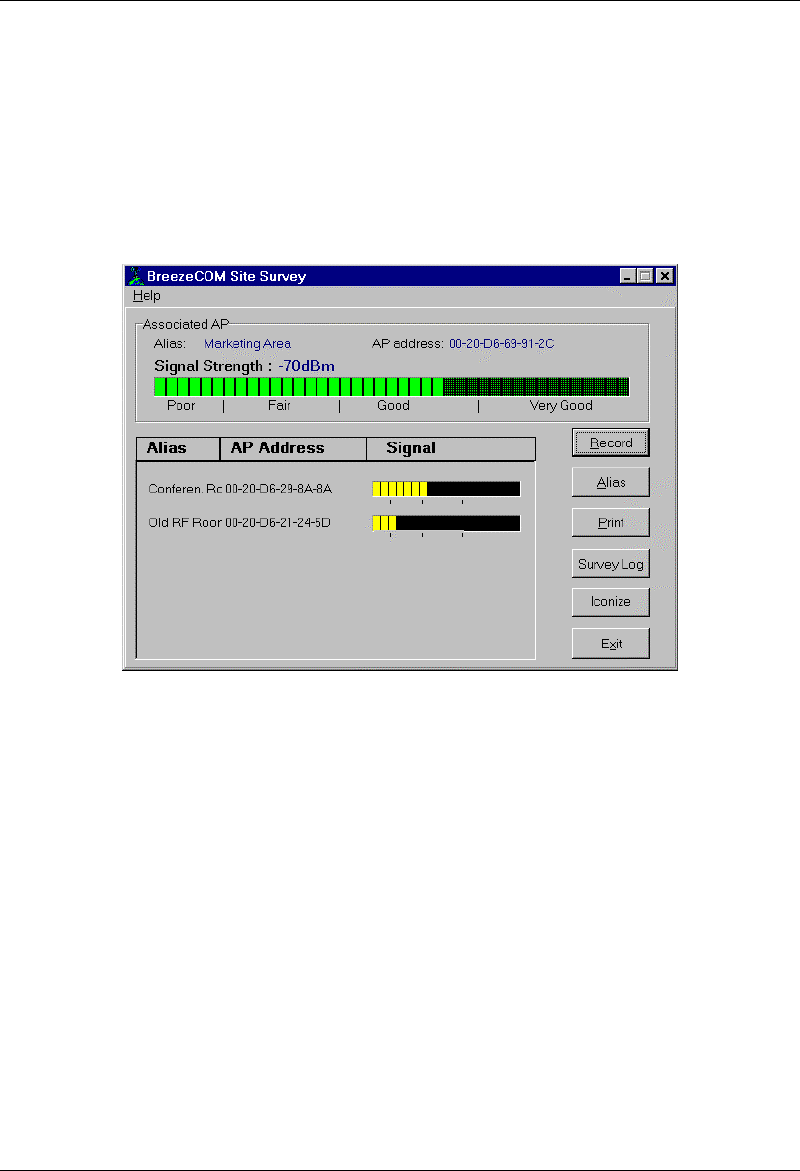
SA-PCR PRO.11 PC Card Installation, Setup, and Management
BreezeNET PRO.11 Series 4-24 User’s Guide
4.3.1. Accessing the SA-PCR Site Survey Application
Open the SA-PCR Site Survey application as follows:
• Press the Start button, select Programs, select the BreezeCOM
Application program group and choose Site Survey.
The SA-PCR Configuration main window opens.
Figure 4.14:SA-PCR Site Survey
4.3.2. SA-PCR Site Survey Main Window
The Site Survey main window contains the following sections:
• Associated AP – This section, located at the top of the window, displays
various parameters regarding the Access Point with which the unit is
currently associated.
• Alias – The alias you have assigned to the AP that the SA-PCR is
currently associated with. To assign aliases to AP units, press the
Alias button. If no alias has been assigned to the AP, this field
displays “no alias”.
• AP Address – The IEEE MAC address of the AP.

SA-PCR PRO.11 PC Card Installation, Setup, and Management
BreezeNET PRO.11 Series 4-25 User’s Guide
• Signal Strength – The strength of the signal from the AP in dBm.
The table below maps the signal strength indicators to dBm ranges:
Signal Poor Fair Good Very Good
dBm less than -74 -74 to -69 -68 to -61 greater than -61
• Signal Bar – The signal bar is a graphical representation of the signal
strength. The longer the bar, the stronger the signal. As signal
strength drops, the bar changes from green, to yellow, to red
• Neighbor APs – This section, located at the bottom of the window,
displays nearby APs (up to 4)from which the station is receiving a
signal. For each AP, the following parameters are displayed:
• Alias – The alias you have assigned to the AP. To assign aliases to
AP units, press the Alias button. If no alias has been assigned to the
AP, this field displays “no alias”.
• AP Address – The IEEE MAC address of the AP.
• Signal – A miniature signal bar indicating the current signal strength
from the AP. When you hold the cursor over the line, the exact value
appears.
• Buttons – The following buttons appear on the right side of the Site
Survey window. Several of the buttons are used in the course of
performing a Site Survey as described in section 4.3.3:
• Record – Records the signal strength of the current location in the
Survey Log, as well as all neighboring APs. In the Record window,
you can add the name of the location and a remark. You can view the
Survey Log by pressing Survey Log.
• Alias – Lets you assign alias names to APs. In the Alias window,
enter the AP address and the desired alias. For convenience, you can
drag and drop the address of the associated AP from the main
window into the Alias window. For neighbor APs, you should use
Ctrl-C to copy the AP Address from the main window.
• Print – Opens a Site Survey report showing the information in the
Survey Log, including neighbor APs. You can print the file by
pressing the Printer button, or save the file by pressing the Diskette
button. You can save the file as text, or as a QRP file viewable using
this application.
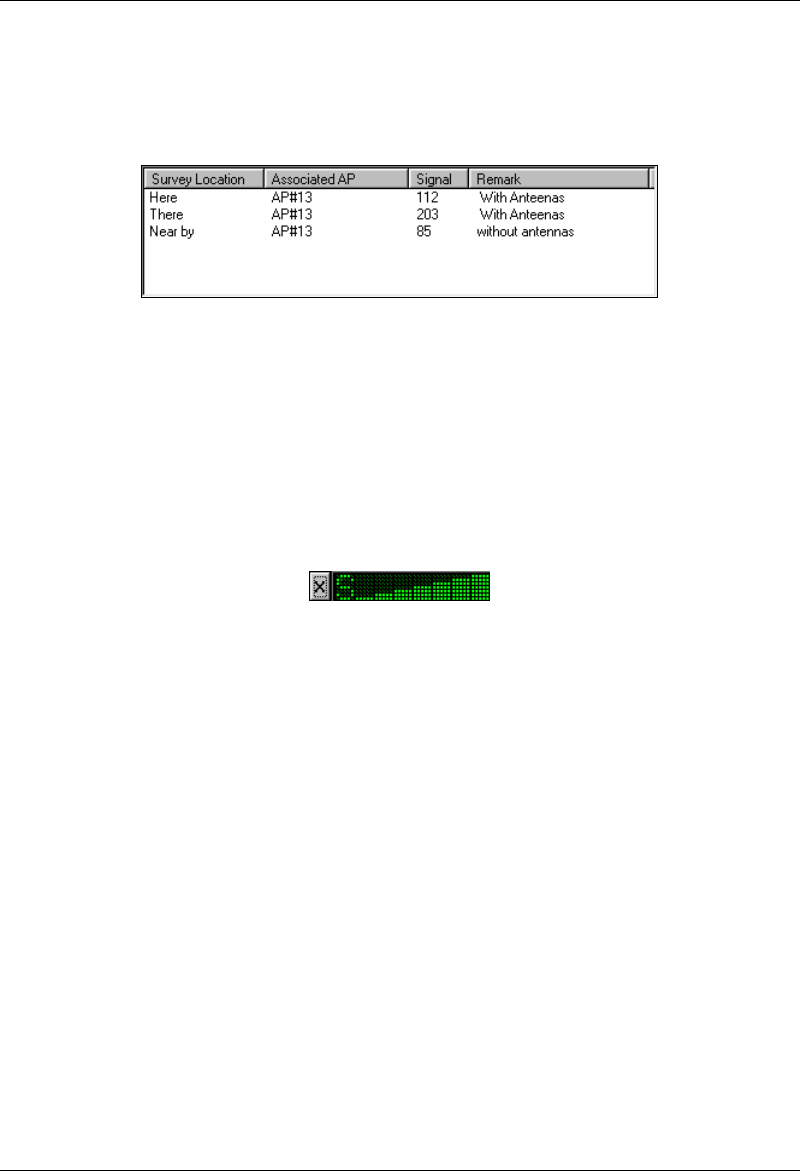
SA-PCR PRO.11 PC Card Installation, Setup, and Management
BreezeNET PRO.11 Series 4-26 User’s Guide
• Survey Log – Opens the Survey Log at the bottom of the main
window. The Survey Log displays the information recorded using
the Record button. Press Clear Log to clear the Survey Log. Press
Delete Last to delete the last recorded reading.
Figure 4.15:Survey Log
• Iconize – Closes the Site Survey window and opens the Connection
Quality Graph that indicates current signal strength of the associated
AP at a glance. The Graph can be moved anywhere on the screen,
and will always appear on top of other applications. Hold the cursor
over the X to see the signal strength in units. Press the X to close the
Graph and open the Site Survey window.
Figure 4.16:Connection Quality Graph

SA-PCR PRO.11 PC Card Installation, Setup, and Management
BreezeNET PRO.11 Series 4-27 User’s Guide
4.3.3. Performing a Site Survey with the SA-PCR
You can run a Site Survey to compare reception at various locations. This is
extremely useful when first setting up the wireless LAN, since you can
easily determine where reception is good or bad, and where many Access
Points overlap.
⇒⇒ To run a Site Survey:
1. Open the Site Survey application.
2. Press Survey Log to expand the bottom of the Site Survey window.
3. Bring the station to a new location.
4. Press Record. Type in the name of the location and a remark, and
press OK. The signal details of the current location appear in the
Survey Log at the bottom of the window.
5. Repeat steps 2 and 3 with other locations. The recorded readings
should give you a good idea of where reception is good or bad, and
where many APs overlap unnecessarily.
6. When you are done recording, press Print. A site survey report
appears containing information about each recorded location
including signal strength of associated AP and of neighbor APs.
You can print the file by pressing the Print button, or save the file
by pressing the Diskette button. You can save the file as text, or as
a QRP file viewable using this application only.

Planning and Installing Wireless LANs
BreezeNET PRO.11 Series 5-1User’s Guide
5. PLANNING AND INSTALLING
WIRELESS LANS
All products in the BreezeNET PRO.11 Series are available in several
models: standard, “D”, and “DE”. The standard model is equipped with two
integrated 2 dBi omni-directional antennas and is suitable for indoor, short-
to-medium range installations. The “D” and “DE” models are equipped with
two customized female connectors for use with a range of external antennas.
This chapter describes various possible system configurations, lists points to
consider when performing indoor and outdoor installations, presents
guidelines and restrictions regarding external antenna installation, and also
describes some antennas that work well with BreezeNET PRO.11 units.
5.1. System Configurations
This chapter describes various wireless LAN configurations, and how to set
them up:
• Single Cell Configuration – The wireless LAN consists of an Access
Point and the wireless workstations associated with it.
• Overlapping Cell Configuration – The wireless LAN consists of two
or more adjacent Access Points whose coverage slightly overlaps.
• Multicell Configuration – The wireless LAN consists of several Access
Points installed in the same location. This creates a common coverage
area that increases aggregate throughput.
• Multi-Hop Configuration – The wireless LAN contains AP-WB pairs
that extend the range of the wireless LAN.
Many wireless LANs contain several of these configurations at different
points in system. The Single Cell configurations is the most basic, and the
other configurations build upon it.

Planning and Installing Wireless LANs
BreezeNET PRO.11 Series 5-2User’s Guide
5.1.1. Single Cell Configuration
A basic BreezeNET cell consists of an Access Point and the wireless
workstations associated with it. You can convert most workstations (PCs,
X-Terminals, Apple, Digital, SUN, HP, IBM and others) that are equipped
with an Ethernet network interface card (NIC) to wireless workstations
simply by connecting a BreezeNET SA-10 PRO.11 Station Adapter. You can
convert most laptop computers with a PCMCIA slot into a wireless mobile
station by using the SA-PCR PRO.11 PCMCIA Card.
There are three types of Single Cell Configuration:
• Point-to-Point
• Point-to-Multipoint
• Mobile Applications
Each type is explained in the following sections.
5.1.1.1 Point-to-Point
Point-to-Point installations (refer to Figure 5.1) require directional antennas
at either end of the link. To select the best antenna for a specific application,
consider the following factors:
• Distance between sites
• Required throughput
• Clearance between sites
• Cable length.
Refer to the range tables (section 5.3.7) to determine the best combination of
antennas for your application.
5.1.1.2 Point-to-Multipoint
Point-to-Multipoint applications consist of one or more APs at the central
site and several remote stations and bridges (SA-10, SA-40, WB-10). In this
case, use an Omni-6 antenna with the Access Point because of its 360°
radiation pattern. Ιn the United States, the Omni-7.2 antenna (which also has
a 360° radiation pattern but has a wider range) can also be used. The
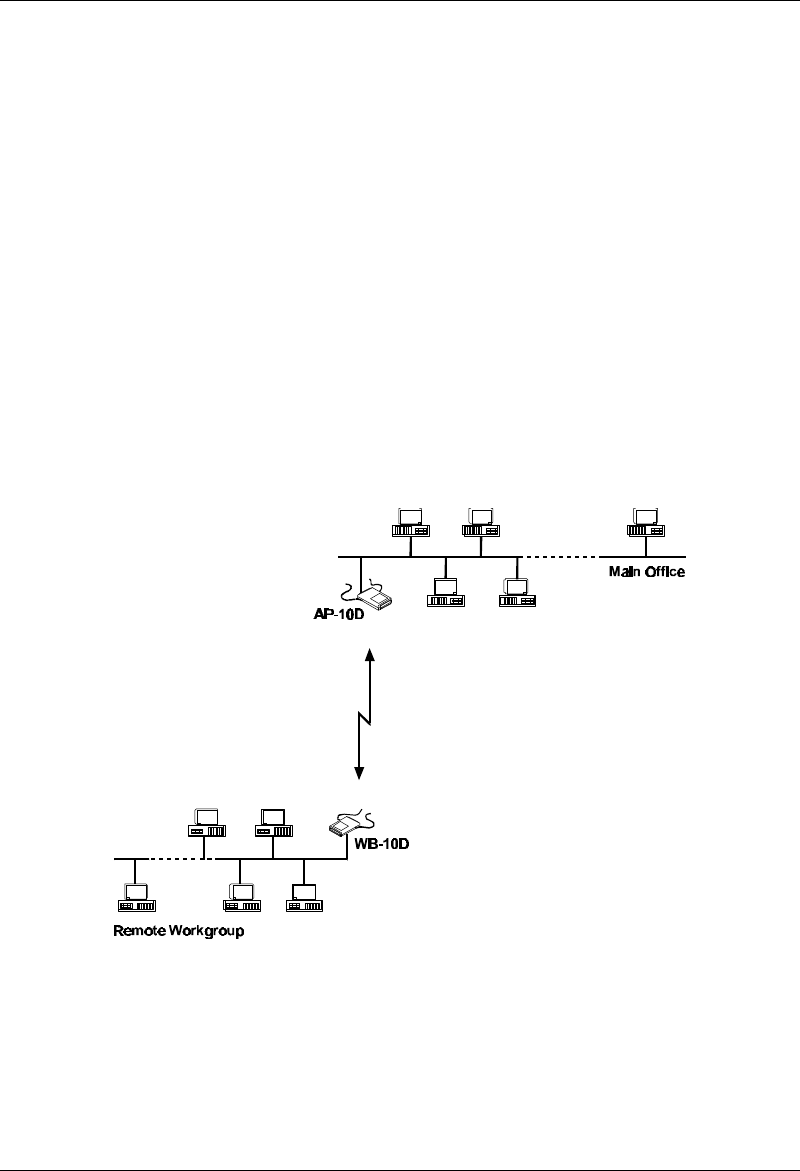
Planning and Installing Wireless LANs
BreezeNET PRO.11 Series 5-3User’s Guide
Omni-7.2 antenna comes with a 20ft. low loss cable and a mast mount
bracket for rooftop installations.
The remote units should use directional antennas aimed in the direction of
the AP’s antenna(s).
5.1.1.3 Mobile Applications
In mobile applications, station orientation changes continuously. In order to
maintain connectivity throughout the entire coverage area, most mobile
applications require omni-directional antennas for both Access Points and
wireless stations. In a motor vehicle, for example, you can install an SA-10
in the cabin, and mount the antennas (in most cases an Omni-6) on the roof.
5.1.1.4 Extending the LAN with WLAN Bridging
The figures below demonstrate how the WB-10 can be used to extend a
regular network with a wireless link.
Figure 5.1: Connecting Remote Offices to Main Office Network
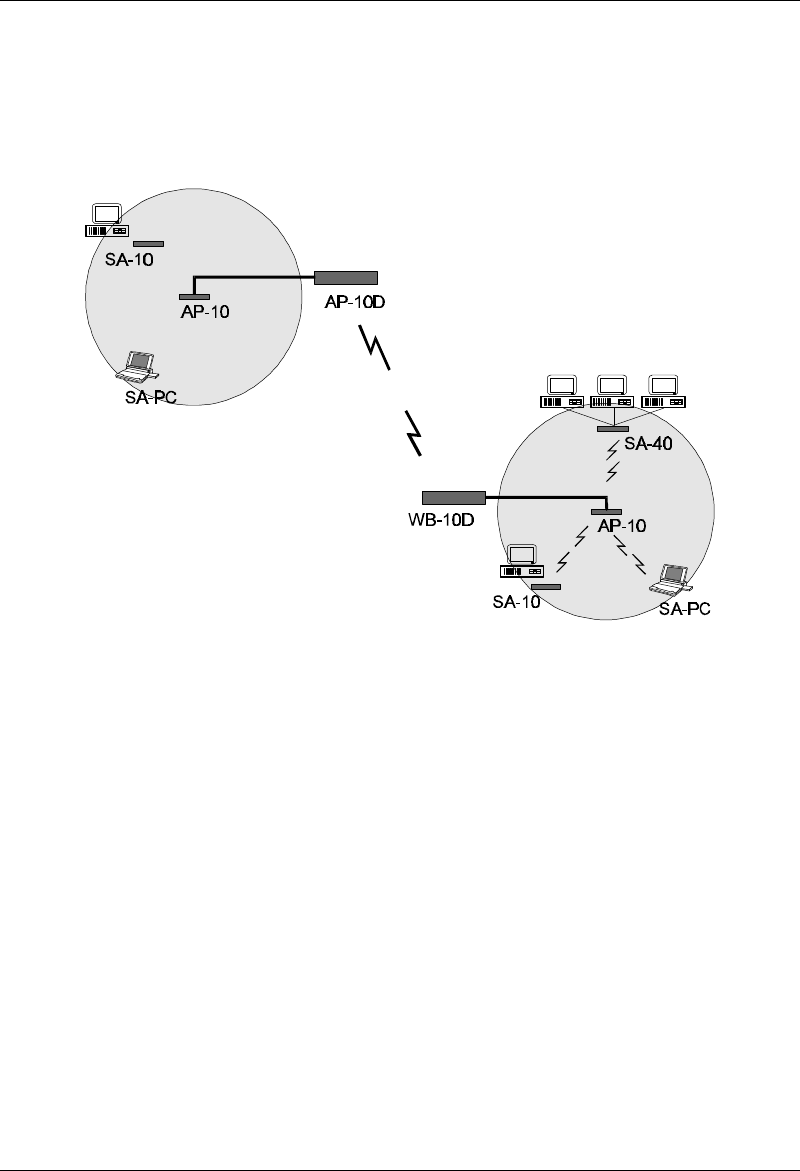
Planning and Installing Wireless LANs
BreezeNET PRO.11 Series 5-4User’s Guide
The WB-10 PRO.11 also enables connectivity between a wireless LAN and
individual workstations or workgroups located outside the LAN. The
WB-10 PRO.11 enables these wireless stations in its coverage area to
communicate with the wireless LAN and gain access to all of the network
resources such as file servers, printers and shared databases.
Figure 5.2: Wireless Bridging Between Two or More Wireless LAN Segments
5.1.1.5 Setting Up a Single BreezeNET Cell
⇒⇒ To set up a single BreezeNET cell:
1. Install the Access Point (refer to section 2, Basic Installation). Be
sure to position the Access Point as high as possible.
Note: It is not necessary at this point to connect the Access Point to an Ethernet
backbone, since Access Points continuously transmit signals (beacon
frames) whether they are connected to an Ethernet backbone or not.
2. Install a Station Adapter or SA-PCR Card (refer to section 2, Basic
Installation).
3. Check the LED indicators of the front panel of the Station Adapter,
or the Site Survey application of the SA-PCR Card to check signal
strength.
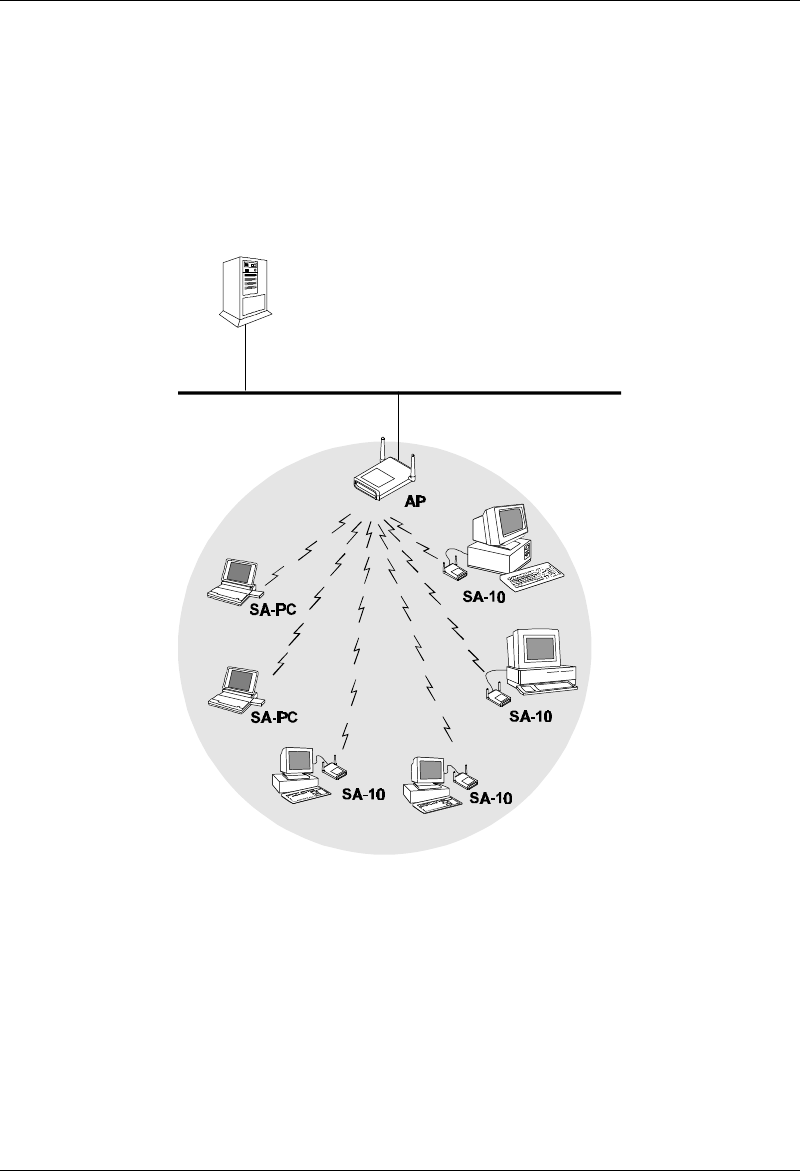
Planning and Installing Wireless LANs
BreezeNET PRO.11 Series 5-5User’s Guide
4. Make any necessary adjustments, for example:
• Adjust the antennas
• Adjust the location of the Station Adapter
• Adjust the location of the Access Point
5. Proceed to setup the other workstations.
Figure 5.3: Single Cell Configuration
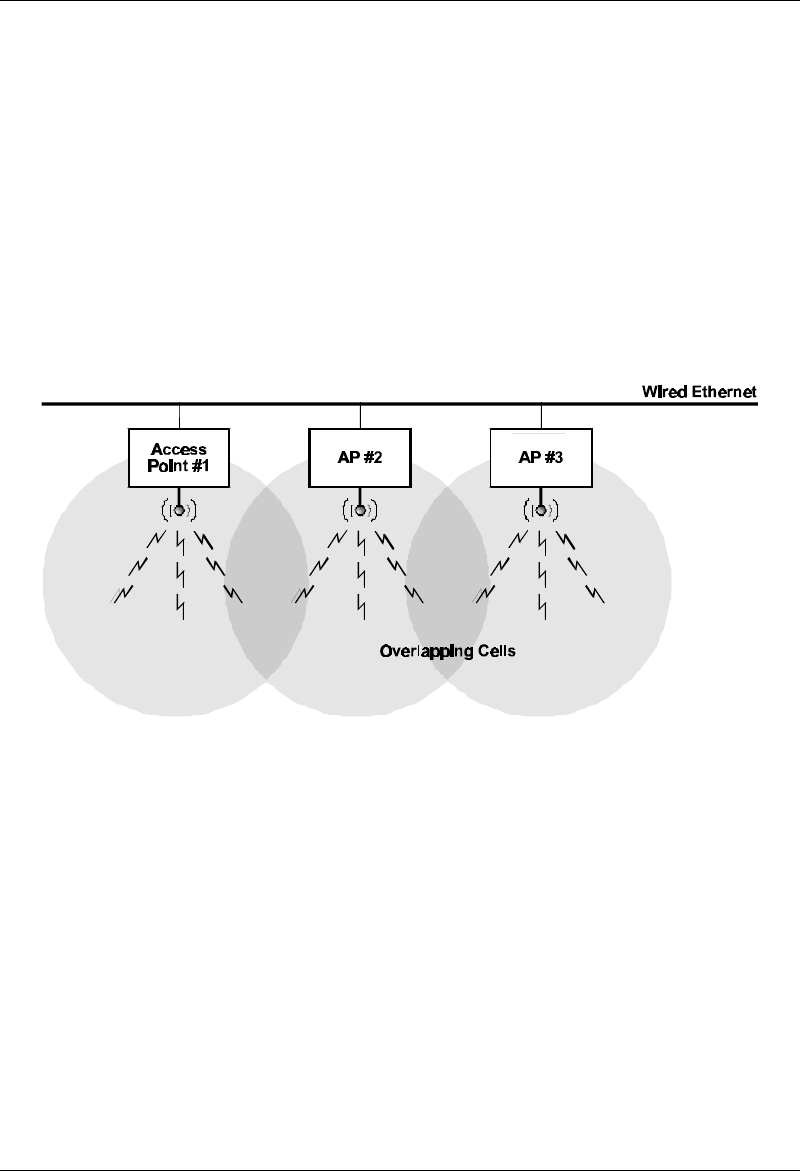
Planning and Installing Wireless LANs
BreezeNET PRO.11 Series 5-6User’s Guide
5.1.2. Overlapping Cell Configuration
When two adjacent Access Points are positioned close enough to each other,
a part of the coverage area of Access Point #1 overlaps that of Access Point
#2. This overlapping area has two very important attributes:
• Any workstation situated in the overlapping area can associate and
communicate with either Access Point #1 or Access Point #2.
• Any workstation can move seamlessly through the overlapping coverage
areas without losing its network connection. This attribute is called
Seamless Roaming.
Figure 5.4: Three Overlapping Cells
⇒⇒ To set up overlapping BreezeNET cells:
1. Install an Access Point (refer to section 2, Basic Installation). Be
sure to position the Access Point as high as possible.
2. Install the second Access Point so that the two are positioned closer
together than the prescribed distance (refer to section 5.2.4).
3. To allow roaming, configure all Access Points and stations adapters
to the same ESSID.
4. To improve collocation and performance, configure all Access
Points to different hopping sequences of the same hopping set.
5. Install a Station Adapter or SA-PCR Card on a workstation.

Planning and Installing Wireless LANs
BreezeNET PRO.11 Series 5-7User’s Guide
6. Position the wireless workstation approximately the same distance
from the two Access Points.
7. Temporarily disconnect the first Access Point from the power
supply. Verify radio signal reception from the first Access Point.
View the LED indicators of the front panel of the Station Adapter,
or the Site Survey application of the SA-PCR Card, to check signal
strength of the first Access Point.
8. Disconnect the second Access Point from the power supply and re-
connect the first Access Point. View the LED indicators of the front
panel of the Station Adapter, or the Site Survey application of the
SA-PCR Card, to check signal strength of the second Access Point.
7. If necessary, adjust the distance between the Access Points so the
coverage areas overlap.
8. Continue setting up overlapping cells until the required area is
covered.
Note: It is not necessary at this point to connect the Access Points to an Ethernet
backbone, since Access Points continuously transmit signals (beacon
frames) whether they are connected to an Ethernet backbone or not.

Planning and Installing Wireless LANs
BreezeNET PRO.11 Series 5-8User’s Guide
5.1.3. Multicell Configuration
Areas congested by many users and a heavy traffic load may require a
multicell structure. In a multicell structure, several Access Points are
installed in the same location. Each Access Point has the same coverage
area, thereby creating a common coverage area that increases aggregate
throughput. Any workstation in the overlapping area can associate and
communicate with any Access Point covering that area.
⇒⇒ To set up a BreezeNET multicell:
1. Calculate the number of Access Points needed as follows: Multiply
the number of active users by the required throughput per user, and
divide the result by 1.5Mbps (net throughput supported by
collocated Access Points). Consider the example of 5 active
stations, each requiring 0.5 Mbps throughput. The calculation is
(5*.5)/1.5=1.6. Two Access Points should be used. This method is
accurate only for the first few Access Points.
The aggregate throughput of the common coverage area is equal to
the number of co-located Access Points multiplied by the
throughput of each individual Access Point, minus a certain amount
of degradation caused by the interference among the different
Access Points.
2. Install several Access Points in the same location a few meters
from each other so they cover the same area. Be sure to position the
Access Points as high as possible.
3. To allow roaming and redundancy, configure all Access Points and
stations adapters to the same ESSID.
4. To improve collocation and performance, configure all Access
Points to different hopping sequences of the same hopping set.
5. Install Station Adapters or SA-PCR Cards on workstations.
6. Make sure that the Load Sharing option is activated. Stations will
automatically associate with an Access Point that is less loaded and
provides better signal quality.
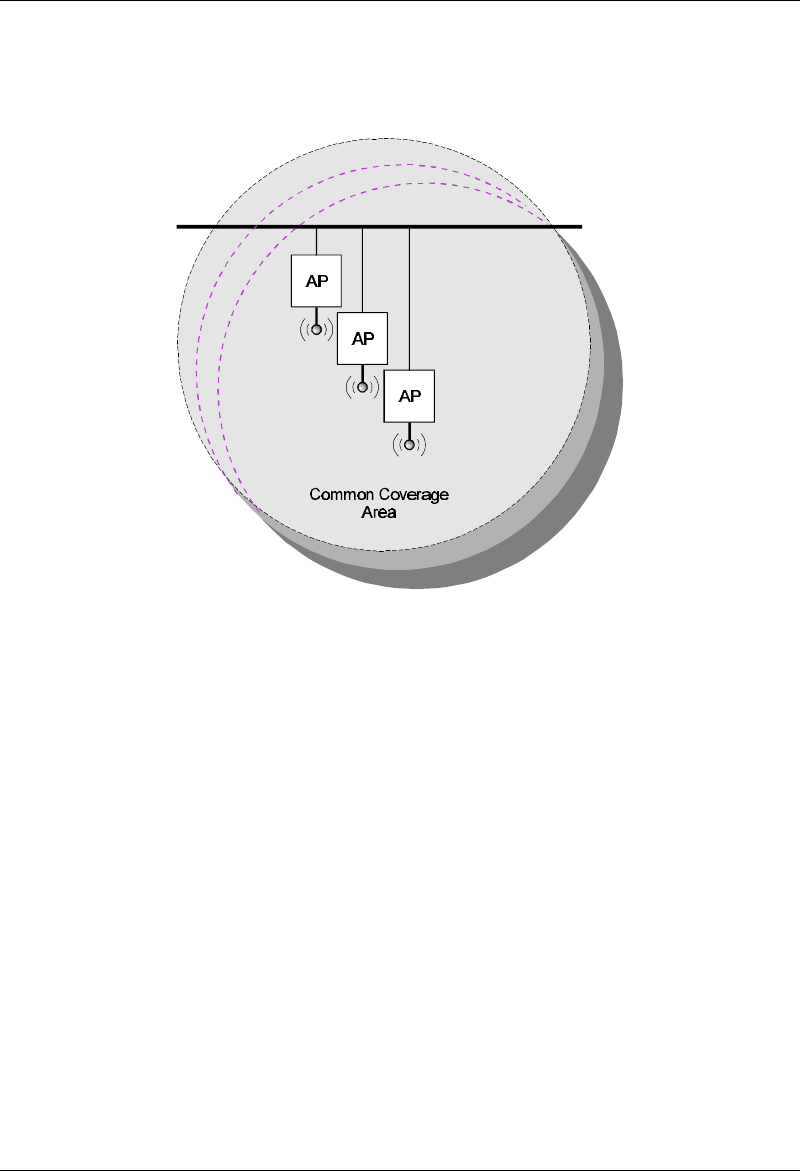
Planning and Installing Wireless LANs
BreezeNET PRO.11 Series 5-9User’s Guide
Note: It is not necessary at this point to connect the Access Points to an Ethernet
backbone, since Access Points continuously transmit signals (beacon
frames) whether they are connected to an Ethernet backbone or not.
Figure 5.5: Multicell Configuration

Planning and Installing Wireless LANs
BreezeNET PRO.11 Series 5-10 User’s Guide
5.1.4. Multi-hop Configuration (Relay)
When you want to connect two sites between which a line-of-sight does not
exist, an AP-WB pair can be positioned at a third location where line-of-
sight exists with each of the original locations. This third location then acts
as a relay point.
In areas where a wired LAN backbone is not available, another AP can be
added to the AP-WB relay to distribute a wireless backbone. In this way, the
range of a wireless system can be extended.
System configuration is as follows:
⇒⇒ To set up a BreezeNET multi-hop cell:
1. Install an AP at the main office (refer to section 2, Basic
Installation).
2. Install a WB at the remote site (refer to section 2, Basic
Installation).
3. Install an AP-WB pair in a high location that has a clear line of
sight to both the main office and the remote site. Many AP-WB
pairs can form a chain.
4. When an AP and WB communicate over the wireless LAN, set
them both to the same ESSID. For example, set the AP of the main
office and the WB of the first AP-WB relay pair to the same
ESSID. Also, set the AP of the last AP-WB relay and the WB of
the remote site to the same ESSID; this ESSID should be different
from the first ESSID.
Another option is to use one ESSID, and to set the Preferred AP
parameter of each WB to its paired AP (refer to section 3.4.3). This
option allows stations to roam between the sites.
5. As usual, make sure that the hopping sequence of the Access Points
are different.
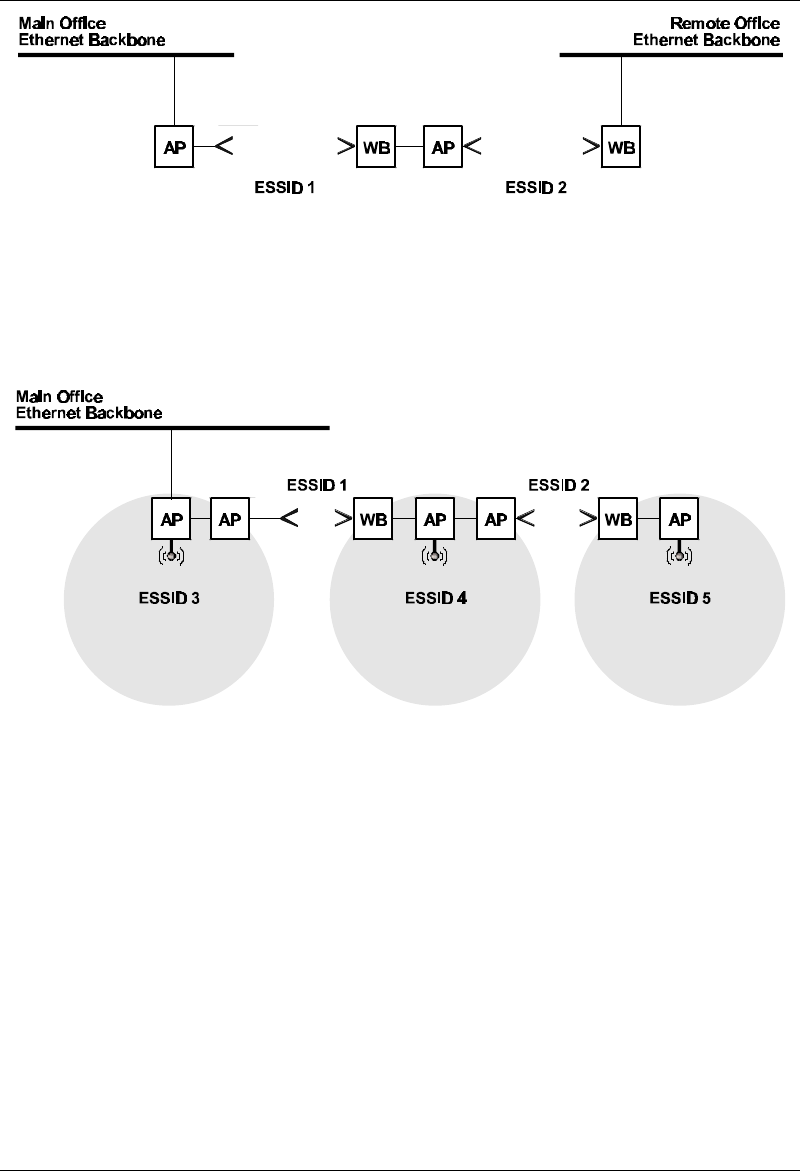
Planning and Installing Wireless LANs
BreezeNET PRO.11 Series 5-11 User’s Guide
Figure 5.6: Multihop Configuration
6. If desired, an additional AP may be added at the main office and
remote site, and between each AP-WB pair to provide wireless
LANs at those points (see illustration).
Figure 5.7: Advanced Multihop Configuration
7. Install Station Adapters or SA-PCR Cards on workstations (refer to
section 2, Basic Installation).
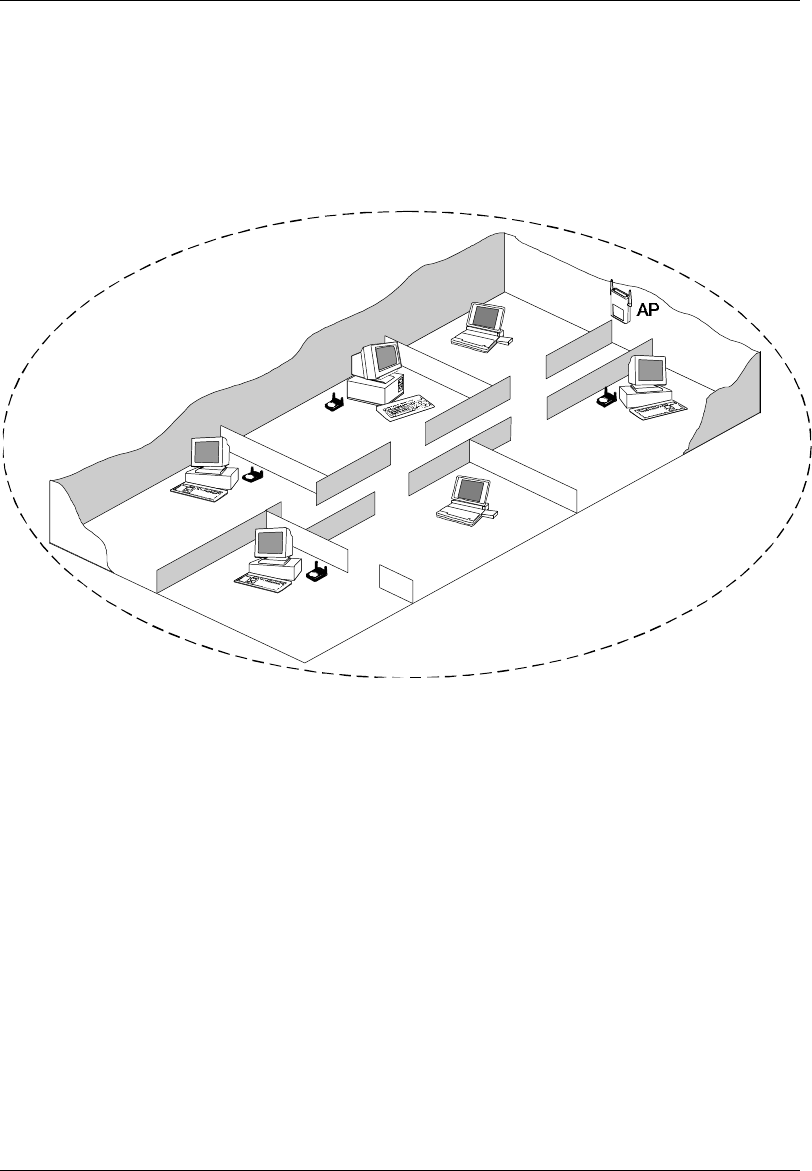
Planning and Installing Wireless LANs
BreezeNET PRO.11 Series 5-12 User’s Guide
5.2. Indoor Installation considerations
This chapter describes various considerations to take into account when
planning an indoor installation including site selection, antenna diversity,
antenna polarization, construction materials, and cell size.
Figure 5.8: BreezeNET LAN in a typical office environment
5.2.1. Site Selection Factors
BreezeNET PRO.11 wireless LAN products are robust, trouble-free units,
designed to operate efficiently under a wide range of conditions. The
following guidelines are provided to help you position the units to ensure
optimum coverage and operation of the wireless LAN.
Metal Furniture
Position the units clear of metal furniture and away from moving objects
such as metal fans or doors.

Planning and Installing Wireless LANs
BreezeNET PRO.11 Series 5-13 User’s Guide
Microwave Ovens
For best performance, position the units clear of radiation sources that emit
in the 2.4 GHz frequency band, such as microwave ovens.
Antennas
Make sure the antennas are extended upward vertically in relation to the
floor. For models with external antennas, connect the external antennas and
RF cable.
Heat Sources
Keep the units well away from sources of heat, such as radiators, air-
conditioners, etc.
5.2.1.1 Site Selection for Access Points
When positioning Access Points, take into account the following additional
considerations.
Height
Install the Access Point at least 1.5m above the floor, clear of any high
office partitions or tall pieces of furniture in the coverage area. The Access
Point can be placed on a high shelf, or can be attached to the ceiling or a
wall using a mounting bracket.
Central Location
Install the Access Point in a central location in the intended coverage area.
Good positions are:
• In the center of a large room.
• In the center of a corridor.
• At the intersection of two corridors.
Many modern buildings have partitions constructed of metal or containing
metal components. We recommend that you install the Access Points on the
corridor ceilings. The radio waves propagated by the BreezeNET PRO.11
LAN are reflected along the metal partitions and enter the offices through
the doors or glass sections.

Planning and Installing Wireless LANs
BreezeNET PRO.11 Series 5-14 User’s Guide
5.2.2. Antennas for Indoor applications
For most indoor applications, the best choice is the standard unit equipped
with its integrated 2dBi antennas. The units are small, easy to install and
cover a large area.
In some installations, it is required to install the unit and antenna separately.
In such instances, use the AP-10D with the omni-6 antenna kit (6dbi omni-
directional antenna with 3 meter RG-58 cable). In the USA (FCC regulated)
and in non-regulated countries, the omni-6 comes with a shorter antenna
cable, extending the coverage area.
The Uni-8.5 is also useful in indoor applications. It is very small and easily
wall-mounted, but its radiation pattern is limited (75°).
BreezeCOM recommends that, for indoor applications, you use two
antennas per unit to utilize the diversity gain of the system.
5.2.2.1 Antenna Diversity
In applications where no multipath propagation is expected, a single antenna
is sufficient to ensure good performance levels. However, in cases where
multipath propagation exists, BreezeCOM recommends that two antennas
be used. This takes advantage of space diversity capabilities. By using two
antennas per unit, the system can select the best antenna on a per-packet
basis (every several milliseconds).
Multipath propagation is to be expected when there are potential reflectors
between the main and remote sites. These reflectors may be buildings or
moving objects such as airplanes and motor vehicles. If this is the case, the
radio signal does not travel in a straight line, but is reflected or deflected off
of the object, creating multiple propagation paths.
When installing a single antenna, modify the transmit diversity option to
either antenna 1 or antenna 2, according to the antenna being used (refer to
section 3.4.3).
5.2.2.2 Antenna Polarization
Antenna polarization must be the same at either end of the link. In most
applications, the preferred orientation is vertical polarization. Above-ground
propagation of the signal is better when it is polarized vertically. To verify
antenna polarization, refer to the assembly instructions supplied with the
antenna set.

Planning and Installing Wireless LANs
BreezeNET PRO.11 Series 5-15 User’s Guide
5.2.3. Construction Materials
A cell’s coverage area is affected by the construction materials of the walls,
partitions, ceilings, floors and the furnishings of the cell. Due to their
intrinsic nature, these materials may cause radio signal loss:
• Metal objects reflect radio signals. They do not let the signals pass
through.
• Wood, glass, plastic and brick reflect part of the radio signals and allow
part of the radio signals to pass through.
• Water and objects with a high moisture content absorb a large part of the
radio signals.
Use the following table as a guidline to predict the effects of different
materials.
Table 5.1: Signal Loss Chart
Obstruction Additional Loss
(dB)
Effective Range Approx. Range
Open Space 0dB 100% 1000ft. (300m)
Window (non-metallic tint) 3dB 70% 700ft. (215m)
Window (metallic tint) 5-8dB 50% 500ft. (150m)
Light Wall (dry wall) 5-8dB 50% 500ft. (150m)
Medium Wall (wood) 10dB 30% 300ft. (100m)
Heavy Wall (solid core 6”) 15-20dB 15% 150ft. (50m)
Very Heavy Wall (solid core 12”) 20-25dB 10% 100ft. (30m)
Floor/Ceiling (solid core) 15-20dB 15% 150ft. (50m)
Floor/Ceiling (heavy solid core) 20-25dB 10% 100ft. (30m)
Note: Take stairwells and elevator shafts into consideration when positioning
Access Points. There is no way to quantify the loss associated with these
obstructions, however they do have an effect on the signal.
5.2.4. Cell Size
Cell size is determined by the maximum possible distance between the
Access Point and the Station Adapter. This distance varies according to the
building floor plan and the nature of that environment. There are several
general categories:

Planning and Installing Wireless LANs
BreezeNET PRO.11 Series 5-16 User’s Guide
Open Indoor Areas
Open office areas with no partitioning and no obstacles between the Access
Point and the BreezeNET workstation.
The suggested maximum distance between Access Point and workstation:
Standard AP-10 PRO.11: .............................200m (600 ft.)
Semi-Open Indoor Areas
Open-plan offices partitioned into individual workspaces, factory floor
areas, warehouses, etc.
The suggested maximum distance between Access Point and workstation:
Standard AP-10 PRO.11 ..............................100m (300 ft.)
Closed Indoor Areas
A floor divided into individual offices by concrete, masonry or sheet-rock
walls. A house is also a closed indoor area.
The suggested maximum distance between Access Point and workstation:
Standard AP-10 PRO.11 ..............................50m (150 ft.)
5.3. Outdoor Installation Considerations
This chapter describes various considerations to take into account when
planning an outdoor installation including site selection, antenna alignment,
antenna diversity, antenna polarization, antenna seal, and cell size.
5.3.1. Site Selection Factors
When selecting a location for external antennas, remember to take into
consideration the following guidelines:
• Minimum distance between sites
• Maximum height above the ground
• Maximum line of sight clearance
• Maximum separation between antennas (diversity option)

Planning and Installing Wireless LANs
BreezeNET PRO.11 Series 5-17 User’s Guide
Path of Clearest Propagation
A propagation path is the path that signals traverse between the antennas of
any two bridges. The “line” between two antenna sites is an imaginary
straight line which may be drawn between the two antennas. Any obstacles
in the path of the “line” degrade the propagation path. The best propagation
path is, therefore, a clear line of sight with good clearance between the
“line” and any physical obstacle.
Physical Obstacles
Any physical object in the path between two bridges can cause signal
attenuation. Common obstructions are buildings and trees. If a bridge’s
antenna is installed indoors, the walls and/or windows between the two sites
are physical obstructions. If the antenna is positioned outdoors, any
buildings or other physical structure such as trees, mountains or other
natural geographic features higher than the antenna and situated in the path
between the two sites can constitute obstructions.
Install indoor antennas as close as possible to a window (or wall if a
window is not accessible) facing the required direction. Avoid metal
obstacles such as metal window frames or metal film anti-glare windows in
the transmission path. Install outdoor antennas high enough to avoid any
obstacles which may block the signal.
Minimal Path Loss
Path loss is determined mainly by several factors:
• Distance between sites
Path loss is lower and system performance better when distances
between sites are shorter.
• Clearance
Path loss is minimized when there exists a clear line of sight. The
number, location, size, and makeup of obstacles determine their
contribution to path loss.
• Antenna height
Path loss is lower when antennas are positioned higher. Antenna height
is the distance from the imaginary line connecting the antennas at the
two sites to “ground” level. “Ground” level in an open area is the actual
ground. In dense urban areas, “ground” level is the average height of the
buildings between the antenna sites.

Planning and Installing Wireless LANs
BreezeNET PRO.11 Series 5-18 User’s Guide
5.3.2. Rooftop Installation
Warning: Rooftop antenna installations are extremely dangerous! Incorrect
installation may result in death, serious injury and/or damage. Such
installations should be performed by professional antenna installers
only!
Rooftop installations offer several advantages:
• Increased antenna range.
• Less obstacles in path.
• Improved performance due to greater height.
• Reduced multipath problems.
5.3.3. Antennas for Outdoor Applications
The BreezeNET PRO.11 Series can be used in point-to-point or point-to-
multipoint configurations.
5.3.3.1 Point-to-Point
A point-to-point link is based on the use of one Access Point with external
antennas (AP-10D or AP-10DE) and one adapter (SA-10/40D, WB-10D or
WB-10DE). The AP and the WB must be equipped with one or two
directional antennas. The necessary antenna gain depends on the required
range and performance.
5.3.3.2 Point-to-Multipoint
Setting up a point-to-multipoint link requires the use of an AP-10D
equipped with omni-directional antennas and a remote WB-10D (or SA-
10/40D) equipped with high-gain directional antennas.
5.3.3.3 Antenna Alignment
Low gain antennas do not require alignment due to their very wide radiation
pattern. High gain antennas have a narrow beamwidth necessitating an
alignment procedure in order to optimize the link.

Planning and Installing Wireless LANs
BreezeNET PRO.11 Series 5-19 User’s Guide
Check antenna alignment by using the LED indicators on the front panel of
whichever adapter is used in the link (WB-10D or SA-10/40D). These LED
indicators provide indication of reception quality.
⇒⇒ To perform antenna alignment:
1. Assemble antennas according to the assembly instructions included
with the antenna set.
2. Mount the antennas as high as possible.
3. Connect the coaxial cable to the AP at the main site.
4. Connect the coaxial cable to the WB (or SA) at the remote site.
5. Power on the AP and the WB (or SA).
6. Synchronize the units by aligning the antennas manually until the
WLNK indicator LED on the front panel of the wireless Bridge
and/or Station Adapter illuminates.
7. Align antennas at the main and remote sites until maximum signal
quality is obtained. (Check QLT LEDs on the front panel of the
Station Adapter and the wireless Bridge.)
If the received signal quality is lower than expected for this antenna/range
combination, change antenna height and verify RF cables connections.
5.3.3.4 Antenna Diversity
In applications where no multipath propagation is expected, a single antenna
is sufficient to ensure good performance levels. However, in cases where
multipath propagation exists, BreezeCOM recommends that two antennas
be used. This takes advantage of space diversity capabilities. By using two
antennas per unit, the system can select the best antenna on a per-packet
basis (every several milliseconds).
Multipath propagation is to be expected when there are potential reflectors
between the main and remote sites. These reflectors may be buildings or
moving objects such as airplanes and motor vehicles. If this is the case, the
radio signal does not travel in a straight line, but is reflected or deflected off
of the object, creating multiple propagation paths.

Planning and Installing Wireless LANs
BreezeNET PRO.11 Series 5-20 User’s Guide
When installing a single antenna, modify the transmit diversity option to
either antenna 1 or antenna 2, according to the antenna being used (refer to
section 3.4.3).
5.3.3.5 Antenna Polarization
Antenna polarization must be the same at either end of the link. In most
applications, the preferred orientation is vertical polarization. Above-ground
propagation of the signal is better when it is polarized vertically. To verify
antenna polarization, refer to the assembly instructions supplied with the
antenna set.
5.3.4. Antenna Seal
When using outdoor antennas, you must seal the antenna connectors against
rain. Otherwise the antennas are not suitable for use in outdoor installations.
5.3.5. Cell Size
Cell size is determined by the maximum possible distance between the
Access Point and the Station Adapter, usually related to point-to-multipoint
installations using external antennas. For open outdoor areas with an
unobstructed line of sight between the Access Point and the BreezeNET
PRO.11 workstation, the suggested maximum distance between Access
Point and workstation is:
Standard AP-10 PRO.11 ..............................700m (2000 ft.)

Planning and Installing Wireless LANs
BreezeNET PRO.11 Series 5-21 User’s Guide
5.3.6. Link Distance
Link distance is the maximum distance between the AP and the station
adapter, usually related to point-to-point installations using external
antennas. For open outdoor areas with an unobstructed line of sight between
the Access Point and the wireless bridge, the suggested maximum distance
is:
AP-10D PRO.11 with external antennas.......up to 10Km (7 miles) in the USA
up to 2.5Km in Europe
AP-10DE PRO.11 with external antennas.....up to 5Km in Europe
Note: The maximum distance of 10Km/7 miles is achieved using 24 dBi antennas.
The maximum distance of 2.5Km is achieved using 18 dBi antennas.
For range tables, refer to section 5.3.7, Using Outdoor Range Tables.
5.3.7. Using Outdoor Range Tables
Outdoor installations must have a clear line-of-sight. Solid obstacles such as
buildings or hills prevent the establishment of a link. Partial obstacles such
as trees or traffic can reduce range. Extending coaxial cables can cause an
increase in assembly signal loss and a reduction in range.
The ranges in the following tables are attained under good propagating
conditions when using the standard cables supplied in the antenna set.
Actual ranges may vary due to specific multipath and interference
conditions.
For specific range guidelines and information about extending cables,
consult your local dealer or BreezeCOM central offices.
Ranges are subject to change without notice.

Planning and Installing Wireless LANs
BreezeNET PRO.11 Series 5-22 User’s Guide
5.3.8. FCC Outdoor Range Tables (USA)
The following tables are compliant with FCC regulations.
Table 5.2: BreezeNET USA/FCC Range Table - 1 Mbps
Ant.
type
Omni2 Omni-6 Omni-7 Uni-8.5 Uni-11 Uni-13 Uni-16 Uni-18 Uni-24
Asmb
gain
2 dBi 5 dBi 6 dBi 6.5 dBi 9 dBi 11 dBi 14 dBi 15 dBi 19 dBi
Omni-2 2 dBi 2500 ft 3800 ft 3900 ft 4000 ft 1.0 mi 1.2 mi 1.4 mi 1.5 mi 1.9 mi
Omni-6 5 dBi 3800 ft 4300 ft 4600 ft 4800 ft 1.2 mi 1.5 mi 1.7 mi 1.8 mi 2.2 mi
Omni-7 6 dBi 3900 ft 4600 ft 4800 ft 1.0 mi 1.3 mi 1.6 mi 1.8 mi 1.9 mi 2.3 mi
Uni-8.5 6.5 dBi 4000 ft 4800 ft 1.0 mi 1.1 mi 1.4 mi 1.7 mi 1.9 mi 2.0 mi 2.4 mi
Uni-11 9 dBi 1.0 mi 1.2 mi 1.3 mi 1.4 mi 1.7 mi 2.0 mi 2.3 mi 2.5 mi 2.9 mi
Uni-13 11 dBi 1.2 mi 1.5 mi 1.6 mi 1.7 mi 2.0 mi 2.2 mi 2.6 mi 2.8 mi 3.2 mi
Uni-16 14 dBi 1.4 mi 1.7 mi 1.8 mi 1.9 mi 2.3 mi 2.6 mi 3.1 mi 3.4 mi 3.7 mi
Uni-18 15 dBi 1.5 mi 1.8 mi 1.9 mi 2.0 mi 2.5 mi 2.8 mi 3.4 mi 3.5 mi 4.0 mi
Uni-24 19 dBi 1.9 mi 2.2 mi 2.3 mi 2.4 mi 2.9 mi 3.2 mi 3.7 mi 4.0 mi 6.0 mi
Table 5.3: BreezeNET USA/FCC Range Table - 2 Mbps
Ant.
type
Omni-2 Omni-6 Omni-7 Uni-8.5 Uni-11 Uni-13 Uni-16 Uni-18 Uni-24
Asmb
gain
2 dBi 5 dBi 6 dBi 6.5 dBi 9 dBi 11 dBi 14 dBi 15 dBi 19 dBi
Omni-2 2 dBi 1500 ft 2000 ft 2300 ft 2500 ft 0.6 mi 0.7 mi 0.8 mi 0.9 mi 1.1 mi
Omni-6 5 dBi 2000 ft 2400 ft 2600 ft 2800 ft 0.7 mi 0.9 mi 1.0 mi 1.1 mi 1.3 mi
Omni-7 6 dBi 2300 ft 2600 ft 2900 ft 3000 ft 0.8 mi 1.0 mi 1.2 mi 1.3 mi 1.4 mi
Uni-8.5 6.5 dBi 2500 ft 2800 ft 3000 ft 0.6 mi 0.8 mi 1.0 mi 1.3 mi 1.3 mi 1.5 mi
Uni-11 9 dBi 0.6 mi 0.7 mi 0.8 mi 0.8 mi 0.9 mi 1.1 mi 1.4 mi 1.5 mi 1.7 mi
Uni-13 11 dBi 0.7 mi 0.9 mi 1.0 mi 1.0 mi 1.1 mi 1.2 mi 1.5 mi 1.7 mi 2.0 mi
Uni-16 14 dBi 0.8 mi 1.0 mi 1.2 mi 1.3 mi 1.4 mi 1.5 mi 1.8 mi 2.0 mi 2.6 mi
Uni-18 15 dBi 0.9 mi 1.1 mi 1.3 mi 1.3 mi 1.5 mi 1.7 mi 2.0 mi 2.2 mi 2.8 mi
Uni-24 19 dBi 1.1 mi 1.3 mi 1.4 mi 1.5 mi 1.7 mi 2.0 mi 2.6 mi 2.8 mi 3.5 mi

Planning and Installing Wireless LANs
BreezeNET PRO.11 Series 5-23 User’s Guide
Table 5.4: BreezeNET USA/FCC Range Table - 3 Mbps
Ant.
type
Omni-2 Omni-6 Omni-7 Uni-8.5 Uni-11 Uni-13 Uni-16 Uni-18 Uni-24
Asmb
gain
2 dBi 5 dBi 6 dBi 6.5 dBi 9 dBi 11 dBi 14 dBi 15 dBi 19 dBi
Omni-2 2 dBi 500 ft 750 ft 800 ft 850 ft 1200 ft 1600 ft 0.4 mi 0.5 mi 0.6 mi
Omni-6 5 dBi 750 ft 900 ft 1000 ft 1100 ft 1600 ft 2000 ft 0.5 mi 0.6 mi 0.7 mi
Omni-7 6 dBi 800 ft 1000 ft 1000 ft 1200 ft 1700 ft 2100 ft 0.6 mi 0.7 mi 0.8 mi
Uni-8.5 6.5 dBi 850 ft 1100 ft 1200 ft 1400 ft 2200 ft 0.5 mi 0.7 mi 0.7 mi 0.9 mi
Uni-11 9 dBi 1200 ft 1600 ft 1700 ft 2200 ft 0.5 mi 0.6 mi 0.8 mi 0.9 mi 1.0 mi
Uni-13 11 dBi 1600 ft 2000 ft 2100 ft 0.5 mi 0.6 mi 0.7 mi 0.9 mi 1.0 mi 1.2 mi
Uni-16 14 dBi 0.4 mi 0.5 mi 0.6 mi 0.7 mi 0.8 mi 0.9 mi 1 mi 1.1 mi 1.4 mi
Uni-18 15 dBi 0.5 mi 0.6 mi 0.7 mi 0.7 mi 0.9 mi 1.0 mi 1.1 mi 1.2 mi 1.5 mi
Uni-24 19 dBi 0.6 mi 0.7 mi 0.8 mi 0.9 mi 1.0 mi 1.2 mi 1.4 mi 1.5 mi 2 mi
Note: The use of an LNA can improve the range by 30%-40%. To achieve this it is
necessary to install an LNA on both sides of the link (in each site). An LNA
will NOT enlarge the link if it is installed only on one side of the link. When
using an LNA you must use two antennas - one for TX and one for RX.
5.3.9. ETSI Outdoor Range Tables (Europe and Rest-of-
World) – D Models
In order to comply with ETSI regulations, 20dBm (100mW) EIRP units
using antenna kits indicated as low must be configured to the low power
setting (4 dBm).
Using an 18dbi antenna and lowering the output power of the unit complies
with ETSI regulations and improves reception. Installing this antenna at
both ends of the link increases the total range. Installing this antenna at one
end of the link does not increase the range, but it does increase the
throughput of traffic received at the end with the 18 dbi antenna.
The following tables are compliant with ETSI regulations.
Table 5.5: BreezeNET Europe and ROW Range Table – D Models
Data Rate = 1Mbps, Sen=-81dBm
Antenna Kit Omni-2 Omni-6 Uni-8.5 Uni-18/20 (Low) Uni-18/15 (Low) Uni-18/10 (Low)
Omni-2 710m 790m 750m 670m 730m 790m
Omni-6 790m 890m 840m 750m 820m 890m
Uni-8.5 750m 840m 790m 710m 770m 840m
Uni-18/20 670m 750m 710m 1,910m 2,020m 2,130m
Uni-18/15 730m 820m 770m 2,020m 2,130m 2,250m
Uni-18/10 790m 890m 840m 2,130m 2,250m 2,370m

Planning and Installing Wireless LANs
BreezeNET PRO.11 Series 5-24 User’s Guide
Table 5.6: BreezeNET Europe and ROW Range Table – D Models
Data Rate = 2Mbps, Sen=-75dBm
Antenna Kit Omni-2 Omni-6 Uni-8.5 Uni-18/20 (Low) Uni-18/15 (Low) Uni-18/10 (Low)
Omni-2 350m 400m 380m 330m 370m 400m
Omni-6 400m 450m 420m 380m 410m 450m
Uni-8.5 380m 420m 400m 350m 390m 420m
Uni-18/20 330m 380m 350m 1,240m 1,310m 1,380m
Uni-18/15 370m 410m 390m 1,310m 1,380m 1,460m
Uni-18/10 400m 450m 420m 1,380m 1,460m 1,540m
Table 5.7: BreezeNET Europe and ROW Range Table – D Models
Data Rate = 3Mbps, Sen=-67dBm
Antenna Kit Omni-2 Omni-6 Uni-8.5 Uni-18/20 (Low) Uni-18/15 (Low) Uni-18/10 (Low)
Omni-2 140m 160m 150m 130m 150m 160m
Omni-6 160m 180m 170m 150m 160m 180m
Uni-8.5 150m 170m 160m 140m 150m 170m
Uni-18/20 130m 150m 140m 560m 610m 670m
Uni-18/15 150m 160m 150m 610m 670m 730m
Uni-18/10 160m 180m 170m 670m 730m 790m
Note: All antennas above 8.5 (i.e. 12, 18, and 24), require a filter to be ETSI-
compliant.
5.3.10. ETSI Outdoor Range Tables (Europe and Rest-of-
World) – DE Models
The following tables are compliant with ETSI regulations.
Table 5.8: BreezeNET Europe and ROW Range Table – DE Models
Data Rate = 1Mbps, Sen=-85dBm
Antenna Kit Uni-24/20 Uni-24/15 Uni-24/10
Uni-24/20 3,920m 4,140m 4,370m
Uni-24/15 4,140m 4,370m 4,610m
Uni-24/10 4,370m 4,610m 4,870m

Planning and Installing Wireless LANs
BreezeNET PRO.11 Series 5-25 User’s Guide
Table 5.9: BreezeNET Europe and ROW Range Table – DE Models
Data Rate = 2Mbps, Sen=-79dBm
Antenna Kit Uni-24/20 Uni-24/15 Uni-24/10
Uni-24/20 2,550m 2,690m 2,840m
Uni-24/15 2,690m 2,840m 3,000m
Uni-24/10 2,840m 3,000m 3,160m
Table 5.10: BreezeNET Europe and ROW Range Table – DE Models
Data Rate = 3Mbps, Sen=-71dBm
Antenna Kit Uni-24/20 Uni-24/15 Uni-24/10
Uni-24/20 1,430m 1,510m 1,600m
Uni-24/15 1,510m 1,600m 1,680m
Uni-24/10 1,600m 1,680m 1,780m
Note: All antennas above 8.5 (i.e. 12, 18, and 24), require a filter to be ETSI-
compliant.
Note: The use of an LNA can improve the range by 30%-40%. To achieve this it is
necessary to install an LNA on both sides of the link (in each site). An LNA
will NOT enlarge the link if it is installed only on one side of the link. When
using an LNA you must use two antennas - one for TX and one for RX.

Planning and Installing Wireless LANs
BreezeNET PRO.11 Series 5-26 User’s Guide
5.3.11. Non-Regulated Outdoor Range Tables – D Models
Table 5.11: BreezeNET Non-Regulation Range Table – D Models
Data Rate = 1Mbps, Sen=-81dBm
Antenna Kits Omni-2 Omni-6 Uni-8.5 Uni-18/20 Uni-18/15 Uni-18/10 Uni-24/20 Uni-24/15 Uni-24/10
Omni-2 710m 790m 750m 1,980m 2,090m 2,210m 3,050m 3,220m 3,400m
Omni-6 790m 890m 840m 2,130m 2,250m 2,370m 3,280m 3,460m 3,650m
Uni-8.5 750m 840m 790m 2,050m 2,170m 2,290m 3,160m 3,340m 3,520m
Uni-18/20 1,980m 2,130m 2,050m 4,870m 5,140m 5,420m 7,500m 7,910m 8,350m
Uni-18/15 2,090m 2,250m 2,170m 5,140m 5,420m 5,730m 7,910m 8,350m 8,820m
Uni-18/10 2,210m 2,370m 2,290m 5,420m 5,730m 6,040m 8,350m 8,820m 9,310m
Uni-24/20 3,050m 3,280m 3,160m 7,500m 7,910m 8,350m 11,550m 12,190m 12,860m
Uni-24/15 3,220m 3,460m 3,340m 7,910m 8,350m 8,820m 12,190m 12,860m 13,580m
Uni-24/10 3,400m 3,650m 3,520m 8,350m 8,820m 9,310m 12,860m 13,580m 14,330m
Table 5.12: BreezeNET Non-Regulation Range Table – D Models
Data Rate = 2Mbps, Sen=-75dBm
Antenna Kits Omni-2 Omni-6 Uni-8.5 Uni-18/20 Uni-18/15 Uni-18/10 Uni-24/20 Uni-24/15 Uni-24/10
Omni-2 350m 400m 380m 1,290m 1,360m 1,430m 1,980m 2,090m 2,210m
Omni-6 400m 450m 420m 1,380m 1,460m 1,540m 2,130m 2,250m 2,370m
Uni-8.5 380m 420m 400m 1,330m 1,410m 1,490m 2,050m 2,170m 2,290m
Uni-18/20 1,290m 1,380m 1,330m 3,160m 3,340m 3,520m 4,870m 5,140m 5,420m
Uni-18/15 1,360m 1,460m 1,410m 3,340m 3,520m 3,720m 5,140m 5,420m 5,730m
Uni-18/10 1,430m 1,540m 1,490m 3,520m 3,720m 3,920m 5,420m 5,730m 6,040m
Uni-24/20 1,980m 2,130m 2,050m 4,870m 5,140m 5,420m 7,500m 7,910m 8,350m
Uni-24/15 2,090m 2,250m 2,170m 5,140m 5,420m 5,730m 7,910m 8,350m 8,820m
Uni-24/10 2,210m 2,370m 2,290m 5,420m 5,730m 6,040m 8,350m 8,820m 9,310m
Table 5.13: BreezeNET Non-Regulation Range Table – D Models
Data Rate = 3Mbps, Sen=-67dBm
Antenna Kits Omni-2 Omni-6 Uni-8.5 Uni-18/20 Uni-18/15 Uni-18/10 Uni-24/20 Uni-24/15 Uni-24/10
Omni-2 140m 160m 150m 600m 650m 710m 1,110m 1,180m 1,240m
Omni-6 160m 180m 170m 670m 730m 790m 1,200m 1,260m 1,330m
Uni-8.5 150m 170m 160m 630m 690m 750m 1,150m 1,220m 1,290m
Uni-18/20 600m 670m 630m 1,780m 1,880m 1,980m 2,740m 2,890m 3,050m
Uni-18/15 650m 730m 690m 1,880m 1,980m 2,090m 2,890m 3,050m 3,220m
Uni-18/10 710m 790m 750m 1,980m 2,090m 2,210m 3,050m 3,220m 3,400m
Uni-24/20 1,110m 1,200m 1,150m 2,740m 2,890m 3,050m 4,220m 4,450m 4,700m
Uni-24/15 1,180m 1,260m 1,220m 2,890m 3,050m 3,220m 4,450m 4,700m 4,960m
Uni-24/10 1,240m 1,330m 1,290m 3,050m 3,220m 3,400m 4,700m 4,960m 5,230m

Planning and Installing Wireless LANs
BreezeNET PRO.11 Series 5-27 User’s Guide
5.3.12. Extending the range using the TPA-24 and LNA-10
The following tables show examples of how outdoor ranges of D-model
units can be extended using the TPA-24 and LNA-10 devices.
In the range tables below, the note LNA means that the LNA 10 Low Noise
Receive Amplifier is used (see section 6.2). The note TPA means that the
TPA 24 Transmit Power Amplifier is used (see section 6.1). When the LNA
or TPA are used, one of the unit’s antennas should be permanently set to
transmit and the other to receive. In this case, Antenna Diversity is not
applicable. The use of an LNA or a Booster (TPA 24) will only enlarge the
range if they are installed on both sides of the link.
The identification of “TX kit” and “RX kit” is for reference purposes only.
They do not have any other meaning than for arranging the table to show the
effects of the LNA and Booster (TPA 24).
For ranges over 30 km, it is recommended to consult BreezeCOM technical
support or your local dealer.
Important: In the following tables, “Omni-6/10” refers to an Omni 6dbi
antenna with a 10 Meter Heliax cable.
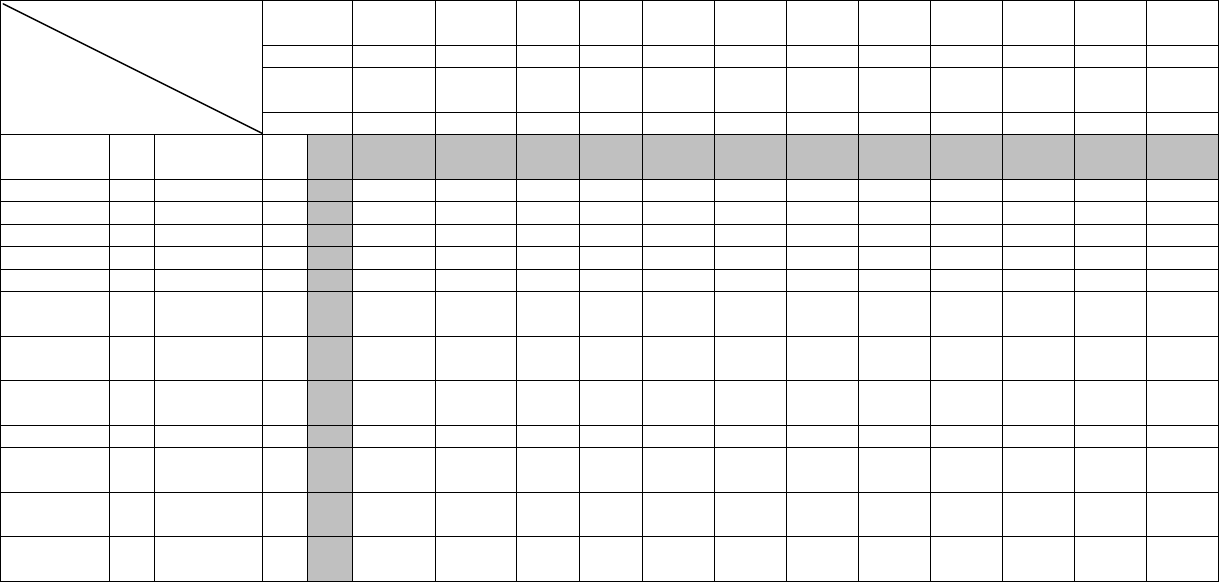
Table 5.14: TPA-24 and LNA-10 Extension Range Table. Data Rate = 1Mbps, Sen=-81dBm
TX kit Omni-6/10 Omni-6/10 Omni-6
(TPA)
Omni-6
(TPA)
Uni-18/10 Uni-18/10 Uni-18/10
(TPA)
Uni-18/10
(TPA)
Uni-24/10 Uni-24/10 Uni-24/10
(TPA)
Uni-24/10
(TPA)
TX EIRP 21 21 30 30 33 33 42 42 39 39 48 48
RX kit Omni-6/10 Omni-6
(LNA 10)
Omni-
6/10
Omni-6
(LNA)
Uni-18/10 Uni-18/10
(LNA)
Uni-18/10 Uni-18/10
(LNA)
Uni-24/10 Uni-24/10
(LNA)
Uni-24/10 Uni-24/10
(LNA)
Transmit and Receive
Antenna Kits
for Side A
Transmit and
Receive Antenna Kits
for Side B RX Gain 48.35 48.35 16 20.35 16 20.35 22 26.35 22 26.35
TX kit EIRP RX kit RX
Gain
Omni-6/10 21 Omni-6/10 41,070m 1,070m 1,070m 1,470m 2,550m 2,550m 2,550m 3,480m 3,920m 3,920m 3,920m 5,370m
Omni-6/10 21 Omni-6 (LNA) 8.35 1,070m 1,470m 1,070m 1,470m 2,550m 3,480m 2,550m 3,480m 3,920m 5,370m 3,920m 5,370m
Omni-6 (TPA) 30 Omni-6/10 41,070m 1,070m 2,050m 2,050m 2,550m 2,550m 4,870m 4,870m 3,920m 3,920m 7,500m 7,500m
Omni-6 (TPA) 30 Omni-6 (LNA) 8.35 1,470m 1,470m 2,050m 2,810m 3,480m 3,480m 4,870m 6,660m 5,370m 5,370m 7,500m 10,260m
Uni-18/10 33 Uni-18/10 16 2,550m 2,550m 2,550m 3,480m 6,040m 6,040m 6,040m 8,260m 9,310m 9,310m 9,310m 12,730m
Uni-18/10 33 Uni-18/10
(LNA)
20.35 2,550m 3,480m 2,550m 3,480m 6,040m 8,260m 6,040m 8,260m 9,310m 12,730m 9,310m 12,730m
Uni-18/10
(TPA)
42 Uni-18/10 16 2,550m 2,550m 4,870m 4,870m 6,040m 6,040m 11,550m 11,550m 9,310m 9,310m 17,780m 17,780m
Uni-18/10
(TPA)
42 Uni-18/10
(LNA)
20.35 3,480m 3,480m 4,870m 6,660m 8,260m 8,260m 11,550m 15,790m 12,730m 12,730m 17,780m 24,320m
Uni-24/10 39 Uni-24/10 22 3,920m 3,920m 3,920m 5,370m 9,310m 9,310m 9,310m 12,730m 14,330m 14,330m 14,330m 19,600m
Uni-24/10 39 Uni-24/10
(LNA)
26.35 3,920m 5,370m 3,920m 5,370m 9,310m 12,730m 9,310m 12,730m 14,330m 19,600m 14,330m 19,600m
Uni-24/10
(TPA)
48 Uni-24/10 22 3,920m 3,920m 7,500m 7,500m 9,310m 9,310m 17,780m 17,780m 14,330m 14,330m 27,380m 27,380m
Uni-24/10
(TPA)
48 Uni-24/10
(LNA)
26.35 5,370m 5,370m 7,500m 10,260 12,730m 12,730m 17,780m 24,320m 19,600m 19,600m 27,380m 37,450m
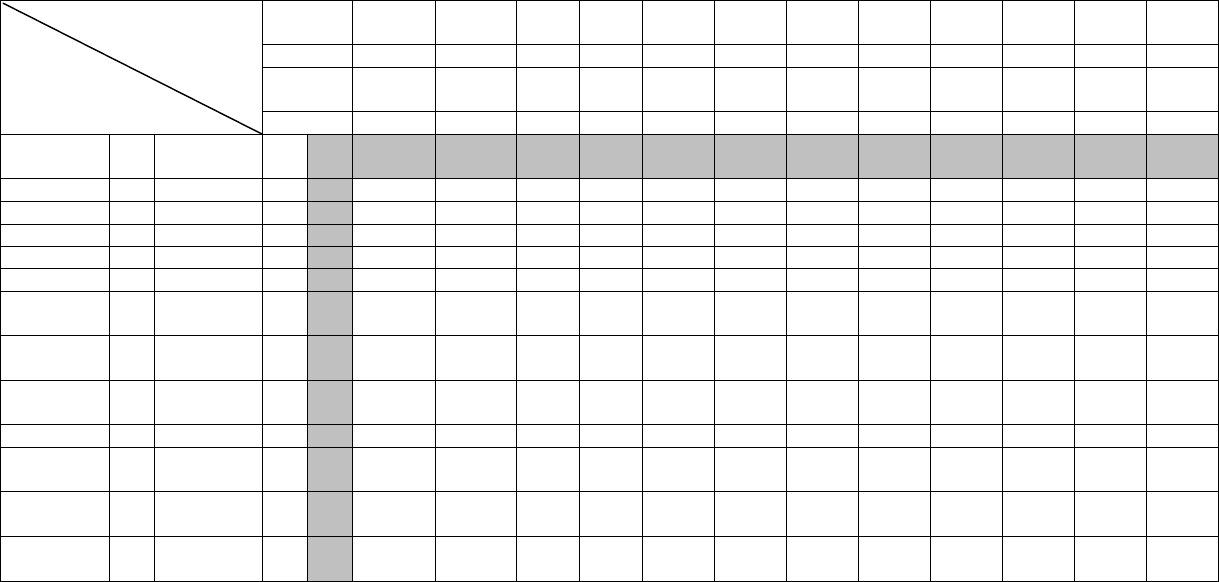
Table 5.15: TPA-24 and LNA-10 Extension Range Table. Data Rate = 2Mbps, Sen=-75dBm
TX kit Omni-6/10 Omni-6/10 Omni-6
(TPA)
Omni-6
(TPA)
Uni-18/10 Uni-18/10 Uni-18/10
(TPA)
Uni-18/10
(TPA)
Uni-24/10 Uni-24/10 Uni-24/10
(TPA)
Uni-24/10
(TPA)
TX EIRP 21 21 30 30 33 33 42 42 39 39 48 48
RX kit Omni-6/10 Omni-6
(LNA 10)
Omni-
6/10
Omni-6
(LNA)
Uni-18/10 Uni-18/10
(LNA)
Uni-18/10 Uni-18/10
(LNA)
Uni-24/10 Uni-24/10
(LNA)
Uni-24/10 Uni-24/10
(LNA)
Transmit and Receive
Antenna Kits
for Side A
Transmit and
Receive Antenna Kits
for Side B RX Gain 48.35 48.35 16 20.35 16 20.35 22 26.35 22 26.35
TX kit EIRP RX kit RX
Gain
Omni-6/10 21 Omni-6/10 4560m 560m 560m 930m 1,650m 1,650m 1,650m 2,260m 2,550m 2,550m 2,550m 3,480m
Omni-6/10 21 Omni-6 (LNA) 8.35 560m 930m 560m 930m 1,650m 2,260m 1,650m 2,260m 2,550m 3,480m 2,550m 3,480m
Omni-6 (TPA) 30 Omni-6/10 4560m 560m 1,330m 1,330m 1,650m 1,650m 3,160m 3,160m 2,550m 2,550m 4,870m 4,870m
Omni-6 (TPA) 30 Omni-6 (LNA) 8.35 930m 930m 1,330m 1,820m 2,260m 2,260m 3,160m 4,320m 3,480m 3,480m 4,870m 6,660m
Uni-18/10 33 Uni-18/10 16 1,650m 1,650m 1,650m 2,260m 3,920m 3,920m 3,920m 5,370m 6,040m 6,040m 6,040m 8,260m
Uni-18/10 33 Uni-18/10
(LNA)
20.35 1,650m 2,260m 1,650m 2,260m 3,920m 5,370m 3,920m 5,370m 6,040m 8,260m 6,040m 8,260m
Uni-18/10
(TPA)
42 Uni-18/10 16 1,650m 1,650m 3,160m 3,160m 3,920m 3,920m 7,500m 7,500m 6,040m 6,040m 11,550m 11,550m
Uni-18/10
(TPA)
42 Uni-18/10
(LNA)
20.35 2,260m 2,260m 3,160m 4,320m 5,370m 5,370m 7,500m 10,260m 8,260m 8,260m 11,550m 15,790m
Uni-24/10 39 Uni-24/10 22 2,550m 2,550m 2,550m 3,480m 6,040m 6,040m 6,040m 8,260m 9,310m 9,310m 9,310m 12,730m
Uni-24/10 39 Uni-24/10
(LNA)
26.35 2,550m 3,480m 2,550m 3,480m 6,040m 8,260m 6,040m 8,260m 9,310m 12,730m 9,310m 12,730m
Uni-24/10
(TPA)
48 Uni-24/10 22 2,550m 2,550m 4,870m 4,870m 6,040m 6,040m 11,550m 11,550m 9,310m 9,310m 17,780m 17,780m
Uni-24/10
(TPA)
48 Uni-24/10
(LNA)
26.35 3,480m 3,480m 4,870m 6,660m 8,260m 8,260m 11,550m 15,790m 12,730m 12,730m 17,780m 24,320m
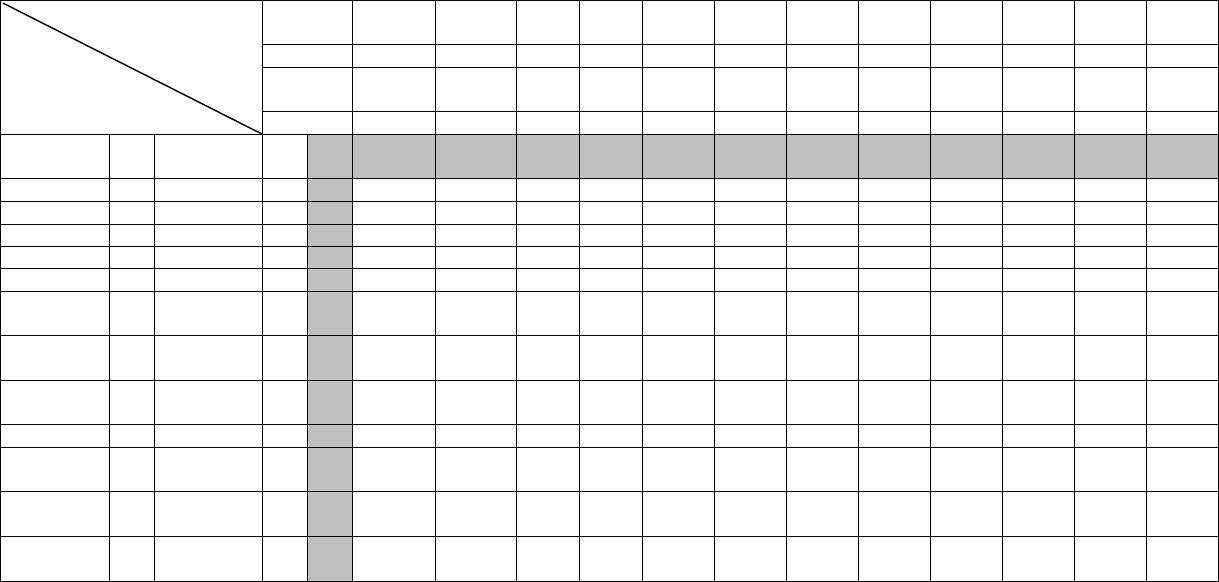
Table 5.16: TPA-24 and LNA-10 Extension Range Table. Data Rate = 3Mbps, Sen=-67dBm
TX kit Omni-6/10 Omni-6/10 Omni-6
(TPA)
Omni-6
(TPA)
Uni-18/10 Uni-18/10 Uni-18/10
(TPA)
Uni-18/10
(TPA)
Uni-24/10 Uni-24/10 Uni-24/10
(TPA)
Uni-24/10
(TPA)
TX EIRP 21 21 30 30 33 33 42 42 39 39 48 48
RX kit Omni-6/10 Omni-6
(LNA 10)
Omni-
6/10
Omni-6
(LNA)
Uni-18/10 Uni-18/10
(LNA)
Uni-18/10 Uni-18/10
(LNA)
Uni-24/10 Uni-24/10
(LNA)
Uni-24/10 Uni-24/10
(LNA)
Transmit and Receive
Antenna Kits
for Side A
Transmit and
Receive Antenna Kits
for Side B RX Gain 48.35 48.35 16 20.35 16 20.35 22 26.35 22 26.35
TX kit EIRP RX kit RX
Gain
Omni-6/10 21 Omni-6/10 4220m 220m 220m 370m 890m 890m 890m 1,270m 1,430m 1,430m 1,430m 1,960m
Omni-6/10 21 Omni-6 (LNA) 8.35 220m 370m 220m 370m 890m 1,270m 890m 1,270m 1,430m 1,960m 1,430m 1,960m
Omni-6 (TPA) 30 Omni-6/10 4220m 220m 630m 630m 890m 890m 1,780m 1,780m 1,430m 1,430m 2,740m 2,740m
Omni-6 (TPA) 30 Omni-6 (LNA) 8.35 370m 370m 630m 1,030m 1,270m 1,270m 1,780m 2,430m 1,960m 1,960m 2,740m 3,740m
Uni-18/10 33 Uni-18/10 16 890m 890m 890m 1,270m 2,210m 2,210m 2,210m 3,020m 3,400m 3,400m 3,400m 4,650m
Uni-18/10 33 Uni-18/10
(LNA)
20.35 890m 1,270m 890m 1,270m 2,210m 3,020m 2,210m 3,020m 3,400m 4,650m 3,400m 4,650m
Uni-18/10
(TPA)
42 Uni-18/10 16 890m 890m 1,780m 1,780m 2,210m 2,210m 4,220m 4,220m 3,400m 3,400m 6,490m 6,490m
Uni-18/10
(TPA)
42 Uni-18/10
(LNA)
20.35 1,270m 1,270m 1,780m 2,430m 3,020m 3,020m 4,220m 5,770m 4,650m 4,650m 6,490m 8,880m
Uni-24/10 39 Uni-24/10 22 1,430m 1,430m 1,430m 1,960m 3,400m 3,400m 3,400m 4,650m 5,230m 5,230m 5,230m 7,160m
Uni-24/10 39 Uni-24/10
(LNA)
26.35 1,430m 1,960m 1,430m 1,960m 3,400m 4,650m 3,400m 4,650m 5,230m 7,160m 5,230m 7,160m
Uni-24/10
(TPA)
48 Uni-24/10 22 1,430m 1,430m 2,740m 2,740m 3,400m 3,400m 6,490m 6,490m 5,230m 5,230m 10,000m 10,000m
Uni-24/10
(TPA)
48 Uni-24/10
(LNA)
26.35 1,960m 1,960m 2,740m 3,740m 4,650m 4,650m 6,490m 8,880m 7,160m 7,160m 10,000m 13,680m

Planning and Installing Wireless LANs
BreezeNET PRO.11 Series 5-31 User’s Guide
5.4. Available Antennas and Antenna Kits
This following table describes several transmit/receive antennas that work
well with BreezeNET PRO.11 units.
Table 5.17: FCC Available Antennas (USA)
Model Ant.
Gain
Cable
Len
Kit Contains: Ideal for: Disper-
sion.
Dimensions
H x W x D
OMNI-2 2 dBi N/A 2 OMNI-2 Antennas
Proprietary SMA
Converting “D”
Models for use
indoors
360°H/
60° V
3"x.5"
Tubular
OMNI-6 6 dBi 4-ft OMNI-6 Antenna
Mounting Hardware
4-ft Cable Assembly
Extending indoor
range of access
points and station
adapters
360°H/
26° V
13"x0.75"
Tubular
OMNI-7.2 7.2 dBi 20-ft OMNI-7.2 Antenna
Mounting Hardware
20-ft Cable
Assembly
Establishing 360°
coverage for
outdoor multipoint
links
360°H/
22° V
16"x0.75"
Tubular
UNI-8.5 8.5 dBi 8-ft UNI-8.5 Antenna
Mounting Hardware
8-ft Cable
Extending indoor
range of access
points and/or
station adapters
75°H/
60° V
4"x3.7"x1.2"
UNI-8.5Ext 8.5 dBi 8-ft UNI-8.5 Antenna
Mounting Hardware
8-ft Cable Assembly
Short range
outdoor multipoint
links
75°H/
60° V
4"x3.7"x1.2"
UNI-11P-75 11 dBi 30-ft UNI-11P-75
Antenna Mounting
Hardware 30-ft
Cable Assembly
ISPs, school
districts, and
campus area
networks requiring
wide dispersion
patterns
75°H/
28° V
11"x7.5"x3.5"
UNI-13P 13 dBi 20-ft UNI-13P Antenna
Mounting Hardware
20-ft Cable
Assembly
Medium range
outdoor multipoint
links
46°H/
28° V
11"x7.5"x3.5"
UNI-16P 16 dBi 30-ft UNI-16P Antenna
Mounting Hardware
30-ft Cable
Assembly
Medium to long
range outdoor
multipoint links
requiring compact
form factors
28°H/
28° V
11"x11"x3.5"
UNI-18 18 dBi 30-ft UNI-18 Antenna
Mounting Hardware
30-ft Cable
Assembly
Long range
outdoor point-to-
point and
multipoint links
12°H/
14° V
16"x20"X15"
UNI-24 24 dBi 50-ft UNI-24 Antenna
Mounting Hardware
50-ft Cable
Assembly
Long range
outdoor point-to-
point links
6°H/
10° V
24"x36"x15"
Table 5.18: ETSI Available Antennas (Europe and Rest-of-World)

Planning and Installing Wireless LANs
BreezeNET PRO.11 Series 5-32 User’s Guide
Model Ant.
Gain
Cable
Len
Kit Contains: Ideal for: Disper-
sion.
Dimensions
H x W x D
OMNI-2 2 dBi N/A 2 OMNI-2 Antennas
Proprietary SMA
Converting “D”
Models for use
indoors
360°H/
60° V
3"x.5"
Tubular
OMNI-6 6 dBi 3m OMNI-6 Antenna
90° Mount Bracket
3m RG-58 Cable
Extending indoor
range of access
points and station
adapters
360°H/
26° V
13"x0.75"
Tubular
UNI-8.5 8.5 dBi 6m UNI-8.5 Antenna
Wall Mounting HW
6m RG-58 Cable
Extending indoor
range of access
points and/or
station adapters
75°H/
60° V
4"x3.7"x1.2"
UNI-18/10
UNI-18/15
UNI-18/20
18 dBi 10m
15m
20m
UNI-18 Antenna
U-bolt for pole
Heliax Cable
Long range
outdoor point-to-
point and
multipoint links
12°H/
14° V
16"x20"X15"
UNI-24/10
UNI-24/15
UNI-24 /20
24 dBi 10m
15m
20m
UNI-24 Antenna
U-bolt for pole
Heliax Cable
Long range
outdoor point-to-
point links
6°H/
10° V
24"x36"x15"
5.5. Precautions
5.5.1. Professional Installers Only
Caution: Detached antennas, whether installed indoors or out, should be installed
ONLY by experienced antenna installation professionals who are
familiar with local building and safety codes and, wherever applicable,
are licensed by the appropriate government regulatory authorities.
Failure to do so may void the BreezeNET Product Warranty and may
expose the end user to legal and financial liabilities. BreezeCOM and its
resellers or distributors are not liable for injury, damage or violation of
government regulations associated with the installation of detached
antennas.
5.5.2. Transmit Antenna Gain
Regulations regarding maximum antenna gains vary from country to
country. It is the responsibility of the end user to operate within the limits of
these regulations and to ensure that the professional installer is aware of
these regulations, as well. The FCC in the United States and ETSI in Europe
limit effective transit power to 36dBm (USA) and 20dBm (Europe). The

Planning and Installing Wireless LANs
BreezeNET PRO.11 Series 5-33 User’s Guide
maximum total assembly gain of antennas and cables in this case equals
19dBi (USA) and 3dBi (Europe).
Violation of government regulations exposes the end user to legal and
financial liabilities. BreezeCOM and its resellers and distributors shall not
be liable for expense or damage incurred as a result of installations which
exceed local transmit gain limitations.
5.5.3. Spurious Radio Frequency Emissions
The regulations referred to in the previous section also specify maximum
“out-of-band” radio frequency emissions. Install a filter as close as possible
to the BreezeNET PRO.11 “D” model unit connector.
5.5.4. Lightning Protection
Lightning protection is designed to protect people, property and equipment
by providing a path to ground for the lightning’s energy. The lightning
arrestor diverts the strike energy to ground through a deliberate and
controlled path instead of allowing it to choose a random path. Lightning
protection for a building is more forgiving than protection of electronic
devices. A building can withstand up to 100,000 volts, but electronic
equipment may be damaged by just a few volts.
Lightning protection entails connecting an antenna discharge unit (also
called an arrestor) to each cable as close as possible to the point where it
enters the building. It also entails proper grounding of the arrestors and of
the antenna mast (if the antenna is connected to one).
The lightning arrestor should be installed and grounded at the point where
the cable enters the building. The arrestor is connected to the unit at one end
and to the antenna at the other end.
The professional installer you choose must be knowledgeable about
lightning protection. The installer must install the lightning protector in a
way that maximizes lightning protection. BreezeCOM offers the following
high-quality lightning arrestor assembly:
BreezeNET AL 1 Lightning Arrestor - Part No. 872905 5 ft (1.5m), “N”
Male to “N” Female.

Planning and Installing Wireless LANs
BreezeNET PRO.11 Series 5-34 User’s Guide
5.5.5. Rain Proofing
12, 18, and 24 dBi antennas must be sealed against rain at the point the
cable enters the pole before they are suitable for external use.

Accessory Installation
BreezeNET PRO.11 Series 6-1User’s Guide
6. ACCESSORY INSTALLATION
This chapter introduces some of the accessories available for specific
installations, and describes how to install them.
6.1. TPA 24 Transmit Power Amplifier (Booster)
The TPA 24 transmit power amplifier is used to amplify the transmit power
to a fixed output of 24 dBm (250 mW). The TPA 24 is especially useful
when long RF cable runs are required. In addition, the TPA 24 simplifies
antenna alignment by enabling the use of wider dispersion transmit antennas
(12 dBi maximum). The TPA 24 is internally protected against lightning
and voltage surge protection.
There are two models:
• The TPA 24 NL receives input power in the range of -10dBm to 0dBm.
• The TPA 24 NH receives an input power of 0dBm to +10dBm. Both
models then amplify the input power to a fixed output level of 24dBm
(250mW).
The TPA is powered by 12VDC carried from the power inserter by the RF
cable.
Note: The TPA 24 is not available in the USA due to FCC regulations.
When used in compliance with ETSI regulations, the TPA 24 can be
connected to cables and antennas resulting in a total transmitted power of
20dBm (100 mW) EIRP.
For technical specifications, refer to section 9.2.2 Specifications for TPA 24
Transmit Power Amplifier.
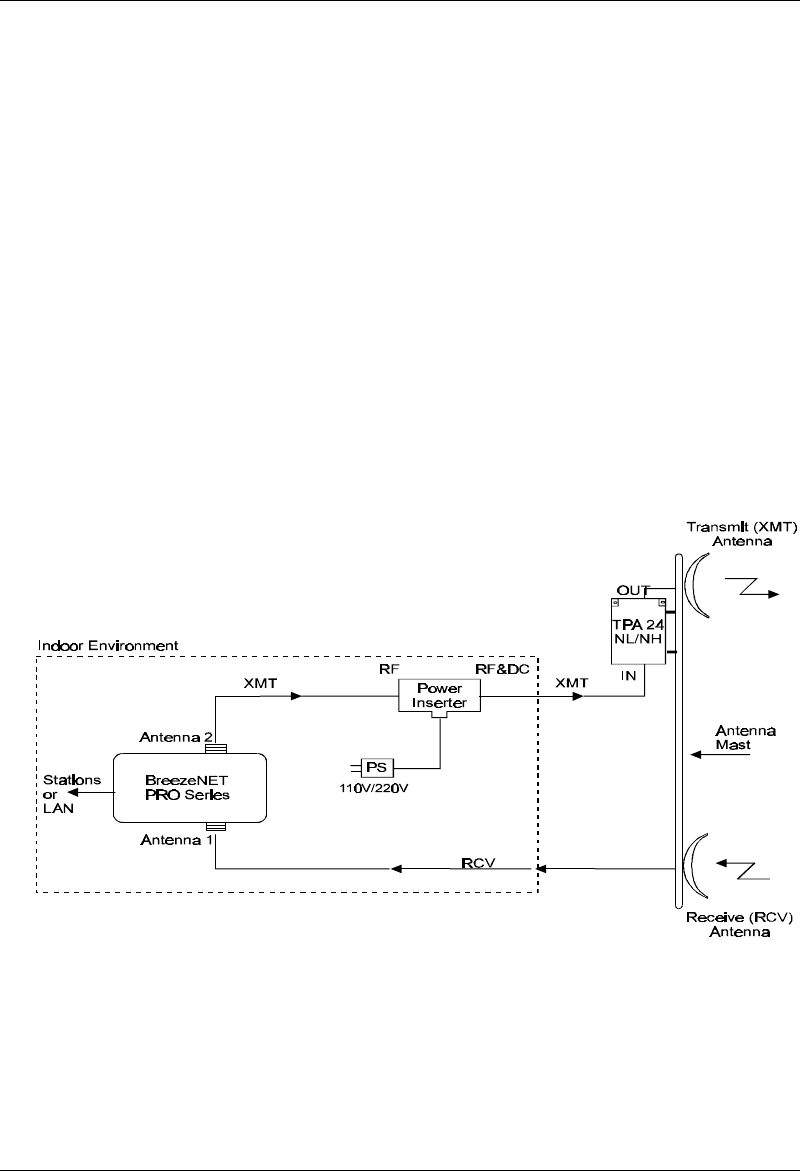
Accessory Installation
BreezeNET PRO.11 Series 6-2User’s Guide
6.1.1. Installing the TPA 24
⇒⇒ To install the TPA 24:
1. Choose one of the TPA 24 models according to the power level at
the input of the booster. In general the NH model is used. For
installations with long cables (high attenuations), the NL model
should be used.
2. Choose one of the antenna connectors to be used for transmission.
This connector is called the transmit antenna of the unit.
3. Configure the BreezeNET PRO.11 unit via the Monitor to transmit
through the transmit antenna using the Transmit Diversity
parameter (see section 3.4.3).
Figure 6.1: TPA 24 Installation
4. Connect the TPA 24 RF output directly to the transmit antenna.
5. Attach the TPA 24 RF input to the Power Inserter with the RF
cable. The Power Inserter must be installed indoors.

Accessory Installation
BreezeNET PRO.11 Series 6-3User’s Guide
6. Connect the RF cable leading from the Power Inserter to the
transmit antenna on the BreezeNET PRO.11 unit.
7. Plug the power cable leading from the Power Inserter into any
available 110/220V outlet. The power supply must be installed
indoors.
Note: Installations exceeding regulations set by local authorities expose the
installer and the user to potential legal and financial liabilities.
8. For reception, use a separate antenna connected to the other
antenna connector of the BreezeNET unit.
6.2. LNA 10 Low Noise Receive Amplifier
The LNA 10 is a high-performance, low-noise preamplifier designed to
enhance fringe area reception and provide additional gain on the receive
antenna. Its exceptionally small size and light weight enables it to be
directly mounted on the antenna by means of the female RF IN connector.
Power is obtained through an RG-59 coaxial cable connected to the power
supply. The LNA 10 is internally protected against lightning and voltage
surge protection.
The Power Supply (PS) and Power Inserter are supplied with the LNA 10.
The RG-59 coaxial cable with F-type connector is not supplied and must be
purchased separately.
For technical specifications, refer to Specifications for LNA 10 Low Noise
Receive Amplifier in the appendices.
6.2.1. Installing the LNA 10
Before installing the LNA 10, the following steps must be taken:
1. Choose one of the antenna connectors to be used for reception. This
connector is called the receive antenna of the unit. The other
connector is called the transmit antenna of the unit.
2. Configure the BreezeNET PRO.11 unit via the Monitor to transmit
through the transmit antenna only using the Transmit Diversity
parameter (see section 3.4.3). This prevents transmission from
going through the LNA 10.
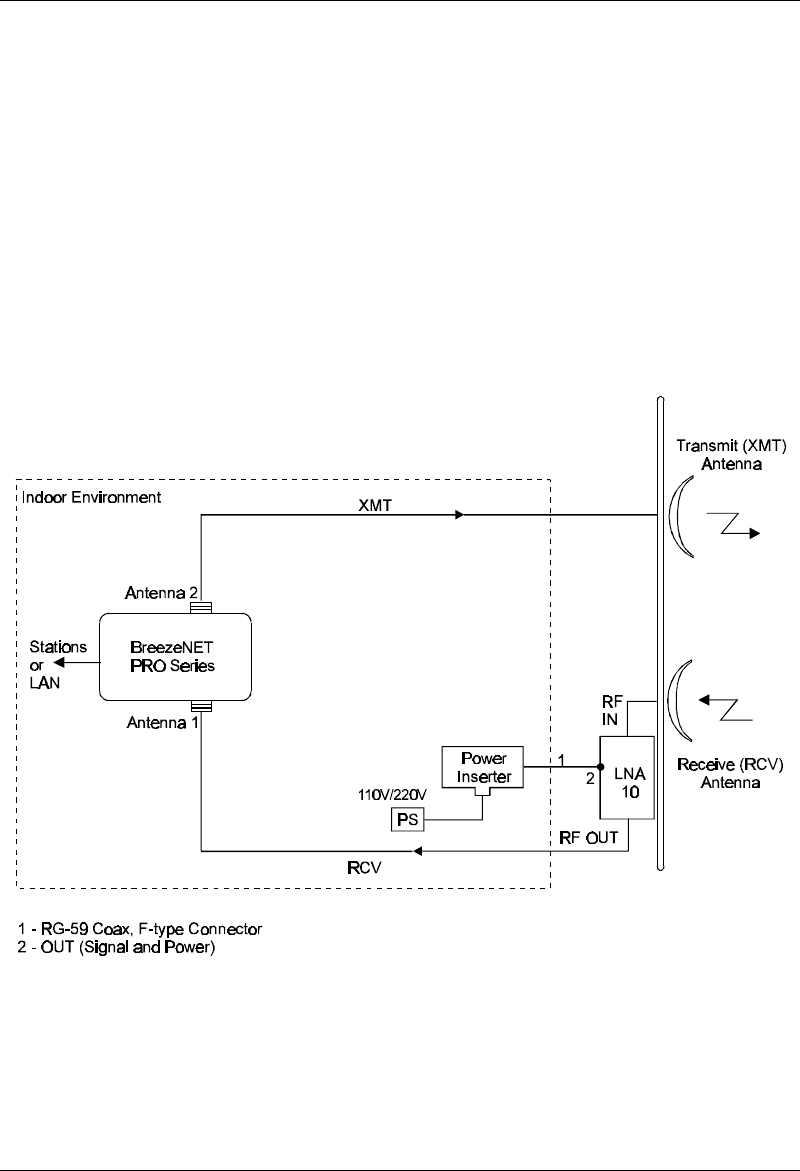
Accessory Installation
BreezeNET PRO.11 Series 6-4User’s Guide
3. Connect the LNA 10 RF input directly to the receive antenna, as
close as possible.
4. Attach the LNA 10 RF output directly to the RF cable going down
to the receive antenna connector on the BreezeNET PRO.11 unit.
5. Connect the RG-59 coaxial cable which leads down to the Power
Inserter to the “Signal and Power out” connector on the LNA 10.
6. Connect the Power Inserter to the power supply (both are indoor
units).
7. For transmission, use a separate antenna connected to the other
antenna connector (transmit antenna) of the BreezeNET unit.
Figure 6.2: LNA 10 Connections Diagram
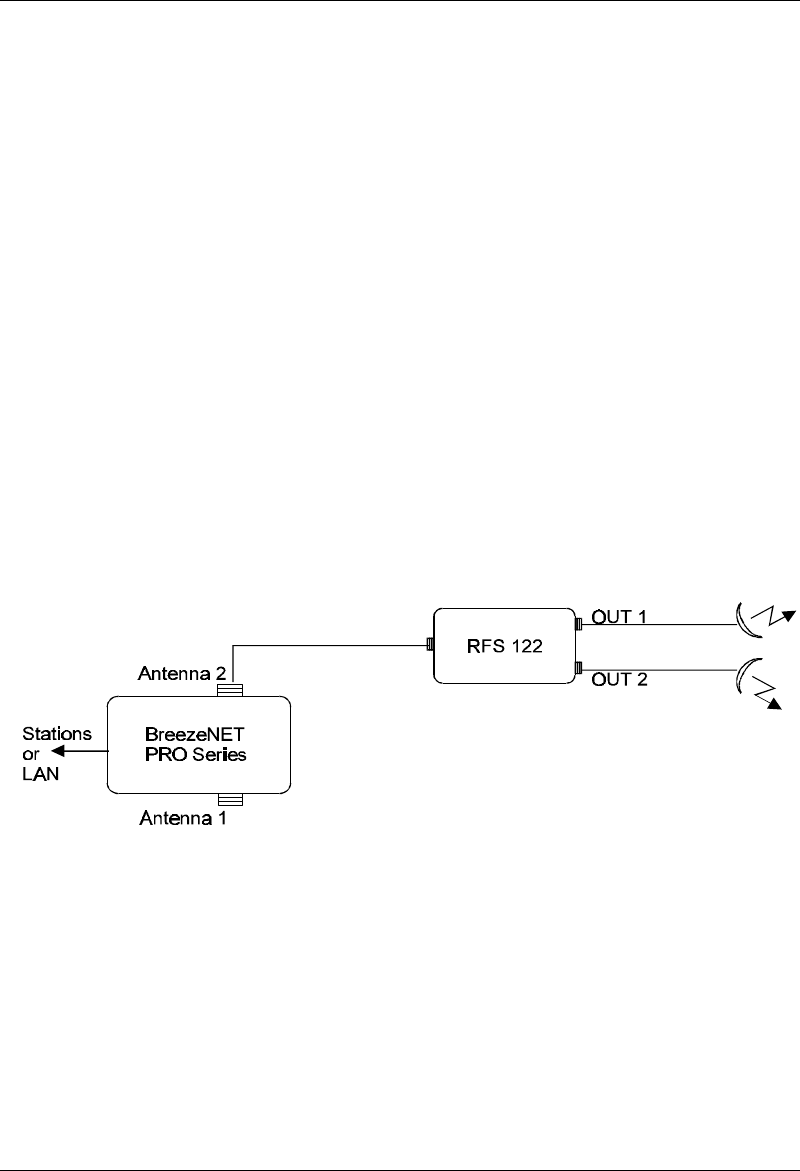
Accessory Installation
BreezeNET PRO.11 Series 6-5User’s Guide
6.3. RFS 122 Radio Frequency Splitter
The RFS 122 Radio Frequency Splitter is used to split the RF signal
generated by a transmitter into two signals. These signals are then sent to
two different and independent antennas. The RFS 122 enables radio
transmission using two directional antennas connected to the same port of
the BreezeNET PRO.11 unit. Similarly, the splitter is used to combine two
receiving antennas to one antenna connector.
Before installing the RFS 122, configure the BreezeNET PRO.11 unit via the
Monitor to transmit through Antenna 2 only using the Transmit Diversity
parameter (see section 3.4.3), and connect the RFS 122 to antenna
connector 2.
For technical specifications, refer to section 9.2.4, Specifications for RFS
122 Radio Frequency Splitter.
6.3.1. Installing the RFS 122
The following diagram illustrates RFS-122 installation.
Figure 6.3: RFS-122 Connection Diagram
6.4. AL 1 Lightning Arrestor
The AL 1 Lightning Arrestor is used to protect transmitters and receivers
from transients originating from lightning or EMP.
The AL 1 is gas tube-based and is not radioactive. The gas discharge tube
can sustain several transients if the time period between transients is
sufficient to allow the tube to cool down.
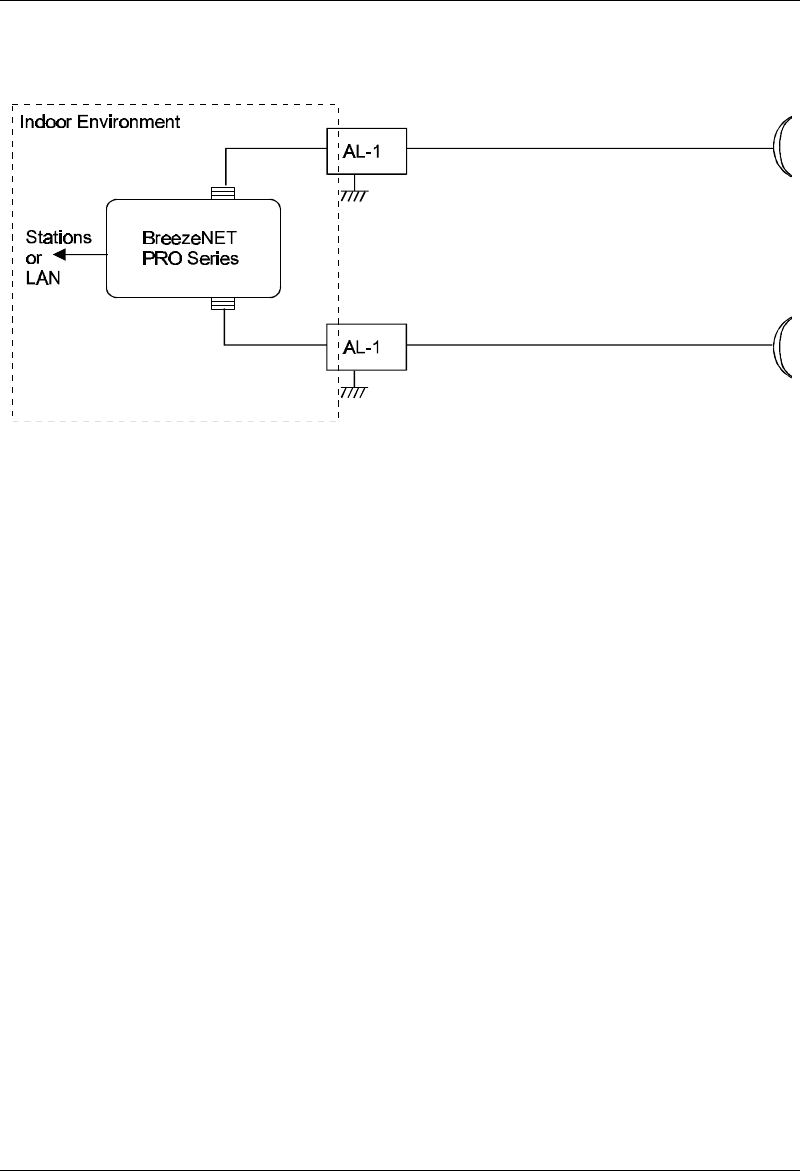
Accessory Installation
BreezeNET PRO.11 Series 6-6User’s Guide
For technical specifications, refer to section 9.2.5, Specifications for AL 1
Lightning Arrestor.
Figure 6.4: AL-1 Connection Block Diagram
One of the female-type N connectors is mounted directly through a hole in
the shelter wall and held in place with a lockwasher and nut.

Upgrade Procedure
BreezeNET PRO.11 Series 7-1User’s Guide
7. UPGRADE PROCEDURE
Firmware upgrades to the unit's flash memory is done by a simple download
procedure using a TFTP application. Before beginning an upgrade, be sure
you have the correct files and latest instructions. Upgrade packages can be
obtained at the BreezeCOM web site: www.breezecom.com.
In general terms, upgrading includes the following steps:
1. Set up an IP connection to the device. You can verify working
connection using the Ping command.
2. Run TFTP software and connect to the device.
3. Use TFTP to download the erase file to the device Use the tables
below to determine the specific file to use, according to the unit’s
current version. This causes the flash memory to be cleared. Do not
reset the device now.
4. Use TFTP to download the software file to the device. Use the
tables below to determine the specific file to use, according to the
unit’s current version.
5. The unit resets itself and comes up with the new upgraded version.
Table 7.1: Upgrade Files
Software Download File Name
Current Version
of Unit Flash Erase
File Name AP-10 SA-10, SA-40, WB-10
3.2, 3.38, 3.42, 3.50 download eanaf eansf
3.52, 4.204 erase eanafb eansfb
3.62, 4.210, 4.211 fw-erase ap_fw sawb_fw
The current version and type of the unit determine the files used for
upgrade. For example, when upgrading an AP-10 from version 3.52 to
version 4.211, use the erase and eanafb files. When upgrading a SA-10
from version 3.62 to version 4.211, use the fw-erase and sawb_fw files.

System Troubleshooting
BreezeNET PRO.11 Series 8-1User’s Guide
8. SYSTEM TROUBLESHOOTING
The following troubleshooting guide provides answers to some of the more
common problems which may occur when installing and using BreezeNET
PRO.11 Series products. If problems not mentioned in this guide should
arise, checking the Ethernet and WLAN counters may help (see section 8.2).
If the problem persists, please feel free to contact your local distributor or
the BreezeCOM Technical Support Department.
8.1. Troubleshooting Guide
Problem and Indication Possible Cause Corrective Action
No Power to Unit. PWR LED is
off.
1. Power cord is not properly
connected.
2. Power supply is defective.
1. Verify power cord is properly connected to the
BreezeNET unit and to the power outlet.
2. If this is not the cause, replace the power supply.
Failure to establish wireless link.
WLNK LED is off and unit resets
every few minutes.
1. Power supply to units may be
faulty
2. The units may not have the
same ESSID as the AP-10.
1. Verify power to units (AP and SA/ WB).
2. Verify that all units in the network have the same ESSID
as the AP (ESSID must be identical in all units in the
network):
3. Verify wireless link:
• Set AP and unit (SA or WB) side by side.
• Power on each unit and see if a wireless link is
established (even “D” models without their external
antennas should establish a link if placed side by side with
the AP).
• If the units fail to associate, reset units to factory
default values reset unit (see section 3.4.5). The units
should now establish a wireless link.
Failure to establish wireless link
(“D” models/external antennas)
1. Power supply to units may be
faulty.
2. Cables may be improperly
connected
3. There may be some problem
with antenna installation.
1. Verify power to units.
2. Verify that all cables are connected securely.
3. Refer to previous section and verify wireless link
between the units.
4. Verify that the antenna(s) are properly installed (see
relevant section in this manual):
• Check antenna alignment.
• Verify that antenna polarization is the same at both
ends.
• Verify that the range matches specifications.
• Verify line-of-sight/antenna alignment/antenna height.
Wireless link established, but
there is no Ethernet activity (AP
and WB units).
1. Ethernet hub port or UTP
cable is faulty.
2. Ethernet port in unit is faulty.
1. Check that the LINK LED is on and solid at the hub port.
If this is not the case, the port is inactive. Try another port
on the hub or another UTP cable.
2. Verify that Ethernet port in unit is working. Ping unit to
verify Ethernet connection.
3. Verify that you are using a cross-over UTP cable (pins 1

System Troubleshooting
BreezeNET PRO.11 Series 8-2User’s Guide
Problem and Indication Possible Cause Corrective Action
& 3, 2 & 6) if connected directly to workstation, or a
straight-through cable if connected to a hub.
4. Check ETHR LED indicator in unit and Ethernet
counters in Monitor to verify Ethernet activity (see section
3.6.1).
Wireless link established, but
there is no Ethernet activity (SA-
10 and SA-40 units).
1. Ethernet port on Network
Interface card is faulty.
2. Ethernet port of unit is faulty.
3. UTP cable is faulty.
1. Verify that the LINK LED is lit and solid at the NIC port.
If this is not the case, the port is inactive. Try using
another UTP cable or another workstation.
2. Ping the unit to check the Ethernet port. If you cannot
ping the unit, this may indicate failure of cable, Ethernet
port of unit or Ethernet port of workstation’s NIC. Change
UTP cable and retry. If you still cannot ping the unit,
exchange units and try to ping the new unit using the
same NIC and cable.
No network detected at Station
Adapter (SA-10, SA-40)
workstation.
1. Workstation networking is
improperly configured.
2. UTP cable connection is faulty.
3. Failure to pass Ethernet
packets.
1. Reset both Access Point and Station Adapter.
• Re-establish network connection.
• Verify proper workstation network configuration.
2. Try to ping the remote network. Failure to detect the
network may indicate a failure to pass Ethernet packets.
3. Verify UTP cable connection. Solid LINK LED in
workstation NIC indicates proper Ethernet connection.
4. Check monitor messages for errors or other indications
of problems.
5. Check station counters to verify increase in Ethernet
counters which indicates Ethernet activity (see section
3.6.1).
High quality signal but throughput
is poor.
1. Too much interference or
multipath propagation.
2. Ethernet port of the unit may
be faulty.
1. Move the unit or the antennas out of the range of
interference.
• Check counters to see if more than 10% of total
transmitted frames are retransmitted fragments (see
section 3.6.1).
• Check if more than 10% of total received data frames
are bad fragments (see section 3.6.1).
2. Verify Ethernet port activity by checking Ethernet
counters (see section 3.6.1).
Link signal quality low or not as
good as expected (indoor
installation).
1. Possible multipath or structural
interference.
Reposition the unit outside range of possible interference.
• Check for heavy metal structures (e.g. elevators,
racks, file cabinets) near unit.
• Check counters for excessive retransmissions or
received bad fragments.
• Site may require higher gain antennas.
• site may require a multicell structure (multiple AP units)
due to multipath/structural interference.
Link signal quality low or not as
good as expected (outdoor
installation).
There may be a problem with
certain aspects of outdoor
installation considerations (see
relevant section in this manual).
Refer to section 5.3, Outdoor Installation Considerations:
• Verify that there is a clear line-of-site.
• Verify antenna height.
• Verify antenna polarization.
• Verify antenna alignment.
• Check length of cable between antenna and unit (an

System Troubleshooting
BreezeNET PRO.11 Series 8-3User’s Guide
Problem and Indication Possible Cause Corrective Action
overly long extension cable may adversely affect
performance).
Unit associates with the wrong
Access Point.
In a multicell structure with
overlapping cells, the units may
not associate with the closest
Access Point.
For a unit to associate with a specific Access Point, assign
a unique
ESSID to the Access Point and to all the units you want to
include in that wireless network.
Reduced performance in a multi-
AP configuration.
The APs in the same coverage
area have not been assigned
unique hopping sequences.
Assign a unique hopping sequence to each AP in the
coverage area. Each AP must have a unique hopping
sequence regardless of ESSID.
Rx / Tx calibration
error messages.
Auto Calibration is enabled for a
“DE” unit.
Disable Auto Calibration for the unit (refer to section 3.5).
8.2. Checking Counters
Checking counters is also a good way to pinpoint any problems that may
occur in the BreezeNET wireless LAN. Counters can be checked from the
monitor. See section 3.6.1.
8.2.1. WLAN Counters
When checking WLAN counters, total retransmitted fragments should be
below 10% of total transmitted (bridge) frames. If total retransmitted
fragments are above 10%, this indicates errors in data transmission. Too
many retransmissions may be an indication of interference between the
transmitting and receiving units. Also, the ratio between Frames Dropped
(too many retries) and Total Transmitted Frames (Bridge) should not exceed
1:40 (2.5%)
Received bad fragments should be no more than 10% of the total received
data frames. If more than 10% of the total received data frames are bad
fragments, this may indicate that there is a problem with the wireless link.
Refer to the Troubleshooting guide (section 8) above for possible corrective
action.
8.2.2. Ethernet Counters
When checking the Ethernet counters, received bad frames should be zero
(0). If this is not the case, this may indicate a problem with the Ethernet
connection. Verify Ethernet port link at hub, workstation, and unit. Assign a
unique IP address to the unit and ping.

Appendix
BreezeNET PRO.11 Series 9-1User’s Guide
9. APPENDIX
This appendix includes the following sections:
• Supported MIBs and Traps – Lists MIBs and traps supported by
BreezeNET PRO.11 Series products.
• Technical Specifications – Lists product and attachment specifications.
• Wireless LAN Concepts – Provides an overview of the concepts related
to wireless LANs.
• Radio Signal Propagation – Discusses the concepts and applications of
radio signal propagation relevant to wireless LANs.
• IEEE 802.11 Technical Tutorial – Introduces the new 802.11 standard.
9.1. Supported MIBs and Traps
This chapter lists MIBs and traps supported by BreezeNET PRO.11 Series
products.
9.1.1. Supported MIBs
All products in the BreezeNET PRO.11 Series as well as the Extended Range
Access Point (AP-10 DE) and Workgroup Bridge (WB-10 DE) contain an
embedded SNMP (Simple Network Management Protocol) agent. All
functions can be accessed from the Management Information Base (MIB)
using an SNMP application.
BreezeNET PRO.11 Series agents support the following MIBs:
• MIB-II (RFC1213)
• BRIDGE-MIB (RFC1286)
• BreezeCOM Private MIB
The BreezeCOM Private MIB can be viewed by opening the MIB file on the
provided diskette.

Appendix
BreezeNET PRO.11 Series 9-2User’s Guide
9.1.2. Supported Traps
The following traps are implemented by BreezeNET PRO.11 units. All
BreezeNET PRO.11 units with enabled Trap Sending will send traps to the
network’s designated managers. The traps can be viewed and filtered using
SNMPc.
To enable/disable Trap Sending for a device, use the IP and SNMP
Parameters menu (see section 3.4.2).
The following table lists the traps implemented by BreezeCOM PRO.11
units:
Trap Variables Description
brzAProamingIn brzTrapSTAMacAddr A station has roamed into this AP coverage area. The trap
contains the MAC address of the associated station.
brzAPassociated brzTrapSTAMacAddr A new station is associated with this AP. The trap contains
the MAC address of the associated station.
brzAPdisassociated brzTrapSTAMacAddr A station has disassociated itself from this AP. The trap
contains the MAC address of the associated station.
brzAPaging brzTrapSTAMacAddr A station association was aged out and removed from this
AP. The trap contains the MAC address of the aged-out
station.
brzAProamedout brzTrapSTAMacAddr A station has roamed out of this AP’s range. The trap
contains the MAC address of the station that roamed out.
brzSTAassociated brzLastAPMacAddr
brzTrapAPMac
brzTrapLastRssiQuality
brzTrapRssiQuality
A station has become associated with, or roamed to, a new
AP. The trap contains the MAC address and average RSSI
level of the new AP (TrapAPMac and TrapRssiQuality
variables). If the station has been roaming, the MAC
address of the old AP and the RSSI level prior to roaming
are also provided (LastAPMacAddr and LastRssiQuality
variables). For an association, the second address appears
as all zeros.
brzWlanStatus brzTrapToggle
brzTrapMacAddress
The wireless media condition has changed. An ON value is
sent when the wireless LAN quality for a station or AP drops
below the WLAN trap threshold. An OFF value is sent if the
quality improves beyond the threshold. The current value of
wireless LAN quality is also sent.
brzWlanStatusOfStation brzTrapToggle
brzTrapMacAddress
The quality of the wireless connection to the AP has
changed. An ON value is sent when the connection goes
lower than the predetermined threshold. An OFF value is
sent when the quality improves above the threshold. The
brzTrapMacAddress variable contains the MAC address of
the applicable station.
brzGeneral brzTrapIndex
brzTrapText
For future use.
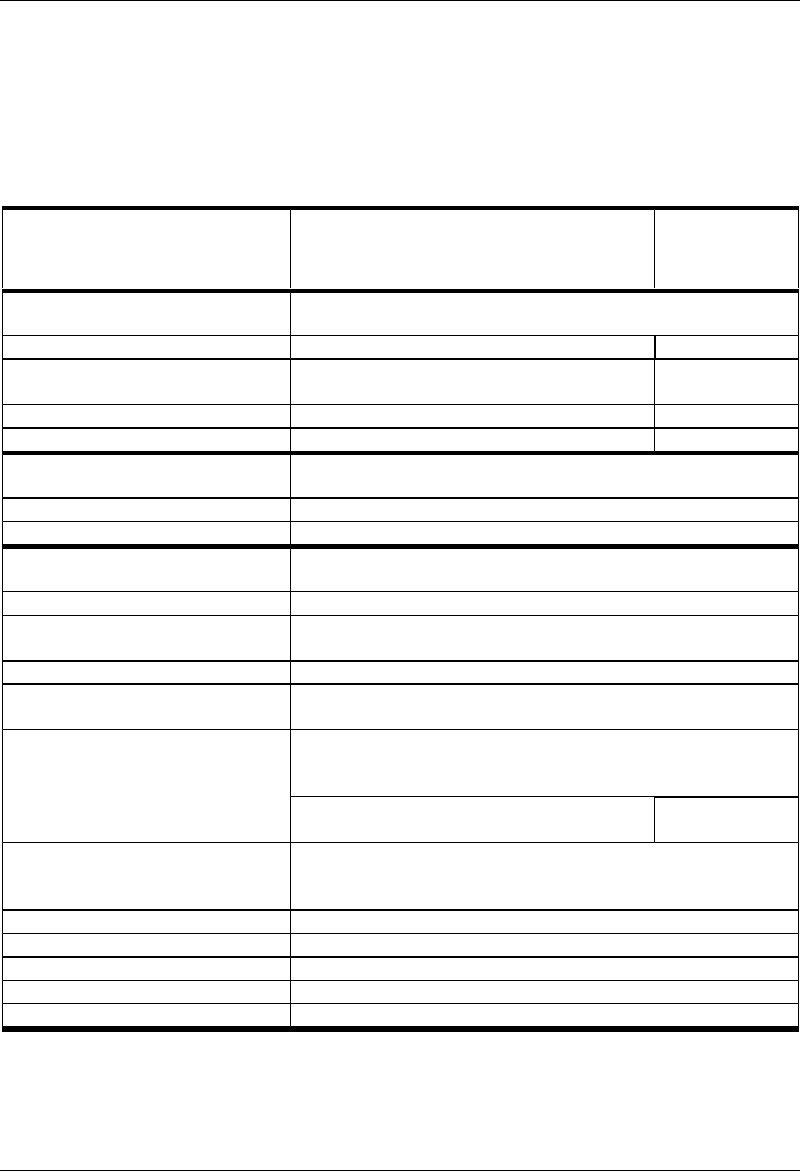
Appendix
BreezeNET PRO.11 Series 9-3User’s Guide
9.2. Technical Specifications
9.2.1. Specifications for BreezeNET PRO.11 Units
The following table provides the technical specifications for all products in
the BreezeNET PRO.11 Series.
Technical Specifications AP-10 PRO.11, SA-10/40 PRO.11,
WB-10 PRO.11 SA-PCR PRO.11
SA-PCD PRO.11
Wired LAN interface
Compliant with Ethernet / IEEE 802.3 CSMA/CD standard N/A
Physical Interface 10BaseT PC Card type II /
PCMCIA 2.1
Network Operating Systems supported All Windows 95, 98, NT4
Network protocols supported All NDIS
Wireless LAN interface
Compliant with IEEE 802.11 CSMA / CA Wireless LAN standard
Physical interface – two antennas Integrated or External
Radio Specifications
Type Frequency Hopping Spread Spectrum (FHSS)
Frequency range 2.4 GHz – 2.4835 GHz (ISM band)
(different ranges available for countries using other bands)
Dwell time 32, 64, 128 ms
Transmitted power:
- integrated antennas Up to 100 mW (20dBm) EIRP
D models:
- High Power (at the connector): 17dBm (50mW)
- Low Power (at the connector): 4dBm (25 mW)
Transmitted power:
- external antennas
DE models:
At the connector: 0.01mW (-2dBm)
N/A
Sensitivity - @ 1 Mbps
- @ 2 Mbps
- @ 3 Mbps
- 81 dBm
- 75 dBm
- 67 dBm
Modulation Multilevel GFSK
Demodulation Technology DSP-based with adaptive equalization
Antenna Diversity Two antennas, selected for use on a packet basis
Frequency Accuracy +/- 10 PPM
Approvals of Compliance FCC part 15, ETS 300-328, UL, UL/C, TUV/GS, CE

Appendix
BreezeNET PRO.11 Series 9-4User’s Guide
Technical Specifications Access
Points
AP-10 PRO.11
Station
Adapters
SA-10/40 PRO.11
Ethernet
Bridges
WB-10 PRO.11
SA-PCR/
SA-PCD
Adapters
SA-PC PRO.11
Configuration and Management
Configuration and Setup Via Local Monitor port (serial RS-232) Via Application
SNMP management
- SNMP agents
- Access via
MIB II, Bridge MIB, WLAN MIB, and private MIB
Wired LAN, Wireless LAN
N/A
Site Survey Via Local Monitor port (serial RS-232)
Via SNMP
Via Application
Front Panel Display LED indicators - Power on
- Wired LAN activity
- Wireless LAN synchronization
- Wireless LAN signal quality/Load
- Link Status
- Data Traffic
S/W upgradeable Through TFTP download via PC
System Considerations
Range (Access Point to Station) Depends on rate and antenna cable length/quality.
(Accurate values must be calculated for specific installations. )
Refer to section 5.3.7, Using Outdoor Range Tables.
- Range - unobstructed with integrated
antennas
2000 ft. (600m) 1500 ft. (450m)
- Range - unobstructed with external
antennas (models D and DE)
USA FCC - up to 6 miles
Europe ETSI - up to 2.5 km
Europe ETSI (DE model only) - up to 5 km
Non-Regulated - 30 km and above
N/A
- Range - Office Environment Up to 500 ft. (150m)
Maximum no. of APs per wired LAN Unlimited
Maximum no. of co-located (overlapping)
cells (Access Points)
15
Data Rate - over the air
- nominal net
- aggregate
1, 2, or 3 Mbps
Up to 2 Mbps
Over 5 Mbps with overlapped cells
High Speed roaming up to 60 mph (90 kph)
Load sharing support yes (with WIX)
Dynamic rate selection based on radio
medium quality
Yes
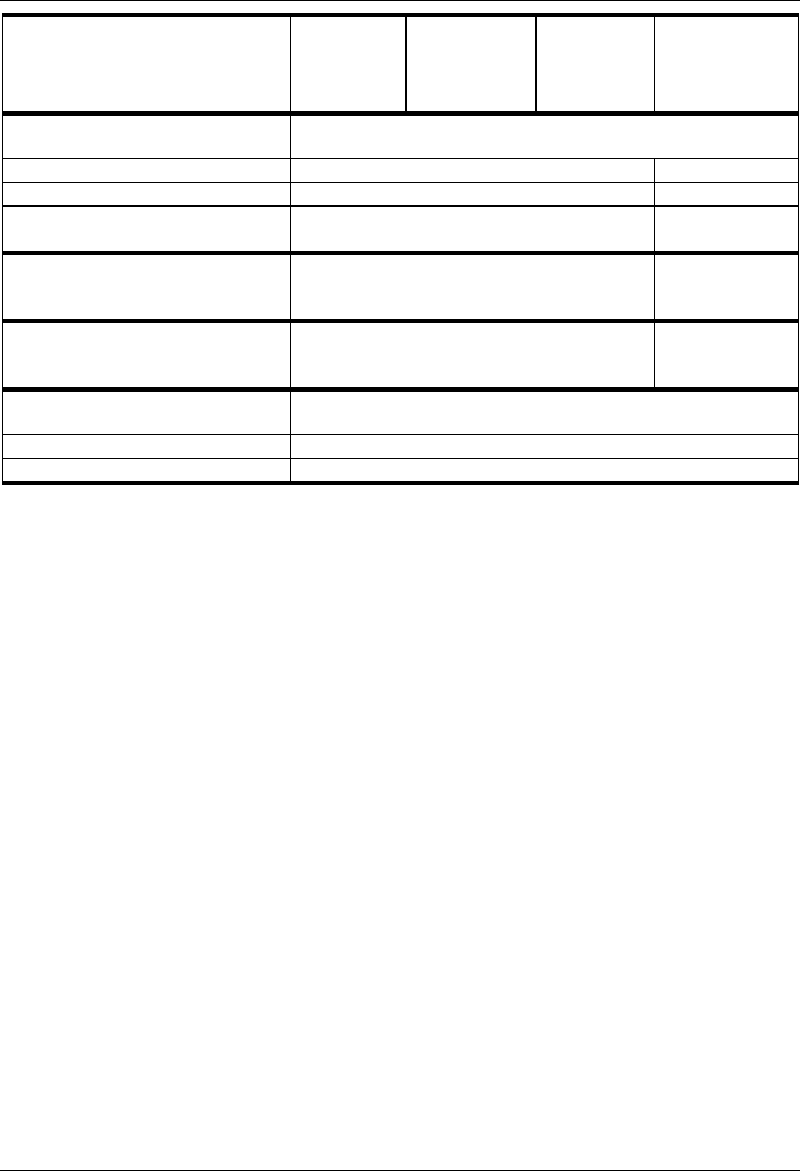
Appendix
BreezeNET PRO.11 Series 9-5User’s Guide
Technical Specifications Access
Points
AP-10 PRO.11
Station
Adapters
SA-10/40 PRO.11
Ethernet
Bridges
WB-10 PRO.11
SA-PCR/
SA-PCD
Adapters
SA-PC PRO.11
Electrical
External Power Supply 100V - 250V, 50-60Hz, 0.5A via network PC
Input Voltage 5Vdc 5Vdc
Power Consumption 1.5A (peak)
1.2A (average)
- XMT 365mA (peak)
- RCV 280mA (peak)
Dimensions (without antennas
and power supply)
5.1” x 3.4” x 1.35”
(13cm x 8.6cm x 3cm)
standard PCMCIA
Type II
Weight (without antennas and
power supply)
0.9 lb. (0.4 kg.) 1.1 oz (32 gr.)
Environmental
Operating Temperature 32° F - 105° F (0° C - 40° C)
Operating Humidity 5% - 95% non-condensing
Note: All specifications are subject to change without notice.

Appendix
BreezeNET PRO.11 Series 9-6User’s Guide
9.2.2. Specifications for TPA 24 Transmit Power Amplifier
Models used with the
BreezeNET PRO.11 Series
• TPA 24 NL
• TPA 24 NH
Input Power • TPA 24 NL: -10dBm - 0dBm (Low input)
• TPA 24 NH: 0dBm - +10dBm (High input)
Output Power 24 dBm (250mW) (fixed output level)
Input Impedance 50Ω
Output Impedance 50Ω (DC short)
Operating Temperature -20° to 50°C
Power Requirements 12V; 420 mA (Power Supply and Power Inserter are supplied with models TPA-
24 NL and TPA-24 NH)
Connectors • TPA 24: IN - N-type Male
OUT - N-type Female
• Power Inserter: RF - N-type Male
RF&DC - N-type Female
Dimensions 70mm x 150mm x 25mm (2.8”x 6”x 1”)
Operating Environment • TPA 24 - For outdoor/indoor use
• Power Supply - For indoor use
• Power Inserter - For indoor use
Note: All specifications are subject to change without notice.

Appendix
BreezeNET PRO.11 Series 9-7User’s Guide
9.2.3. Specifications for LNA 10 Low Noise Receive
Amplifier
Gain 10dB
Noise Figure 1.5dB Typ, 2dB Max.
Response Flatness ± 1.5dB
Max. RF Input Level -15dBm
Input Impedance 50Ω
Output Impedance 50Ω
Connectors • LNA-10: RF IN: N-type, female
RF OUT: N-type, male
Signal and Power IN: not in use
Signal and Power OUT: F-type, female
• Power Inserter: To CONV - F-type, female
To TV - F-type, female
Power Supply:
Required Voltage
Required Current
+12V to +28Vdc
20mA
Operating Temperature -20° C to +50° C
Dimensions 60mm x 35mm x 25mm
(2.3”x 1.3”x 1”)
Operating Environment LNA 10 - outdoor/indoor
Power Supply - indoor
Power inserter - indoor
Note: All specifications are subject to change without notice.

Appendix
BreezeNET PRO.11 Series 9-8User’s Guide
9.2.4. Specifications for RFS 122 Radio Frequency
Splitter
Insertion Loss 3.8dB max.
Isolation 19dB min.
Power Rating 10 W max.
Internal Load Dissipation 125 mW max.
Input Impedance 50Ω
Output Impedance 50Ω
Connectors • SUM: N-type, Male
• PORTS: N-type, Female (on each port)
Operating Temperature -20° C to +85° C
Dimensions 51mm x 51mm x 19mm (2” x 2” x 0.75”)
Operating Environment Outdoor/Indoor
Note: All specifications are subject to change without notice.
9.2.5. Specifications for AL 1 Lightning Arrestor
Turn on voltage 75V
Insertion loss 0.3dB typical
DC path from input to output existing
Operating Temperature -55° C to +70° C
Dimensions 67.5mm x 25mm x 25mm (2.7” x 1” x 1”)
Connectors • Antenna Port: N-type, Female
• Equipment Port: N-type, Female
Operating Environment Indoor/Outdoor
Grounding One of the female-type N connectors is mounted directly through a hole in the
shelter wall and held in place with a lockwasher and nut.
Note: All specifications are subject to change without notice.
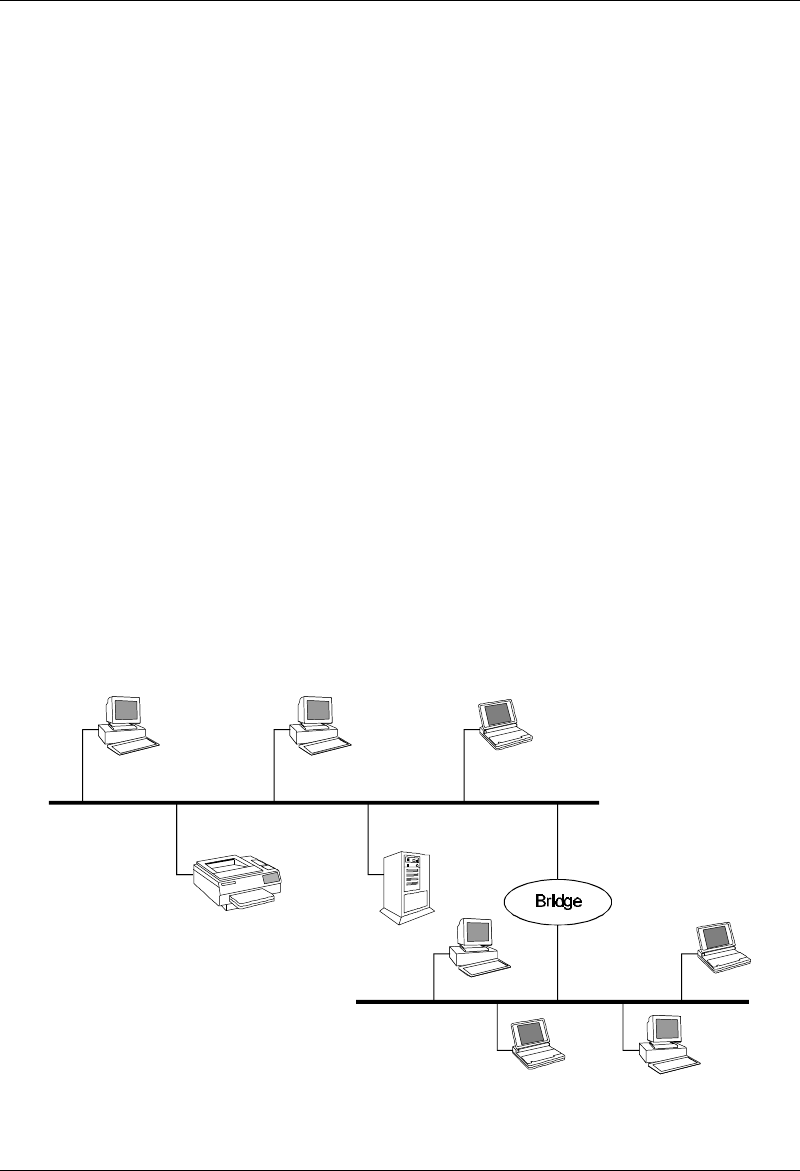
Appendix
BreezeNET PRO.11 Series 9-9User’s Guide
9.3. Wireless LAN Concepts
Wireless LAN technology is becoming increasingly popular for a wide
variety of applications. After evaluating the technology, users are convinced
of its reliability, more than satisfied with its performance, and are ready to
use it for large-scale and complex wireless networks.
Originally designed for indoor office applications, today’s wireless LANs
can be used for both indoor client-server and peer-to-peer networks as well
as for outdoor point-to-point and point-to-multipoint remote bridging
applications.
Wireless LANs are designed to be modular and very flexible. They can also
be optimized for different environments. For example, point-to-point
outdoor links are less susceptible to interference and can have higher
performance if designers increase the “dwell time” and disable the “collision
avoidance” and “fragmentation” mechanisms described later in this section.
Topology
Wired LAN Topology
Traditional LANs (Local Area Networks) link PCs and other computers to
one another and to file servers, printers and other network equipment using
cables or optic fibers as the transmission medium.
Figure 9.1: Wired LAN Topology
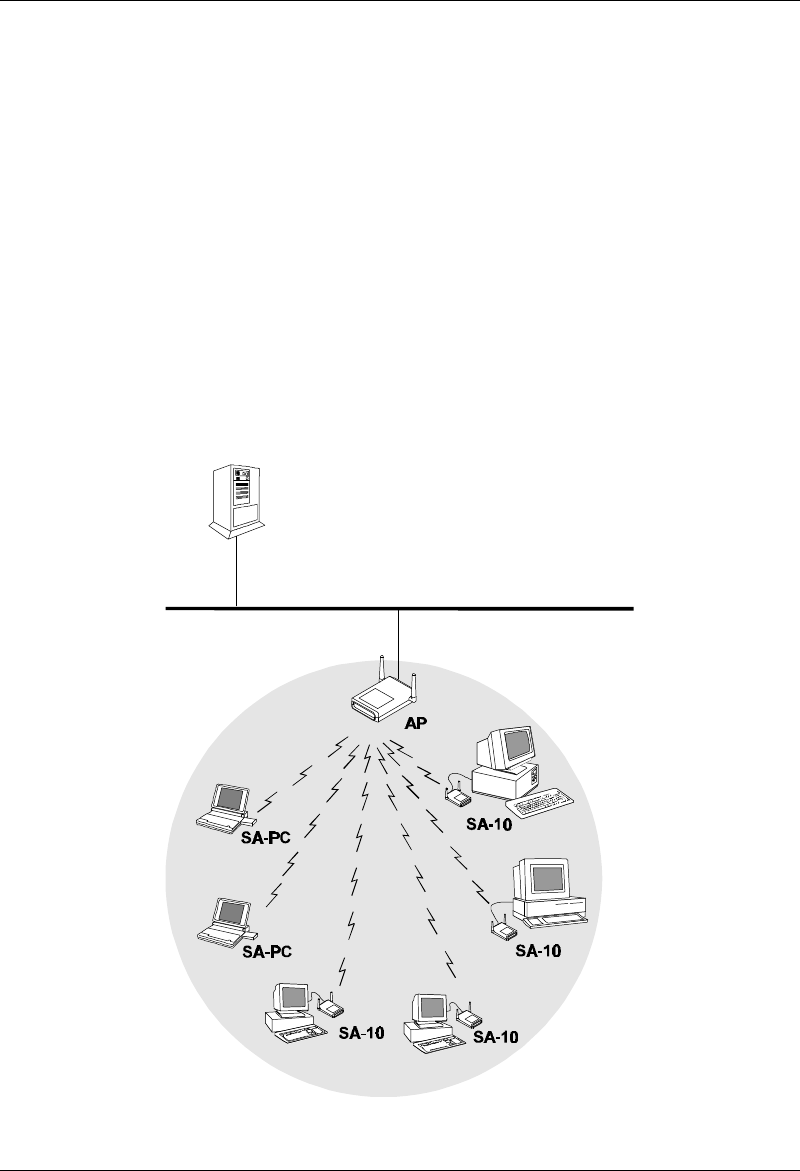
Appendix
BreezeNET PRO.11 Series 9-10 User’s Guide
Wireless LAN Topology
Wireless LANs allow workstations to communicate and to access the
network using radio propagation as the transmission medium. Wireless
LANs can be connected to existing wired LANs as an extension, or can
form the basis of a new network. While adaptable to both indoor and
outdoor environments, wireless LANs are especially suited to indoor
locations such as office buildings, manufacturing floors, hospitals and
universities.
The basic building block of the wireless LAN is the Cell. This is the area in
which wireless communication takes place. The coverage area of a cell
depends on the strength of the propagated radio signal and the type and
construction of walls, partitions and other physical characteristics of the
indoor environment. PC-based workstations, notebook and pen-based
computers can move freely in the cell.
Figure 9.2: The Basic Wireless LAN Cell
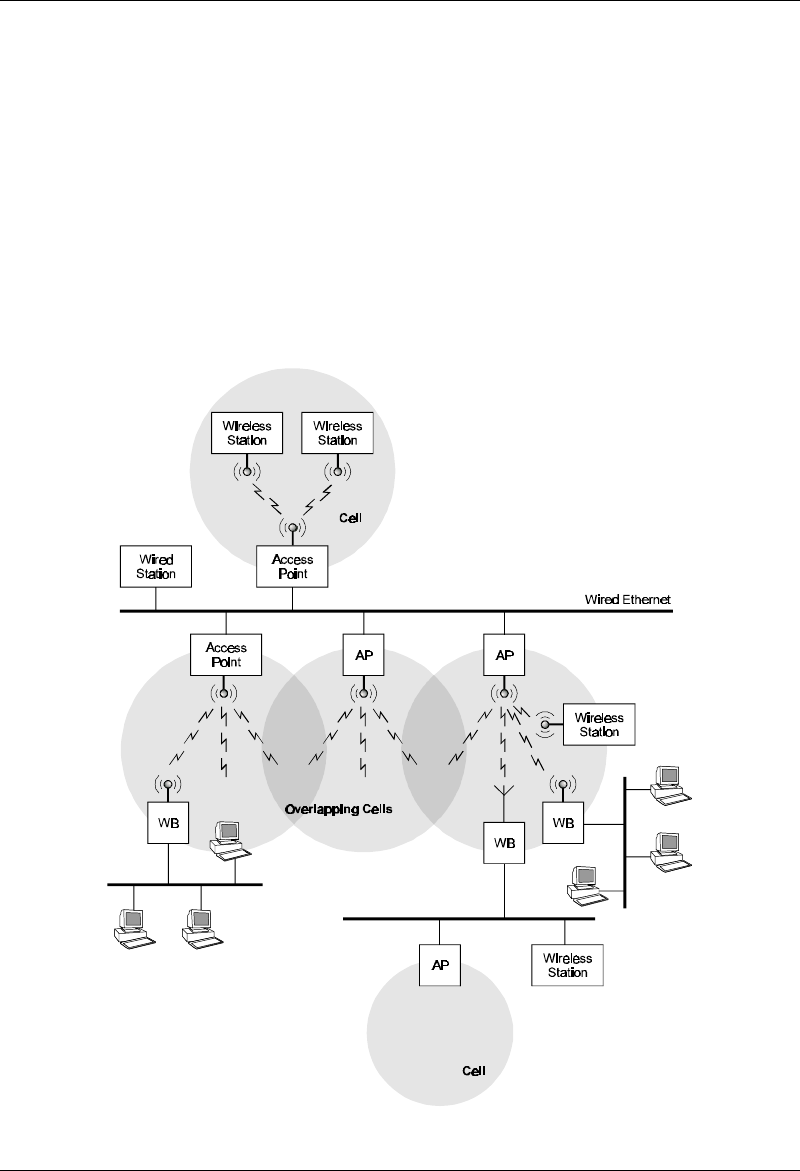
Appendix
BreezeNET PRO.11 Series 9-11 User’s Guide
Each wireless LAN cell requires some communications and traffic
management. This is coordinated by an Access Point (AP) which
communicates with each wireless station in its coverage area. Stations also
communicate with each other via the AP, so communicating stations can be
hidden from one another. In this way, the AP functions as a relay, extending
the range of the system.
The AP also functions as a bridge between the wireless stations and the
wired network and the other wireless cells. Connecting the AP to the
backbone or other wireless cells can be done by wire or by a separate
wireless link, using wireless bridges. The range of the system can be
extended by cascading several wireless links, one after the other.
Figure 9.3: Wireless LAN Connectivity
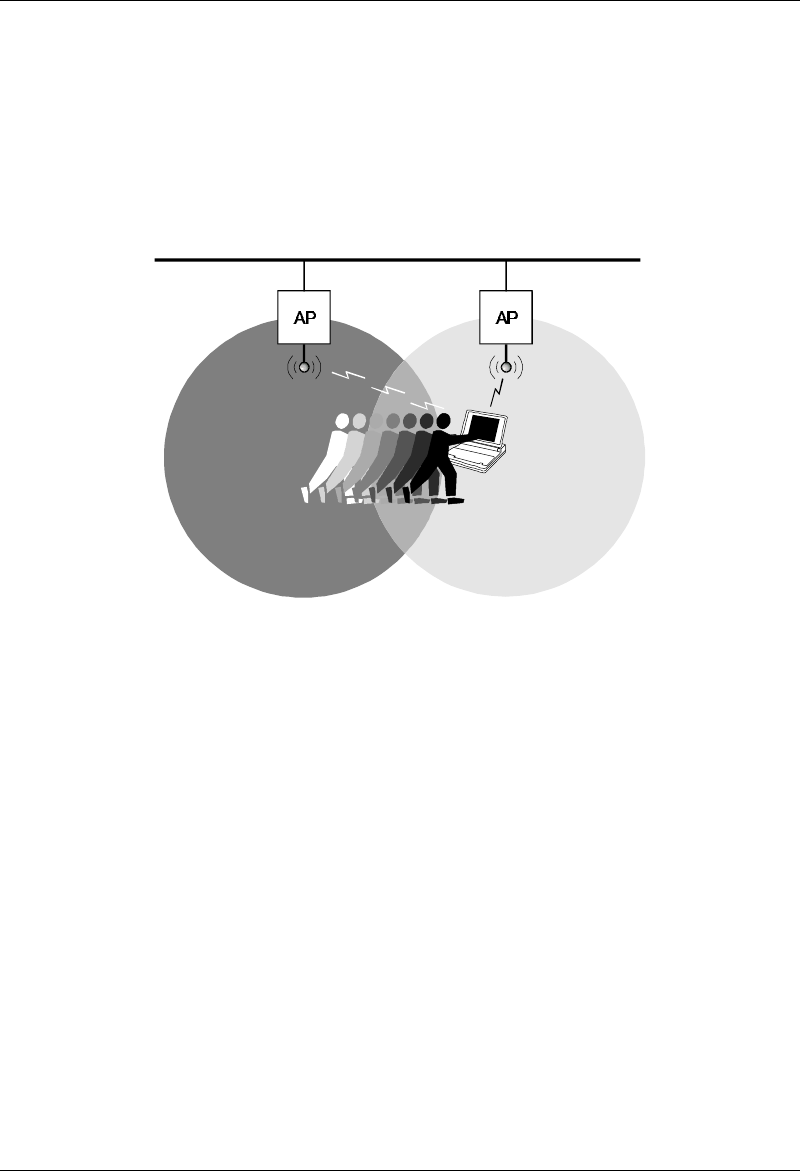
Appendix
BreezeNET PRO.11 Series 9-12 User’s Guide
Roaming
When any area in the building is within reception range of more than one
Access Point, the cells’ coverage is said to overlap. Each wireless station
automatically establishes the best possible connection with one of the
Access Points. Overlapping coverage areas are an important attribute of the
wireless LAN setup, because this enables seamless roaming between
overlapping cells.
Figure 9.4: Roaming Through Overlapping Cells
Roaming allows mobile users with portable stations to move freely between
overlapping cells, constantly maintaining their network connection.
Roaming is seamless: a work session can be maintained while moving from
one cell to another. Multiple Access Points can provide wireless coverage
for an entire building or campus. When the coverage area of two or more
APs overlap, the stations in the overlapping area can establish the best
possible connection with one of the APs, continuously searching for the best
AP. In order to minimize packet loss during switchover, the “old” and
“new” APs communicate to coordinate the process.
Load Balancing
Congested areas with many users and heavy traffic load per unit may require
a multi-cell structure. In a multi-cell structure, several co-located APs
“illuminate” the same area creating a common coverage area which
increases aggregate throughput. Stations inside the common coverage area
automatically associate with the AP that is less loaded and provides the best
signal quality. The stations are equally divided between the APs in order to
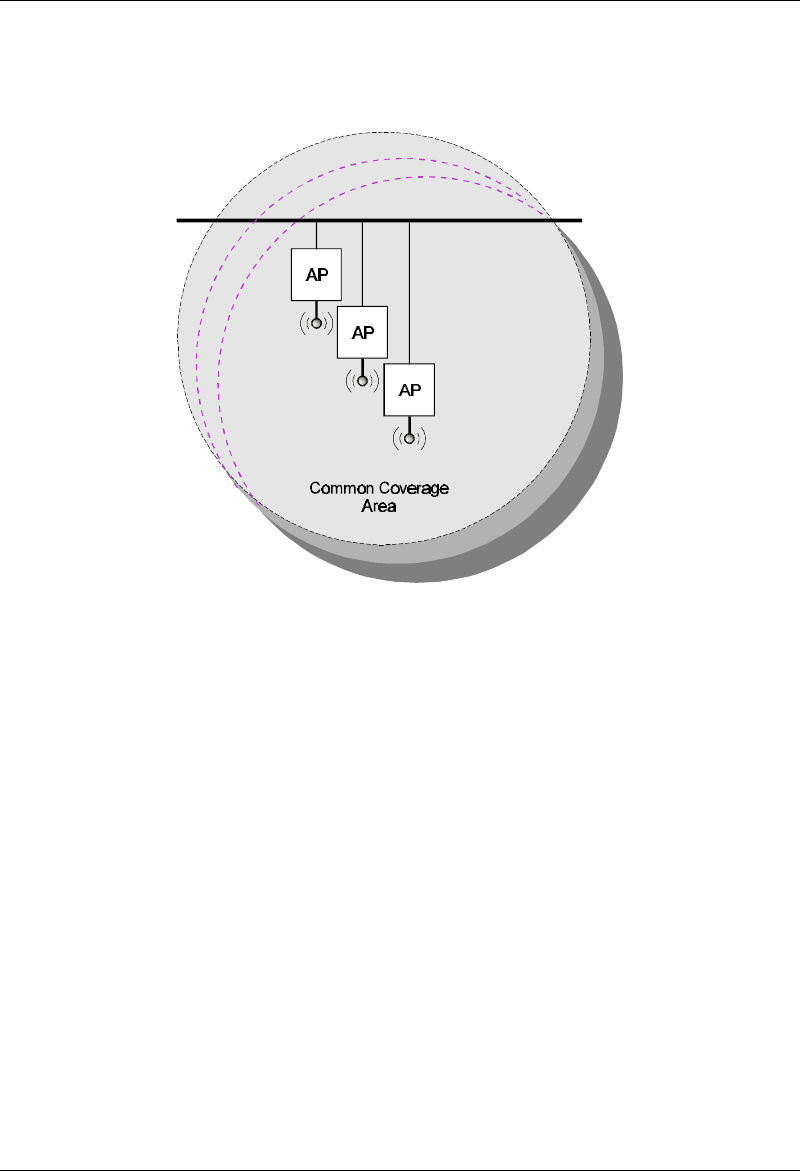
Appendix
BreezeNET PRO.11 Series 9-13 User’s Guide
equally share the load between all APs. Efficiency is maximized because all
APs are working at the same low level load. Load balancing is also known
as load sharing.
Figure 9.5: The Common Coverage Area of a Multi-cell Structure
Dynamic Rate Switching
The data rate of each station is automatically adjusted according to the
received signal quality. Performance (throughput) is maximized by
increasing the data rate and decreasing re-transmissions. This is very
important for mobile applications where the signal quality fluctuates
rapidly, but less important for fixed outdoor installations where signal
quality is stable.
Media Access
When many users are located in the same area, performance becomes an
issue. To address this issue, wireless LANs use the Carrier Sense Multiple
Access (CSMA) algorithm with a Collision Avoidance (CA) mechanism in
which each unit senses the medium before it starts to transmit.

Appendix
BreezeNET PRO.11 Series 9-14 User’s Guide
If the medium is free for several microseconds, the unit can transmit for a
limited time. If the medium is busy, the unit will back off for a random time
before it senses again. Since transmitting units compete for air time, the
protocol should ensure equal fairness between the stations.
Fragmentation
Fragmentation of packets into shorter fragments adds protocol overhead and
reduces protocol efficiency when no errors are expected, but reduces the
time spent on re-transmissions if errors are likely to occur. No
fragmentation or longer fragment length adds overhead and reduces
efficiency in case of errors and re-transmissions (multi-path).
Collision Avoidance
To avoid collisions with other incoming calls, each station transmits a short
RTS (Request To Send) frame before the data frame. The Access Point
sends back a CTS (Clear To Send) frame with permission to start the data
transmission. This frame includes the time that this station is going to
transmit. This frame is received by all the stations in the cell, notifying them
that another unit will transmit during the following Xmsec, so they can not
transmit even if the medium seems to be free (the transmitting unit is out of
range).
Channelization
Using Frequency Hopping Spread Spectrum (FHSS), different hopping
sequences are assigned to different co-located cells. Hopping sequences are
designed so different cells can work simultaneously using different
channels.
Since hopping sequences and hopping timing of different cells cannot be
synchronized (according to FCC regulations), different cells might try to use
the same channel occasionally. Then, one cell uses the channel while the
other cell backs off and waits for the next hop. In the case of a very noisy
environment (multiples and interference), the system must hop quickly. If
the link is quiet and clean, it is better to hop slowly, reducing overhead and
increasing efficiency.
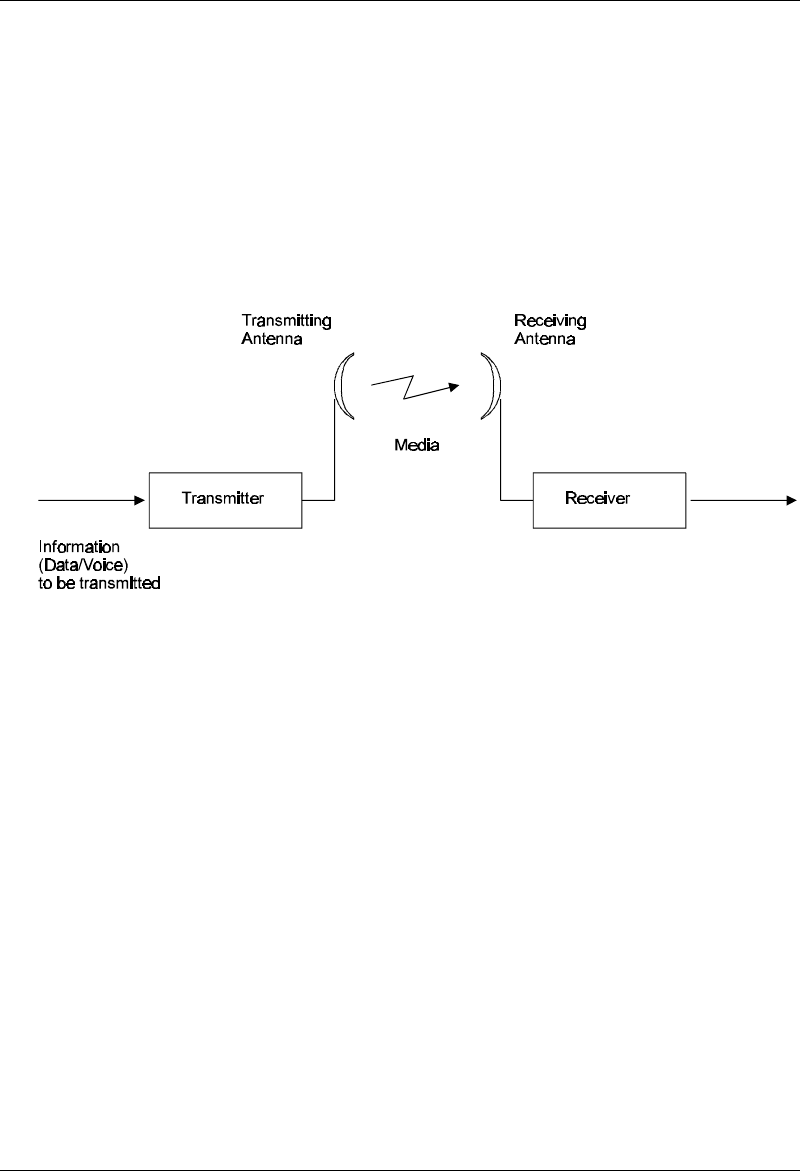
Appendix
BreezeNET PRO.11 Series 9-15 User’s Guide
9.4. Radio Signal Propagation
9.4.1. Introduction
This section explains and simplifies many of the terms relating to antennas
and RF (Radio Frequency) used when dealing with an RF installation
system.
The following diagram depicts a typical radio system:
Figure 9.6: A Typical Radio System
A radio system transmits information to the transmitter. The information is
transmitted through an antenna which converts the RF signal into an
electromagnetic wave. The transmission medium for electromagnetic wave
propagation is free space.
The electromagnetic wave is intercepted by the receiving antenna which
converts it back to an RF signal. Ideally, this RF signal is the same as that
originally generated by the transmitter. The original information is then
demodulated back to its original form.
9.4.2. RF Terms and Definitions
dB
The dB convention is an abbreviation for decibels. It is a mathematical
expression showing the relationship between two values.
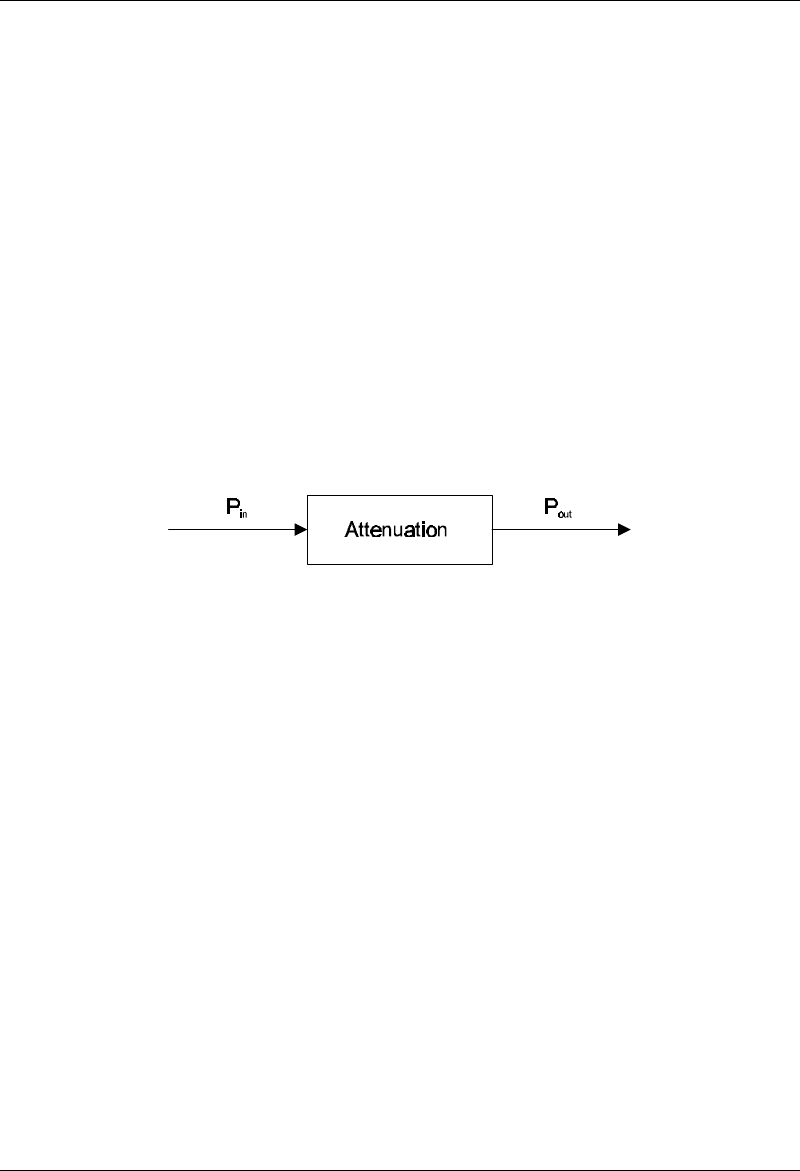
Appendix
BreezeNET PRO.11 Series 9-16 User’s Guide
RF Power Level
RF power level at either the transmitter output or the receiver input is
expressed in Watts. It can also be expressed in dBm. The relation between
dBm and Watts can be expressed as follows:
PdBm = 10 x Log Pmw
For example: 1 Watt = 1000 mW; PdBm = 10 x Log 1000 = 30 dBm
100 mW; PdBm = 10 x Log 100 = 20 dBm
For link budget calculations, the dBm convention is more convenient than
the Watts convention.
Attenuation
Attenuation (fading) of an RF signal is defined as follows:
Figure 9.7: Attenuation of an RF signal
Pin is the incident power level at the attenuator input
Pout is the output power level at the attenuator output
Attenuation is expressed in dB as follows:
PdB = -10 x Log (Pout/Pin)
For example: If, due to attenuation, half the power is lost (Pout/Pin = 1/2),
attenuation in dB is -10 x Log (1/2) = 3dB
Path Loss
Loss of power of an RF signal travelling (propagating) through space. It is
expressed in dB. Path loss depends on:
• The distance between transmitting and receiving antennas
• Line of sight clearance between the receiving and transmitting antennas
• Antenna height

Appendix
BreezeNET PRO.11 Series 9-17 User’s Guide
Free Space Loss
Attenuation of the electromagnetic wave while propagating through space.
This attenuation is calculated using the following formula:
Free space loss = 32.4 + 20xLog(FMhz) + 20xLog(RKm)
F is the RF frequency expressed in Mhz.
R is the distance between the transmitting and receiving antennas.
At 2.4 Ghz, this formula is: 100+20xLog(RKm)
Antenna Characteristics
Isotropic Antenna
A hypothetical, lossless antenna having equal radiation intensity in all
directions. Used as a zero dB gain reference in directivity calculation (gain).
Antenna Gain
A measure of directivity. It is defined as the ratio of the radiation intensity
in a given direction to the radiation intensity that would be obtained if the
power accepted by the antenna was radiated equally in all directions
(isotropically). Antenna gain is expressed in dBi.
Radiation Pattern
A graphical representation in either polar or rectangular coordinates of the
spatial energy distribution of an antenna.
Side Lobes
The radiation lobes in any direction other than that of the main lobe.
Omni-directional Antenna
Radiates and receives equally in all directions in azimuth. The following
diagram shows the radiation pattern of an omnidirectional antenna with its
side lobes in polar form.
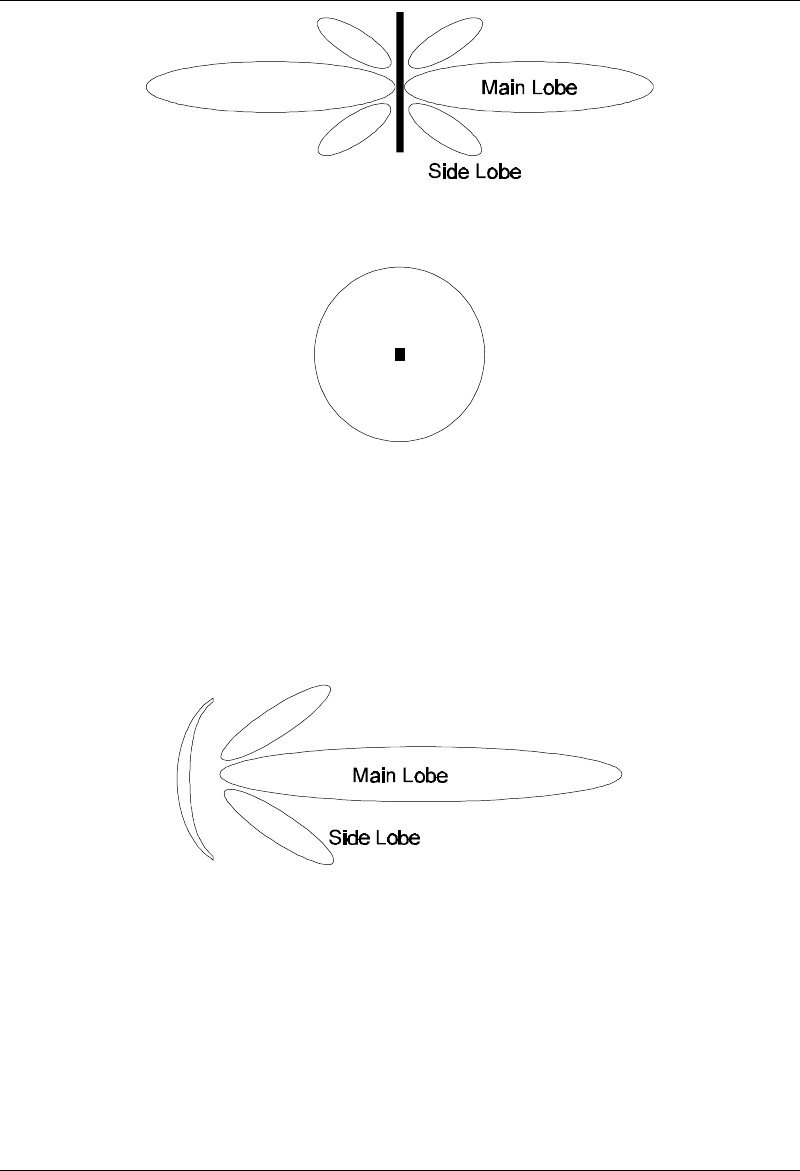
Appendix
BreezeNET PRO.11 Series 9-18 User’s Guide
Figure 9.8: Side View
Figure 9.9: Top View
Directional Antenna
Radiates and receives most of the signal power in one direction. The
following diagram shows the radiation pattern of a directional antenna with
its side lobes in polar form:
Figure 9.10: Radiation Pattern of Directional Antenna
Antenna Beamwidth
The directiveness of a directional antenna. Defined as the angle between two
half-power (-3 dB) points on either side of the main lobe of radiation.

Appendix
BreezeNET PRO.11 Series 9-19 User’s Guide
System Characteristics
Receiver Sensitivity
The minimum RF signal power level required at the input of a receiver for
certain performance (e.g. BER).
EIRP (Effective Isotropic Radiated Power)
The antenna transmitted power. Equal to the transmitted output power
minus cable loss plus the transmitting antenna gain.
Pout Output power of transmitted in dBm
Ct Transmitter cable attenuation in dB
Gt Transmitting antenna gain in dBi
Gr Receiving antenna gain in dBi
Pl Path loss in dB
Cr Receiver cable attenuation is dB
Si Received power level at receiver input in dBm
Ps Receiver sensitivity is dBm
Si = Pout - Ct + Gt - Pl + Gr - Cr
EIRP = Pout - Ct + Gt
Example:
Link Parameters:
Frequency: 2.4 Ghz
Pout = 4 dBm (2.5 mW)
Tx and Rx cable length (Ct and Cr) = 10 m. cable type RG214 (0.6 dB/meter)
Tx and Rx antenna gain (Gt and Gr) = 18 dBi
Distance between sites = 3 Km
Receiver sensitivity (Ps) = -84 dBm
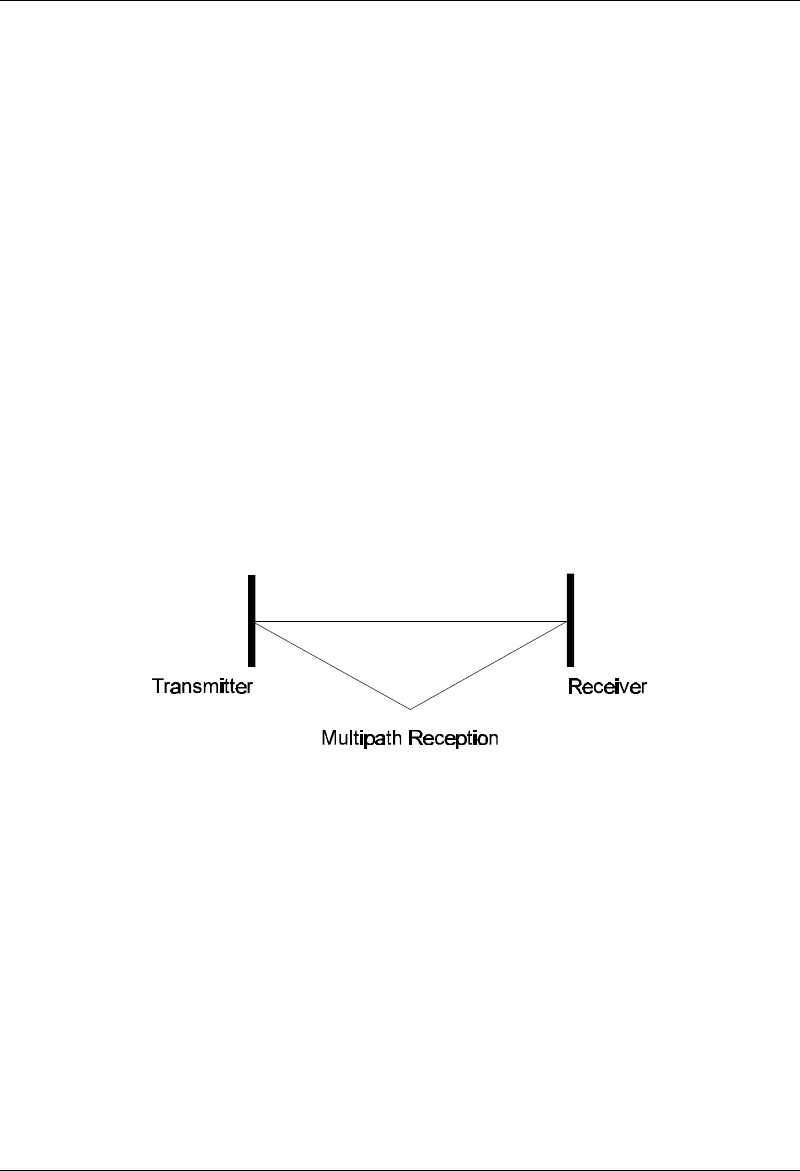
Appendix
BreezeNET PRO.11 Series 9-20 User’s Guide
Link Budget Calculation
EIRP = Pout - Ct + Gt = 16 dBm
Pl = 32.4 + 20xLog(FMhz) + 20xLog(RKm) ≅ 110 dB
Si = EIRP - Pl + Gr - Cr = -82 dBm
In conclusion, the received signal power is above the sensitivity threshold,
so the link should work. The problem is that there is only a 2 dB difference
between received signal power and sensitivity. Normally, a higher margin is
desirable due to fluctuation in received power as a result of signal fading.
Signal Fading
Fading of the RF signal is caused by several factors:
• Multipath
The transmitted signal arrives at the receiver from different directions, with
different path lengths, attenuation and delays. The summed signal at the
receiver may result in an attenuated signal.
Figure 9.11: Multipath Reception
• Bad Line of Sight
An optical line of sight exists if an imaginary straight line can connect
the antennas on either side of the link.
Radio wave clear line of sight exists if a certain area around the optical
line of sight (Fresnel zone) is clear of obstacles. A bad line of sight exists
if the first Fresnel zone is obscured.
• Link Budget Calculations
• Weather conditions (Rain, wind, etc.)
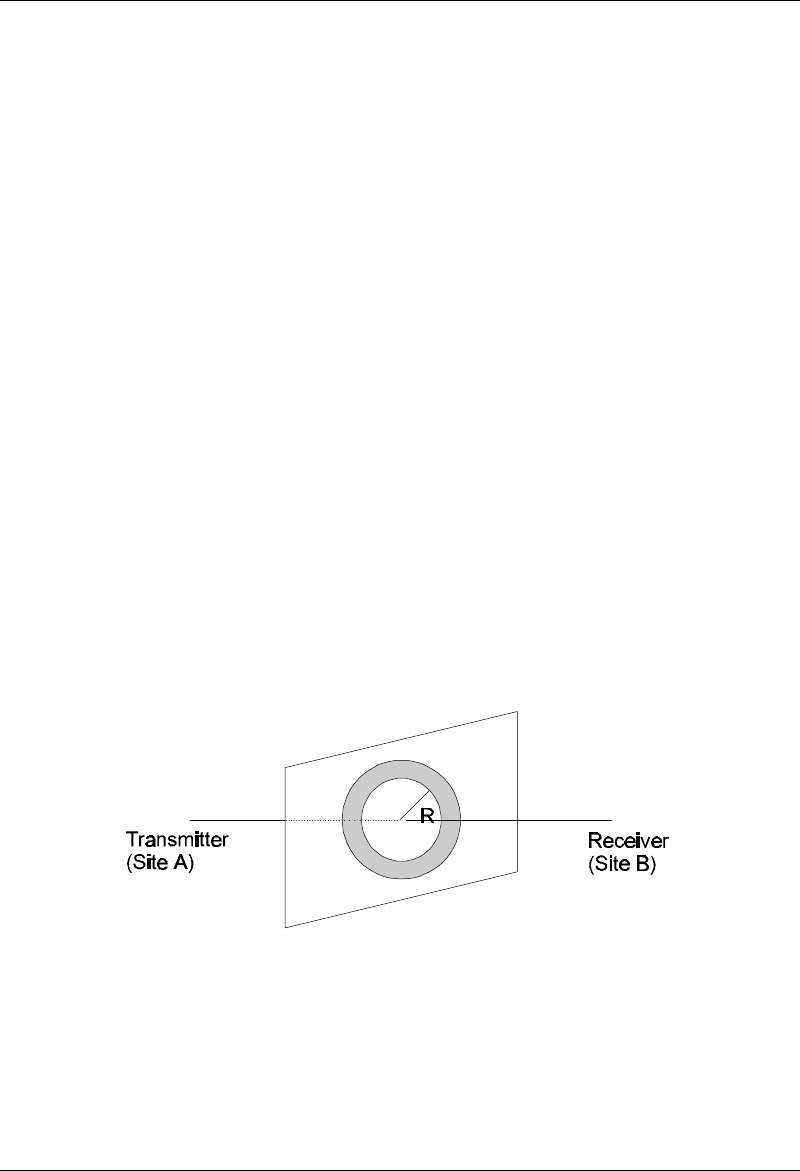
Appendix
BreezeNET PRO.11 Series 9-21 User’s Guide
At high rain intensity (150 mm/hr), the fading of an RF signal at 2.4 GHz
may reach a maximum of 0.02 dB/Km
Wind may cause fading due to antenna motion
• Interference
Interference may be caused by another system on the same frequency
range, external noise, or some other co-located system.
The Line of Sight Concept
An optical line of sight exists if an imaginary straight line can be drawn
connecting the antennas on either side of the link.
Clear Line of Sight
A clear line of sight exists when no physical objects obstruct viewing one
antenna from the location of the other antenna.
A radio wave clear line of sight exists if a defined area around the optical
line of sight (Fresnel Zone) is clear of obstacles.
Fresnel Zone
The Fresnel zone is the area of a circle around the line of sight.
The Fresnel Zone is defined as follows:
Figure 9.12: Fresnel Zone
R = ½ √ (λxD)
R: radius of the first Fresnel zone
λ: wavelength

Appendix
BreezeNET PRO.11 Series 9-22 User’s Guide
D: distance between sites
Figure 9.13: Fresnel Zone Clear of Obstacles
When at least 80% of the first Fresnel Zone is clear of obstacles,
propagation loss is equivalent to that of free space.
9.5. IEEE 802.11 Technical Tutorial
The purpose of this chapter is to give technical readers a basic overview of
the new IEEE 802.11 Standard, enabling them to understand the basic
concepts, principles of operation, and the reasons behind some of the
features and/or components of the Standard.
The document does not cover the entire Standard and does not provide
enough information for the reader to implement an 802.11-compliant device
(for this purpose the reader should refer to the Standard itself).
9.5.1. Architecture Components
An 802.11 LAN is based on a cellular architecture where the system is
subdivided into cells. Each cell (called Basic Service Set, or BSS, in the
802.11 nomenclature) is controlled by a Base Station (called Access Point
or, in short, AP).
Although a wireless LAN may be formed by a single cell, with a single
Access Point, (and as will be described later, it can also work without an
Access Point), most installations will be formed by several cells, where the
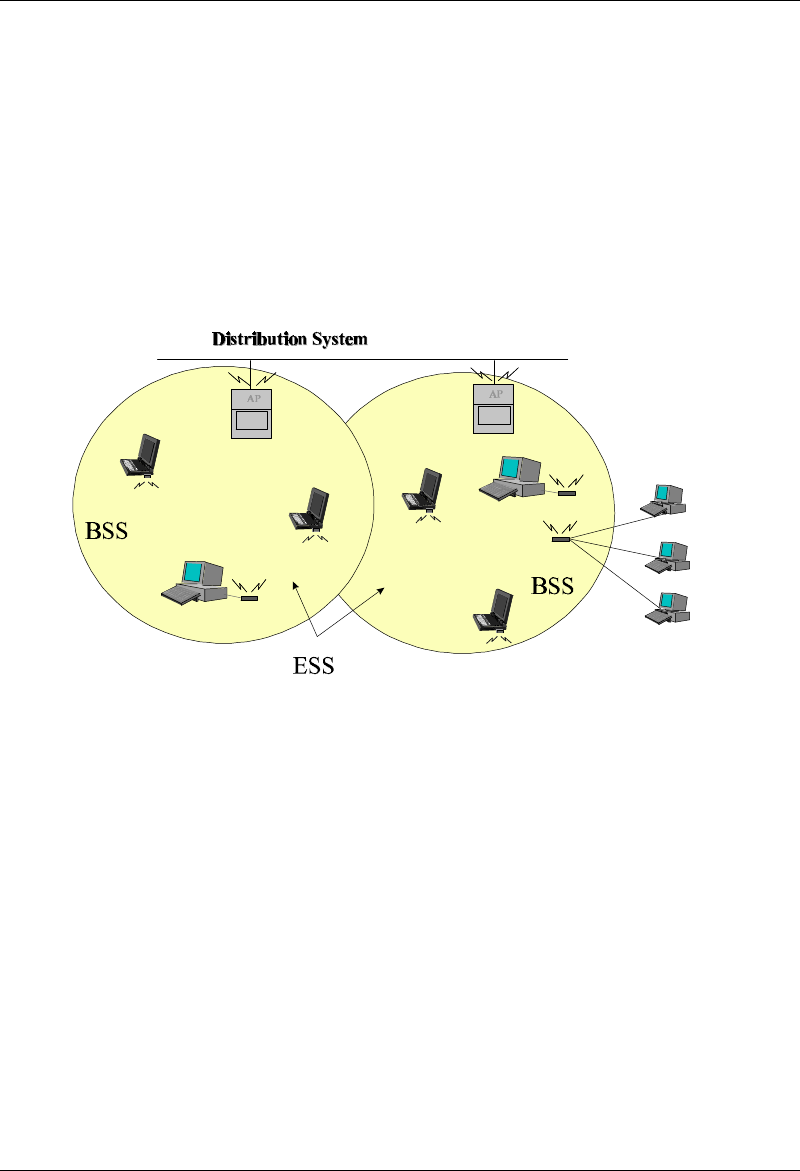
Appendix
BreezeNET PRO.11 Series 9-23 User’s Guide
Access Points are connected through some kind of backbone (called
Distribution System or DS). This backbone is typically Ethernet but, in
some cases, might be wireless itself.
The whole interconnected wireless LAN, including the different cells, their
respective Access Points and the Distribution System, is seen as a single 802
network to the upper layers of the OSI model and is known in the Standard
as the Extended Service Set (ESS).
The following diagram shows a typical 802.11 LAN including the
components described above:
Figure 9.14: Typical 802.11 LAN
The standard also defines the concept of a Portal. A portal is a device that
interconnects between an 802.11 and another 802 LAN. This concept is an
abstract description of part of the functionality of a “translation bridge”.
Even though the standard does not necessarily require it, typical installations
will have the AP and the Portal on a single physical entity. This is also the
case with BreezeCOM’s AP which provides both functions.
9.5.2. IEEE 802.11 Layers Description
As in any 802.x protocol, the 802.11 protocol covers the Media Access
Control Layer (MAC) and Physical Layer (PHY). The Standard currently
defines a single MAC which interacts with three PHYs (all of them running
at 1 or 2 Mbit/s) as follows:

Appendix
BreezeNET PRO.11 Series 9-24 User’s Guide
• Frequency Hopping Spread Spectrum (FHSS) in the 2.4 GHz Band
• Direct Sequence Spread Spectrum (DSSS) in the 2.4 GHz Band, and
• InfraRed
802.2
802.11 MAC
Data Link
Layer
FH DS IR PHY Layer
Beyond the standard functionality usually performed by MAC Layers, the
802.11 MAC performs other functions that are typically related to upper
layer protocols, such as Fragmentation, Packet Retransmissions, and
Acknowledges.
9.5.3. The MAC Layer
The MAC Layer defines two different access methods, the Distributed
Coordination Function and the Point Coordination Function:
9.5.3.1 The Basic Access Method: CSMA/CA
The basic access mechanism, called the Distributed Coordination
Function, is basically a Carrier Sense Multiple Access with Collision
Avoidance mechanism (known as CSMA/CA). CSMA protocols are well-
known in the industry, the most popular being Ethernet, which is a CSMA/
CD protocol (CD standing for Collision Detection).
A CSMA protocol works as follows: A station desiring to transmit senses
the medium. If the medium is busy (i.e. some other station is transmitting)
then the station defers its transmission to a later time. If the medium seems
free then the station is allowed to transmit.
These kinds of protocols are very effective when the medium is not heavily
loaded since it allows stations to transmit with minimum delay. But there is
always a chance of two or more stations simultaneously sensing the medium
as being free and transmitting at the same time, causing a collision.
These collision situations must be identified so the MAC layer can
retransmit the packet itself, not by the upper layers, to avoid significant
delay. In the Ethernet case, a collision is recognized by the transmitting
stations which listen while transmitting and go into a retransmission phase
based on an exponential random backoff algorithm.

Appendix
BreezeNET PRO.11 Series 9-25 User’s Guide
While these Collision Detection Mechanisms are a good idea on a wired
LAN, they cannot be used on a wireless LAN environment for two main
reasons:
1. Implementing a Collision Detection Mechanism would require the
implementation of a Full-Duplex radio capable of transmitting and
receiving at the same time, an approach that would increase the price
significantly.
2. In a wireless environment we cannot assume that all stations can hear
each other (a basic assumption of the Collision Detection scheme), and
the fact that a station wants to transmit and senses the medium as free
doesn’t necessarily mean that the medium is free around the receiver’s
area.
In order to overcome these problems, 802.11 uses a Collision Avoidance
(CA) mechanism together with a Positive Acknowledge scheme, as follows:
1. A station wanting to transmit senses the medium. If the medium is busy
then it delays. If the medium is free for a specified time (called Distrib-
uted Inter Frame Space (DIFS) in the standard), then the station is
allowed to transmit.
2. The receiving station checks the CRC of the received packet and sends
an acknowledgment packet (ACK). Receipt of the acknowledgment indi-
cates to the transmitter that no collision occurred. If the sender does not
receive the acknowledgment, then it retransmits the fragment until it
either receives acknowledgment or is thrown away after a given number
of retransmissions.
9.5.3.2 Virtual Carrier Sense
In order to reduce the probability of two stations colliding because they
cannot hear each other, the standard defines a Virtual Carrier Sense
mechanism:
A station wanting to transmit a packet first transmits a short control packet
called RTS (Request To Send), which includes the source, destination, and
the duration of the following transaction (i.e. the packet and the respective
ACK), the destination station responds (if the medium is free) with a
response control Packet called CTS (Clear to Send), which includes the
same duration information.
All stations receiving either the RTS or the CTS, set their Virtual Carrier
Sense indicator (called NAV, for Network Allocation Vector), for the
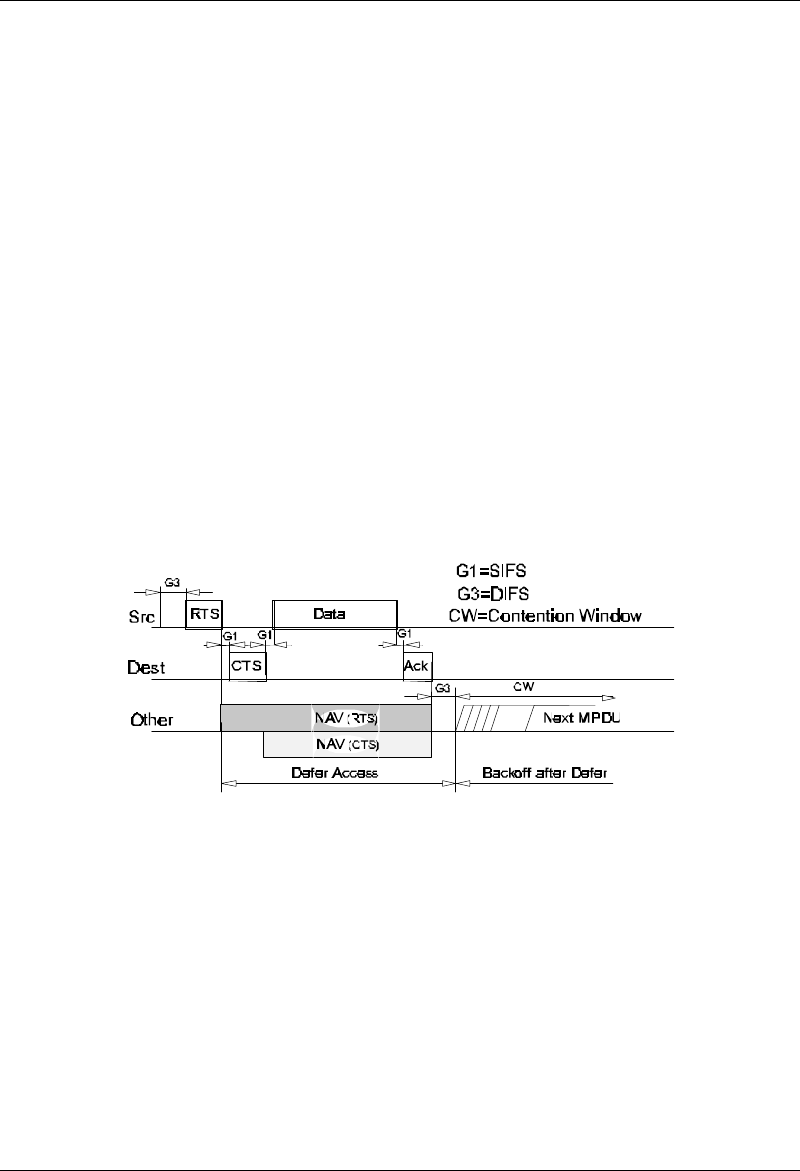
Appendix
BreezeNET PRO.11 Series 9-26 User’s Guide
given duration, and use this information together with the Physical Carrier
Sense when sensing the medium.
This mechanism reduces the probability of a collision on the receiver area
by a station that is “hidden” from the transmitter to the short duration of the
RTS transmission because the station hears the CTS and “reserves” the
medium as busy until the end of the transmission. The duration information
on the RTS also protects the transmitter area from collisions during the
ACK (from stations that are out of range of the acknowledging station).
It should also be noted that, due to the fact that the RTS and CTS are short
frames, the mechanism also reduces the overhead of collisions, since these
are recognized faster than if the whole packet was to be transmitted. (This is
true if the packet is significantly bigger than the RTS, so the standard allows
for short packets to be transmitted without the RTS/CTS transmission. This
is controlled per station by a parameter called RTS Threshold).
The following diagrams show an exchange between stations A and B, and
the NAV setting of their neighbors:
Figure 9.15: Transaction Between Stations A and B
The NAV State is combined with the physical carrier sense to indicate the
busy state of the medium.
9.5.3.3 MAC Level Acknowledgments
As mentioned earlier in this document, the MAC layer performs Collision
Detection by expecting the reception of an acknowledge to any transmitted
fragment (Packets that have more than one destination, such as Multicasts,
are not acknowledged.)

Appendix
BreezeNET PRO.11 Series 9-27 User’s Guide
9.5.3.4 Fragmentation and Reassembly
Typical LAN protocols use packets several hundred bytes long (the longest
Ethernet packet could be up to 1518 bytes long).
There are several reasons why it is preferable to use smaller packets in a
wireless LAN environment:
• Due to the higher Bit Error Rate of a radio link, the probability of a
packet getting corrupted increases with the packet size.
• In case of packet corruption (either due to collision or noise), the smaller
the packet, the less overhead it causes to retransmit it.
• On a Frequency Hopping system, the medium is interrupted periodically
for hopping (in our case every 20 milliseconds), so, the smaller the
packet, the smaller the chance that the transmission will be postponed
after dwell time.
However, it doesn’t make sense to introduce a new LAN protocol that
cannot deal with packets 1518 bytes long which are used on Ethernet, so the
committee decided to solve the problem by adding a simple fragmentation/
reassembly mechanism at the MAC Layer.
The mechanism is a simple Send-and-Wait algorithm, where the
transmitting station is not allowed to transmit a new fragment until one of
the following happens:
1. Receives an ACK for the said fragment, or
2. Decides that the fragment was retransmitted too many times and drops
the whole frame.
It should be noted that the standard does allow the station to transmit to a
different address between retransmissions of a given fragment. This is
particularly useful when an AP has several outstanding packets to different
destinations and one of them does not respond.
The following diagram shows a frame (MSDU) being divided to several
fragments (MPDUs):
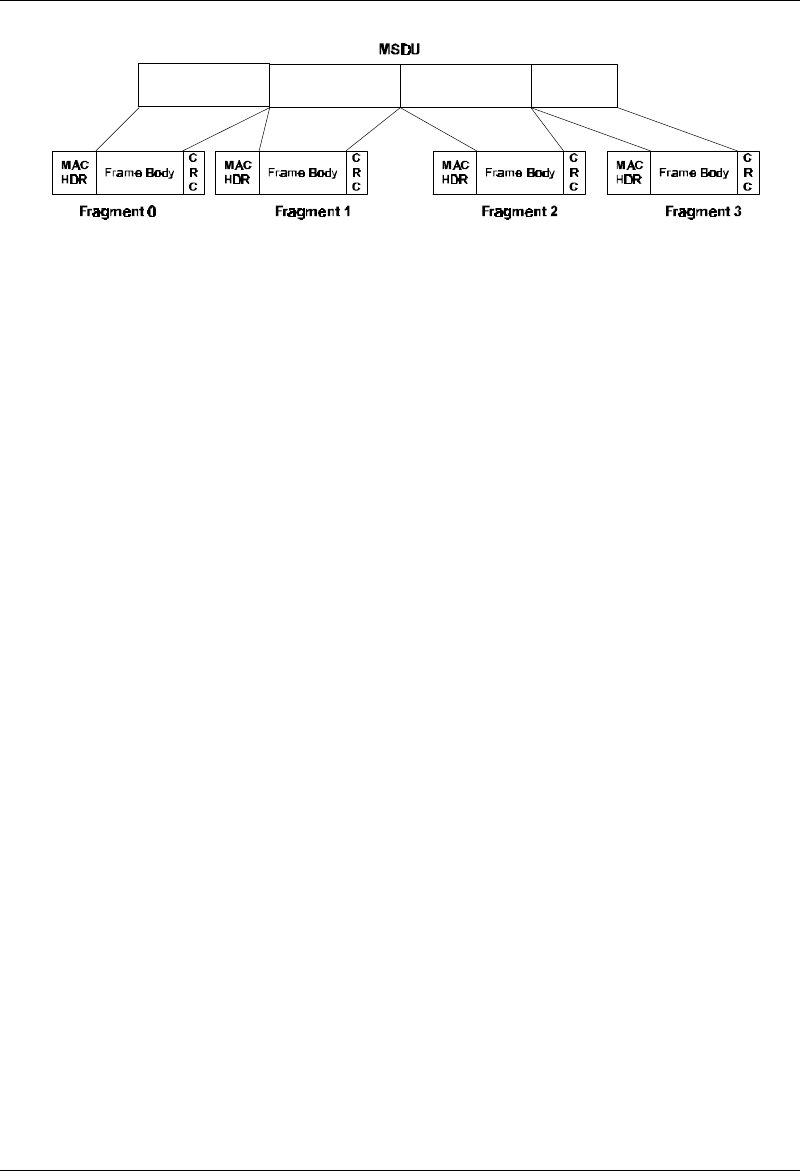
Appendix
BreezeNET PRO.11 Series 9-28 User’s Guide
Figure 9.16: Frame Fragmentation
9.5.3.5 Inter Frame Spaces
The Standard defines 4 types of Inter Frame Spaces, which are use to
provide different priorities:
• SIFS - Short Inter Frame Space, separates transmissions belonging to
a single dialog (e.g. Fragment-Ack), and is the minimum Inter Frame
Space. There is always at most one single station to transmit at any given
time, therefore giving it priority over all other stations.
This value is a fixed value per PHY and is calculated in such a way that
the transmitting station will be able to switch back to receive mode and
be capable of decoding the incoming packet. On the 802.11 FH PHY this
value is set to 28 microseconds
• PIFS - Point Coordination IFS, is used by the Access Point (or Point
Coordinator, as called in this case), to gain access to the medium before
any other station. This value is SIFS plus a Slot Time (defined in the fol-
lowing paragraph), i.e. 78 microseconds.
• DIFS - Distributed IFS, is the Inter Frame Space used for a station will-
ing to start a new transmission, which is calculated as PIFS plus one slot
time, i.e. 128 microseconds.
• EIFS - Extended IFS, which is a longer IFS used by a station that has
received a packet that it could not understand. This is needed to prevent
the station (which could not understand the duration information for the
Virtual Carrier Sense) from colliding with a future packet belonging to
the current dialog.
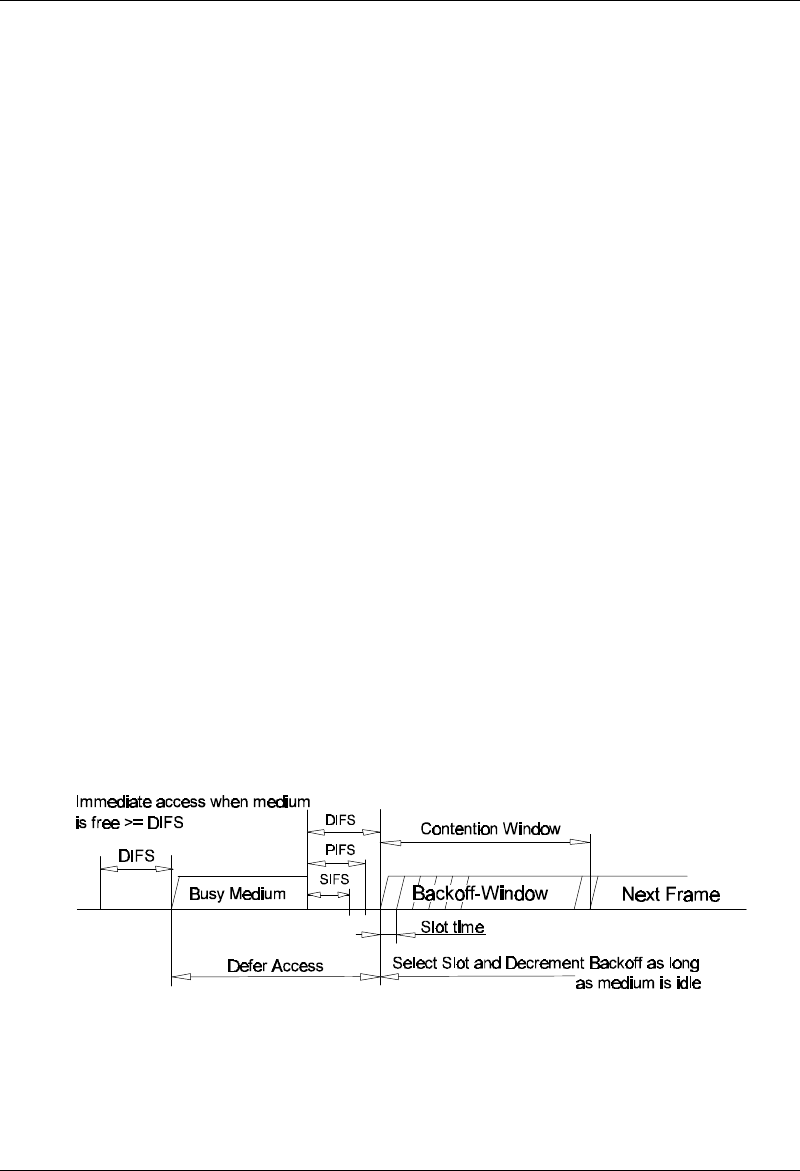
Appendix
BreezeNET PRO.11 Series 9-29 User’s Guide
9.5.3.6 Exponential Backoff Algorithm
Backoff is a well known method used to resolve contention between
different stations wanting to access the medium. The method requires each
station to choose a Random Number (n) between 0 and a given number, and
wait for this number of Slots before accessing the medium, always checking
if a different station has accessed the medium before.
The Slot Time is defined in such a way that a station will always be capable
of determining if another station has accessed the medium at the beginning
of the previous slot. This reduces collision probability by half.
Exponential Backoff means that each time the station chooses a slot and
happens to collide, it will increase the maximum number for the random
selection exponentially.
The 802.11 standard defines an Exponential Backoff Algorithm, that must
be executed in the following cases:
• When the station senses the medium before the first transmission of a
packet, and the medium is busy
• After each retransmission, and
• After a successful transmission
The only case when this mechanism is not used is when the station decides
to transmit a new packet and the medium has been free for more than DIFS.
The following figure shows a schematic of the access mechanism:
Figure 9.17: Access Mechanism

Appendix
BreezeNET PRO.11 Series 9-30 User’s Guide
9.5.4. How Does a Station Join an Existing Cell (BSS)?
When a station wants to access an existing BSS (either after power-up, sleep
mode, or just entering the BSS area), the station needs to get
synchronization information from the Access Point (or from the other
stations when in ad-hoc mode, which will be discussed later).
The station can get this information by one of two means:
1. Passive Scanning: In this case the station just waits to receive a Beacon
Frame from the AP, (the beacon frame is a frame sent out periodically
by the AP containing synchronization information), or
2. Active Scanning: In this case the station tries to locate an Access Point
by transmitting Probe Request Frames, and waits for Probe Response
from the AP.
Both methods are valid. A method is chosen according to the power
consumption/performance trade-off.
9.5.4.1 The Authentication Process
Once the station has located an Access Point, and decides to join its BSS, it
goes through the Authentication Process. This is the interchange of
information between the AP and the station, where each side proves the
knowledge of a given password.
9.5.4.2 The Association Process
Once the station is authenticated, it then starts the Association Process,
which is the exchange of information about the station and BSS capabilities,
and which allows the DSS (the set of APs) to know about the current
position of the station). A station is capable of transmitting and receiving
data frames only after the association process is completed.
9.5.5. Roaming
Roaming is the process of moving from one cell (or BSS) to another without
losing connection. This function is similar to the cellular phones’ handover,
with two main differences:
1. On a packet-based LAN system, the transition from cell to cell may be
performed between packet transmissions, as opposed to telephony where
the transition may occur during a phone conversation, this makes the
LAN roaming a little easier, but

Appendix
BreezeNET PRO.11 Series 9-31 User’s Guide
2. On a voice system, a temporary disconnection may not affect the conver-
sation, while in a packet-based environment it significantly reduces per-
formance because retransmission is then performed by the upper layer
protocols.
The 802.11 standard does not define how roaming should be performed, but
defines the basic tools. These include active/passive scanning, and a re-
association process, where a station which is roaming from one Access
Point to another becomes associated with the new one1.
9.5.6. Keeping Synchronization
Stations need to keep synchronization, which is necessary for keeping
hopping synchronized, and other functions like Power Saving. On an
infrastructure BSS, this is achieved by all the stations updating their clocks
according to the AP’s clock, using the following mechanism:
The AP periodically transmits frames called Beacon Frames. These frames
contain the value of the AP’s clock at the moment of transmission (note that
this is the moment when transmission actually occurs, and not when it is put
in the queue for transmission. Since the Beacon Frame is transmitted using
CSMA rules, transmission may be delayed significantly).
The receiving stations check the value of their clocks at the moment the
signal is received, and correct it to keep in synchronization with the AP’s
clock. This prevents clock drifting which could cause loss of synch after a
few hours of operation.
9.5.7. Security
Security is one of the first concerns that people have when deploying a
wireless LAN. The 802.11 committee has addressed the issue by providing
what is called WEP (Wired Equivalent Privacy).
Users are primarily concerned that an intruder should not be able to:
• Access the Network resources by using similar wireless LAN equipment
• Capture wireless LAN traffic (eavesdropping)
1The BreezeNET product line provides a patented enhanced roaming mechanism which allows stations to
roam at speeds of 60 Km/h without losing or duplicating packets.

Appendix
BreezeNET PRO.11 Series 9-32 User’s Guide
9.5.7.1 Preventing Access to Network Resources
This is done by the use of an Authentication mechanism where a station
needs to prove knowledge of the current key. This is very similar to Wired
LAN privacy, in the sense that an intruder needs to enter the premises (by
using a physical key) in order to connect his workstation to the wired LAN.
9.5.7.2 Eavesdropping
Eavesdropping is prevented by using the WEP algorithm which is a Pseudo
Random Number Generator initialized by a shared secret key. This PRNG
outputs a key sequence of pseudo-random bits equal in length to the largest
possible packet which is combined with the outgoing/incoming packet
producing the packet transmitted in the air.
The WEP is a simple algorithm based on RSA’s RC4 which has the
following properties:
• Reasonably strong:
Brute-force attack to this algorithm is difficult because every frame is
sent with an Initialization Vector which restarts the PRNG for each
frame.
• Self Synchronizing:
The algorithm re-synchronizes for each message. This is necessary in
order to work in a connection-less environment, where packets may get
lost (as any LAN).
9.5.8. Power Saving
Wireless LANs are typically related to mobile applications. In this type of
application, battery power is a scare resource. This is the reason why the
802.11 standard directly addresses the issue of Power Saving and defines an
entire mechanism which enables stations to go into sleep mode for long
periods of time without losing information.
The main idea behind the Power Saving Mechanism is that the AP
maintains a continually updated record of the stations currently working in
Power Saving mode, and buffers the packets addressed to these stations
until either the stations specifically request the packets by sending a polling
request, or until they change their operation mode.
As part of its Beacon Frames, the AP also periodically transmits information
about which Power Saving Stations have frames buffered at the AP, so these

Appendix
BreezeNET PRO.11 Series 9-33 User’s Guide
stations wake up in order to receive the Beacon Frame. If there is an
indication that there is a frame stored at the AP waiting for delivery, then
the station stays awake and sends a Polling message to the AP to get these
frames.
Multicasts and Broadcasts are stored by the AP, and transmitted at a pre-
known time (each DTIM), when all Power Saving stations who wish to
receive this kind of frames are awake.
9.5.9. Frame Types
There are three main types of frames:
• Data Frames: which are used for data transmission
• Control Frames: which are used to control access to the medium (e.g.
RTS, CTS, and ACK), and
• Management Frames: which are frames that are transmitted in the same
manner as data frames to exchange management information, but are not
forwarded to upper layers (e.g. beacon frames).
Each frame type is subdivided into different Subtypes, according to its
specific function.
9.5.10. Frame Formats
All 802.11 frames are composed of the following components:
Preamble PLCP Header MAC Data CRC
9.5.10.1 Preamble
This is PHY dependent, and includes:
• Synch: An 80-bit sequence of alternating zeros and ones, which is used
by the PHY circuitry to select the appropriate antenna (if diversity is
used), and to reach steady-state frequency offset correction and
synchronization with the received packet timing.
• SFD: A Start Frame delimiter which consists of the 16-bit binary pattern
0000 1100 1011 1101, which is used to define frame timing.
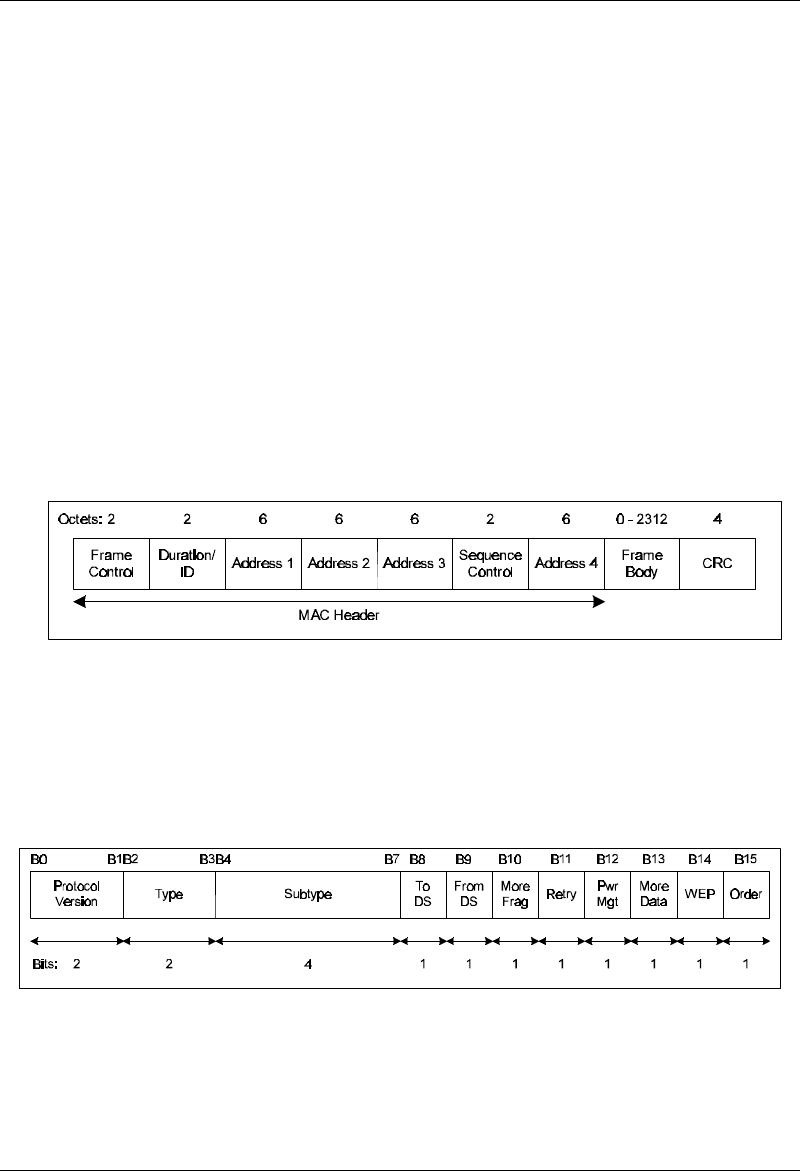
Appendix
BreezeNET PRO.11 Series 9-34 User’s Guide
9.5.10.2 PLCP Header
The PLCP Header is always transmitted at 1 Mbit/s and contains Logical
information used by the PHY Layer to decode the frame. It consists of:
• PLCP_PDU Length Word: which represents the number of bytes con-
tained in the packet. This is useful for the PHY to correctly detect the
end of packet.
• PLCP Signaling Field: which currently contains only the rate informa-
tion, encoded in 0.5 Mbps increments from 1 Mbit/s to 4.5 Mbit/s.
• Header Error Check Field: Which is a 16 Bit CRC error detection
field.
9.5.10.3 MAC Data
The following figure shows the general MAC Frame Format. Part of the
fields are only present in part of the frames as described later.
Figure 9.18: MAC Frame Format
Frame Control Field
The Frame Control field contains the following information:
Figure 9.19: Frame Control Field
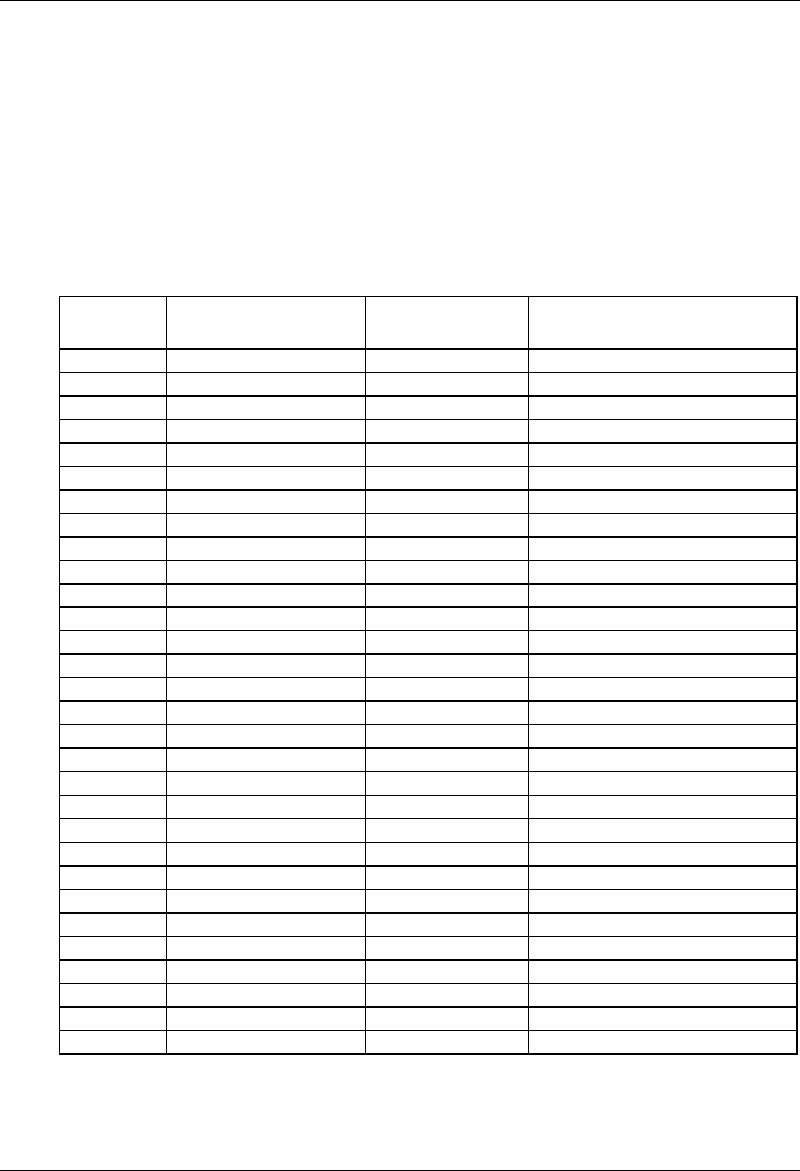
Appendix
BreezeNET PRO.11 Series 9-35 User’s Guide
Protocol Version
This field consists of 2 bits which are invariant in size and placement across
following versions of the 802.11 Standard, and will be used to recognize
possible future versions. In the current version of the standard the value is
fixed as 0.
Type and Subtype
These 6 bits define the Type and SubType of the frame as indicated in the
following table:
Type Value
b3 b2
Type Description Subtype Value
b7 b6 b5 b4
Subtype Description
00 Management 0000 Association Request
00 Management 0001 Association Response
00 Management 0010 Association Request
00 Management 0011 Reassociation Response
00 Management 0100 Probe Request
00 Management 0101 Probe Response
00 Management 0110-0111 Reserved
00 Management 1000 Beacon
00 Management 1001 ATIM
00 Management 1010 Disassociation
00 Management 1011 Authentication
00 Management 1100 Deauthentication
00 Management 1101-1111 Reserved
01 Control 0000-0001 Reserved
01 Control 1010 PS-Poll
01 Control 1011 RTS
01 Control 1100 CTS
01 Control 1101 ACK
01 Control 1110 CF End
01 Control 1111CF End + CF-ACK
10 Data 0000 Data
10 Data 0001 Data + CF-Ack
10 Data 0010 Data + CF-Poll
10 Data 0011 Data + CF-ACK + CF-Poll
10 Data 0100 Null Function (no data)
10 Data 0101 CF-Ack (no data)
10 Data 0110 CF-Poll (no data)
10 Data 0111 CF-Ack + CF-Poll (no data)
10 Data 1000-1111 Reserved
10 Data 0000-1111 Reserved
ToDS

Appendix
BreezeNET PRO.11 Series 9-36 User’s Guide
This bit is set to 1 when the frame is addressed to the AP for forwarding to
the Distribution System (including the case where the destination station is
in the same BSS, and the AP is to relay the frame).
The Bit is set to 0 in all other frames.
FromDS
This bit is set to 1 when the frame is received from the Distribution System.
More Fragments
This bit is set to 1 when there are more fragments belonging to the same
frame following the current fragment.
Retry
This bit indicates that this fragment is a retransmission of a previously
transmitted fragment. This is used by the receiver station to recognize
duplicate transmissions of frames that may occur when an Acknowledgment
packet is lost.
Power Management
This bit indicates the Power Management mode that the station will be in
after the transmission of this frame. This is used by stations which are
changing state either from Power Save to Active or vice versa.
More Data
This bit is used for Power Management as well as by the AP to indicate that
there are more frames buffered for this station. The station may decide to
use this information to continue polling or even changing to Active mode.
WEP
This bit indicates that the frame body is encrypted according to the WEP
algorithm
Order
This bit indicates that this frame is being sent using the Strictly-Ordered
service class.2
2 The Strictly-Ordered Service Class is defined for users that cannot accept change of ordering between Uni-
cast Frames and Multicast Frames (ordering of Unicast frames to a specific address is always maintained).

Appendix
BreezeNET PRO.11 Series 9-37 User’s Guide
Duration/ID
This field has two meanings depending on the frame type:
• In Power-Save Poll messages this is the Station ID
• In all other frames this is the duration value used for the NAV
Calculation.
Address Fields
A frame may contain up to 4 Addresses depending on the ToDS and
FromDS bits defined in the Control Field, as follows:
• Address-1 is always the Recipient Address (i.e. the BSS station that is
the immediate recipient of the packet). If ToDS is set, this is the AP
Address; if ToDS is not set, then this is the address of the end-station.
• Address-2 is always the Transmitter Address (i.e. the station which is
physically transmitting the packet). If FromDS is set, this is the AP
address; if it is not set, then it is the Station address.
• Address-3 is in most cases the remaining, missing address. On a frame
with FromDS set to 1, Address-3 is the original Source Address; if the
frame has the ToDS set, then Address 3 is the destination Address.
• Address-4 is used in special cases where a Wireless Distribution System
is used, and the frame is being transmitted from one Access Point to
another. In such cases, both the ToDS and FromDS bits are set, so both
the original Destination and the original Source Addresses are missing.
The following Table summarizes the usage of the different Addresses
according to ToDS and FromDS bits setting:
To DS From
DS Address
1Address
2Address
3Address
4
0 0 DA SA BSSID N/A
0 1 DA BSSID SA N/A
1 0 BSSID SA DA N/A
1 1 RA TA DA SA
The only known protocol that would need this service class is DEC’s LAT.
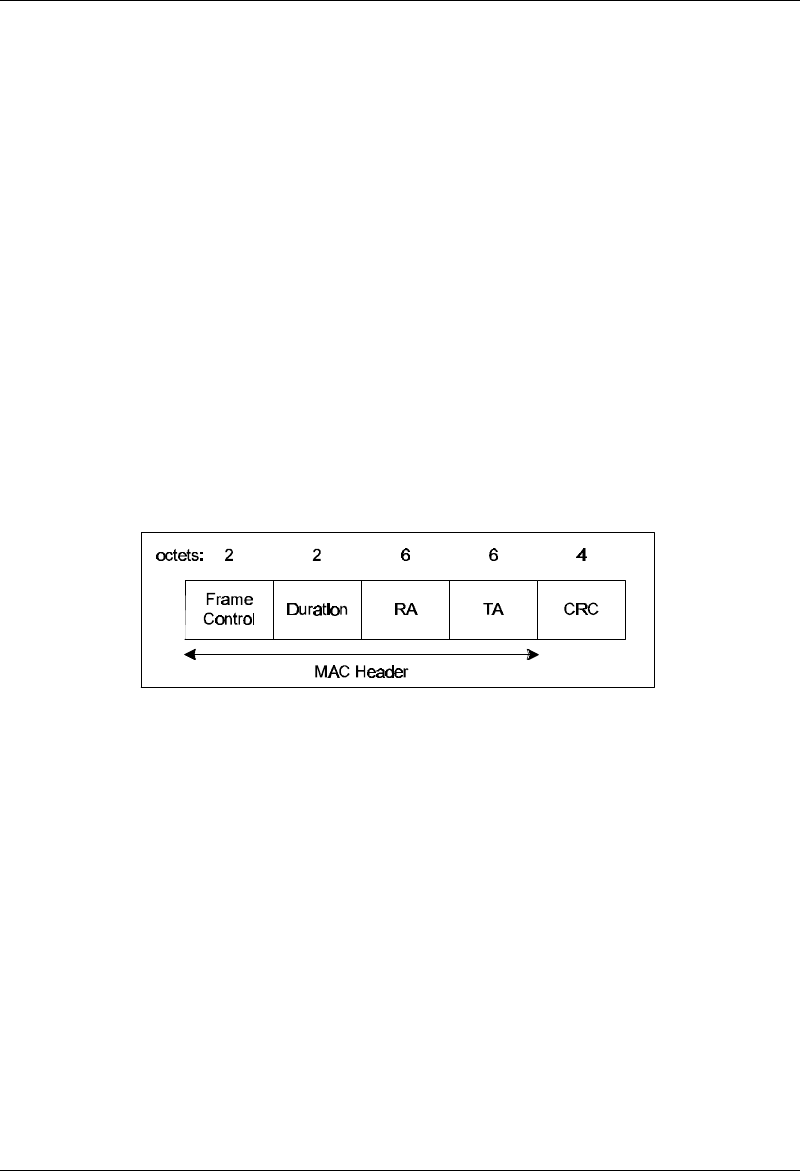
Appendix
BreezeNET PRO.11 Series 9-38 User’s Guide
Sequence Control
The Sequence Control Field is used to represent the order of different
fragments belonging to the same frame, and to recognize packet
duplications. It consists of two subfields, Fragment Number and Sequence
Number, which define the frame and the number of the fragment in the
frame.
CRC
The CRC is a 32-bit field containing a 32-bit Cyclic Redundancy Check
(CRC)
9.5.11. Most Common Frame Formats
9.5.11.1 RTS Frame Format
The RTS frame looks as follows:
Figure 9.20: RTS Frame Format
The RA of the RTS frame is the address of the STA on the wireless medium
that is the intended immediate recipient of the next Data or Management
frame.
The TA is the address of the STA transmitting the RTS frame.
The Duration value is the time, in microseconds, required to transmit the
next Data or Management frame, plus one CTS frame, plus one ACK frame,
plus three SIFS intervals.
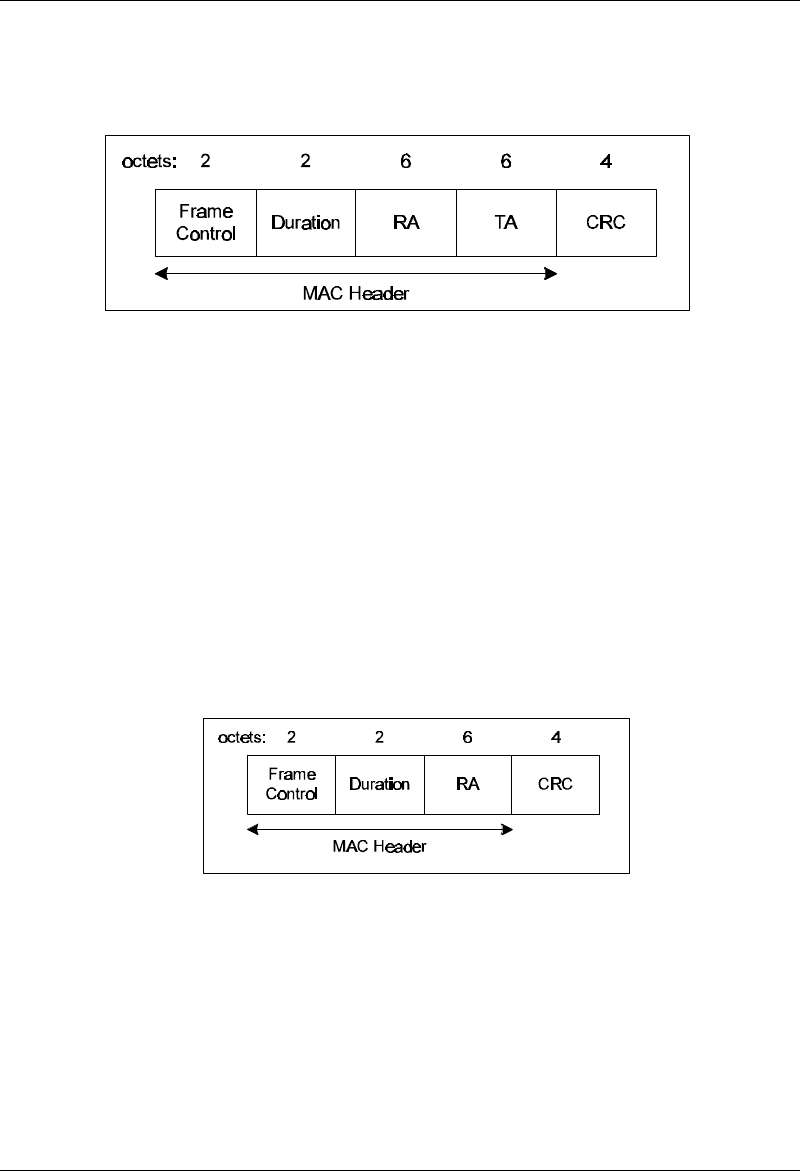
Appendix
BreezeNET PRO.11 Series 9-39 User’s Guide
9.5.11.2 CTS Frame Format
The CTS frame looks as follows:
Figure 9.21: CTS Frame
The Receiver Address (RA) of the CTS frame is copied from the
Transmitter Address (TA) field of the immediately previous RTS frame to
which the CTS is a response.
The Duration value is the value obtained from the Duration field of the
immediately previous RTS frame, minus the time, in microseconds, required
to transmit the CTS frame and its SIFS interval.
9.5.11.3 ACK Frame Format
The ACK frame looks as follows:
Figure 9.22: ACK Frame Format
The Receiver Address of the ACK frame is copied from the Address 2 field
of the immediately previous frame.
If the More Fragment bit was set to 0 in the Frame Control field of the
previous frame, the Duration value is set to 0, otherwise the Duration value
is obtained from the Duration field of the previous frame, minus the time, in
microseconds, required to transmit the ACK frame and its SIFS interval.

Appendix
BreezeNET PRO.11 Series 9-40 User’s Guide
9.5.12. Point Coordination Function (PCF)
Beyond the basic Distributed Coordination Function, there is an optional
Point Coordination Function, which may be used to implement time-
bounded services, like voice or video transmission. This Point Coordination
Function makes use of the higher priority that the Access Point may gain by
the use of a smaller Inter Frame Space (PIFS).
By using this higher priority access, the Access Point issues polling requests
to the stations for data transmission, hence controlling medium access. To
still enable regular stations to access the medium, there is a provision that
the Access Point must leave enough time for Distributed Access in between
the PCF.
9.5.13. Ad-hoc Networks
In certain circumstances, the users may wish to build up wireless LAN
networks without an infrastructure (more specifically without an Access
Point). This may include file transfer between two notebook users,
co-workers meeting outside the office, etc.
The 802.11 Standard addresses this need by the definition of an “ad-hoc”
mode of operation. In this case, there is no Access Point and part of its
functionality is performed by the end-user stations (such as Beacon
Generation, synchronization, etc.). Other AP functions are not supported
(such as frame-relaying between two stations not in range, or Power
Saving).